Early Los Angeles Gas Stations
| Historical Photos of Early LA Gas Stations |
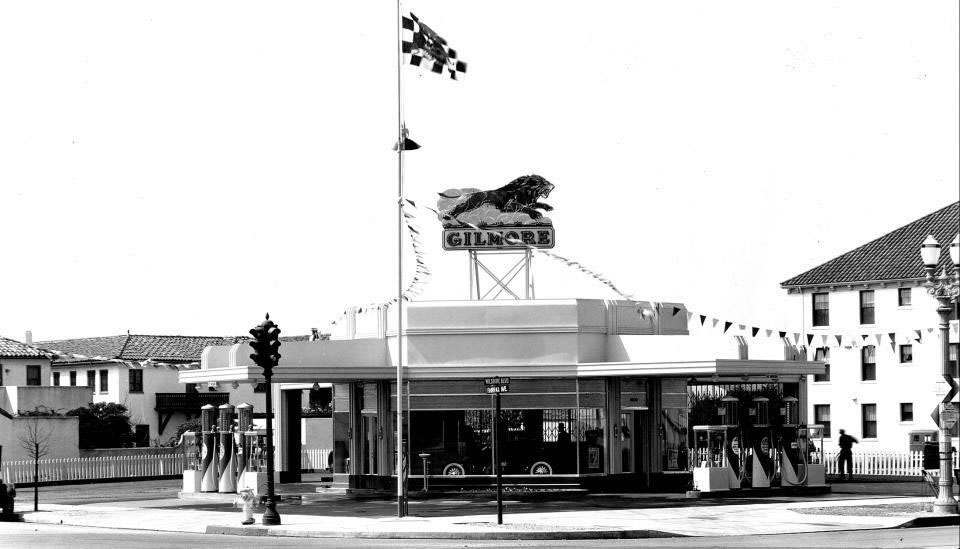 |
|
| (1930s)^^ – View looking at the SW corner of Wilshire and Fairfax showing a Gilmore gas station. The building on the right (The Carthay Apartments) is still standing. A 16-story high rise stands at this corner today. Click HERE to see more in Early Views of the Historic Wislhire and Fairfax Intersection. |
Historical Notes The Gilmore family is a longtime Los Angeles institution, having acquired the Rancho La Brea in the mid 19th century. In the early 20th century, oil discoveries on Gilmore land brought about a new fortune in petroleum. The Gilmore family went on to establish Farmers Market, which was built alongside the original Gilmore Adobe. They also established the Gilmore Bank, built Gilmore Field for the Hollywood Stars, a minor league baseball team, and also sponsored midget race cars on a small race track. Both the field and the racetrack were later replaced by CBS Television City. At one time there were more than 1,100 Gilmore Gas Statons throughout the West that sold only Gilmore products and another 2,400 that sold them along with other brands. The clear glass globes at the top of gas pumps allowed the color of the gasoline to be seen. E.B. Gilmore jumped on this unique opportunity to become the first oil company to market its gas by its color. Blu-Green and Red Lion Gas fueled the cars and imaginations of West Coasters from the ’20s to the early ’40s. |
* * * * * |
Westwood Service Stations
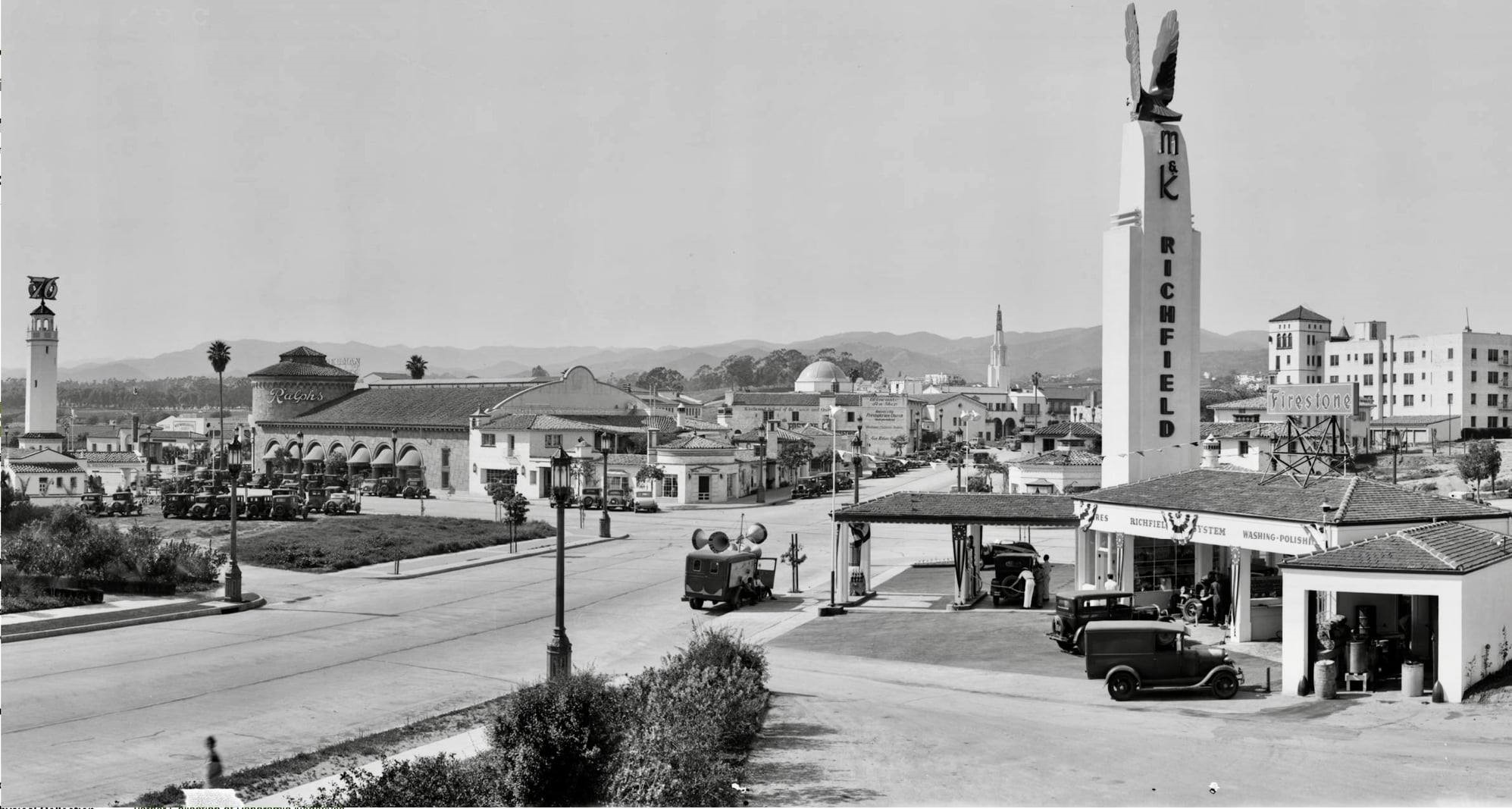 |
|
| (1934)^ – View looking north on Glendon Ave toward Lindbrook Drive showing several tower structures, two of which were for gas stations (Richfield on the right). Ralphs Market is on the left and in the distance can be seen the Janss Dome Building and the Fox Theatre tower. |
Historical Notes The towers in Westwood served to orient pedestrians within the Village, and were intended to catch the eye of motorists as they sped along in the “fast moving traffic” along Wilshire Boulevard.^ |
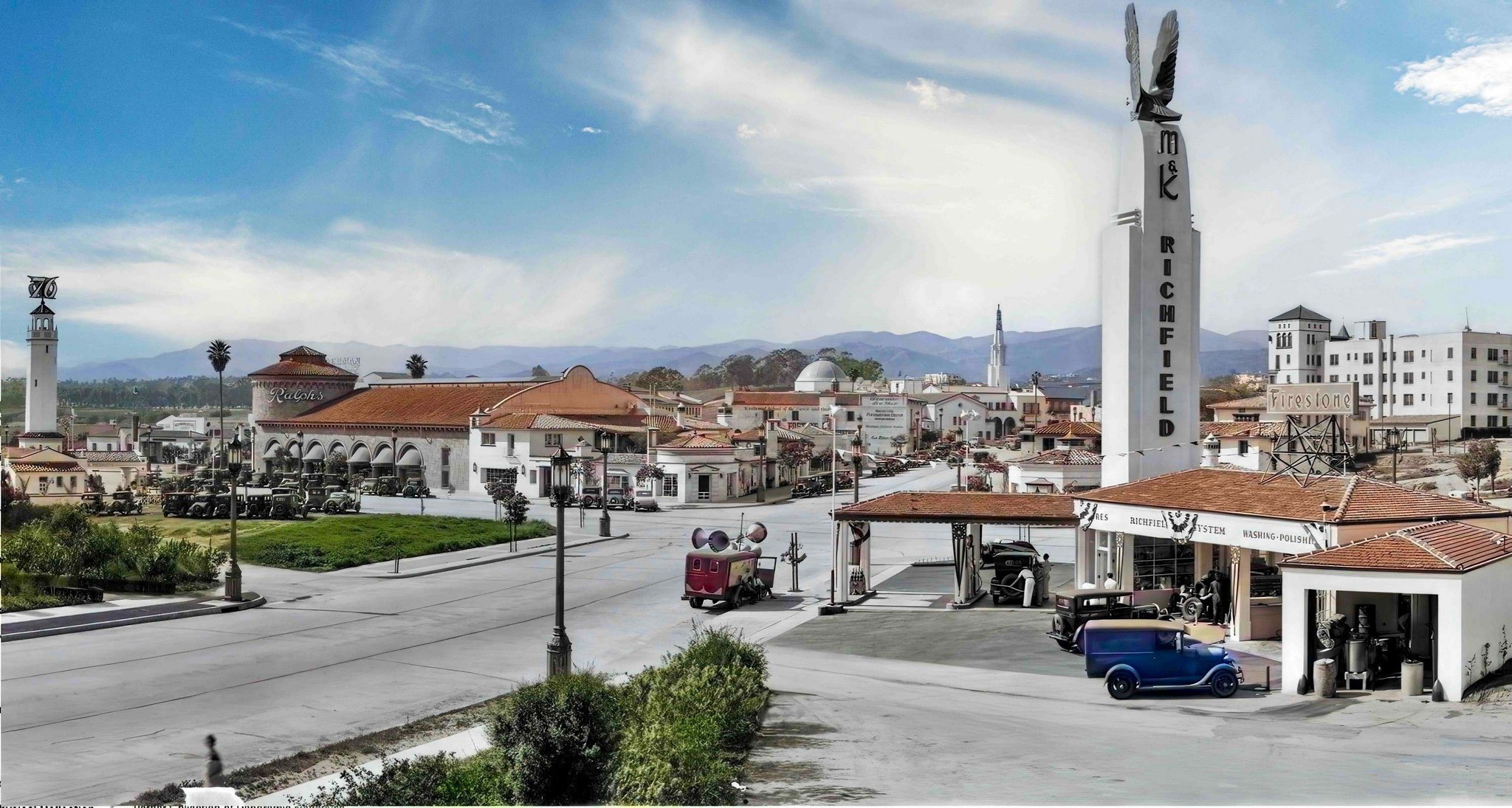 |
|
| (1934)^ – View looking north on Glendon Ave toward Lindbrook Drive showing several tower structures, two of which were for gas stations (Richfield on the right). Ralphs Market is on the left and in the distance can be seen the Janss Dome Building and the Fox Theatre tower. Image enhancement and colorization by Richard Holoff. |
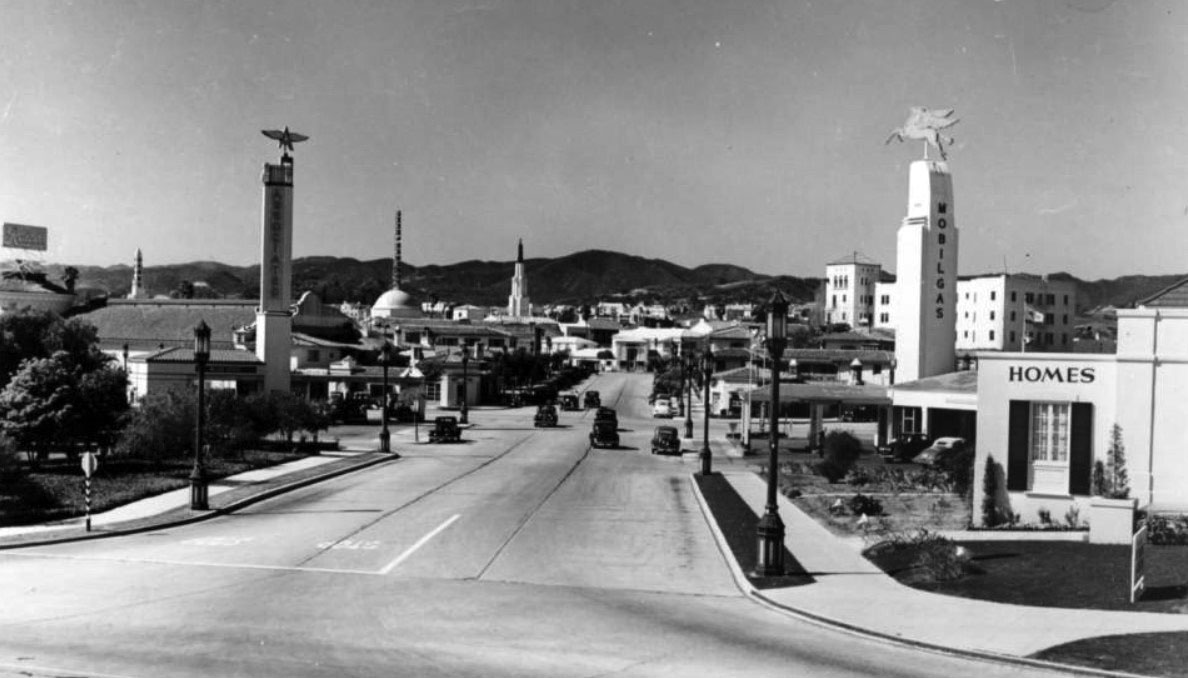 |
|
| (1939)^^ – View looking north on Glendon Ave as seen from Wilshire Blvd. in Westwood. The two closest towers are both for gas stations, Associated and Mobil, located at the intersection of Glendon Ave and Lindbrook Dr. |
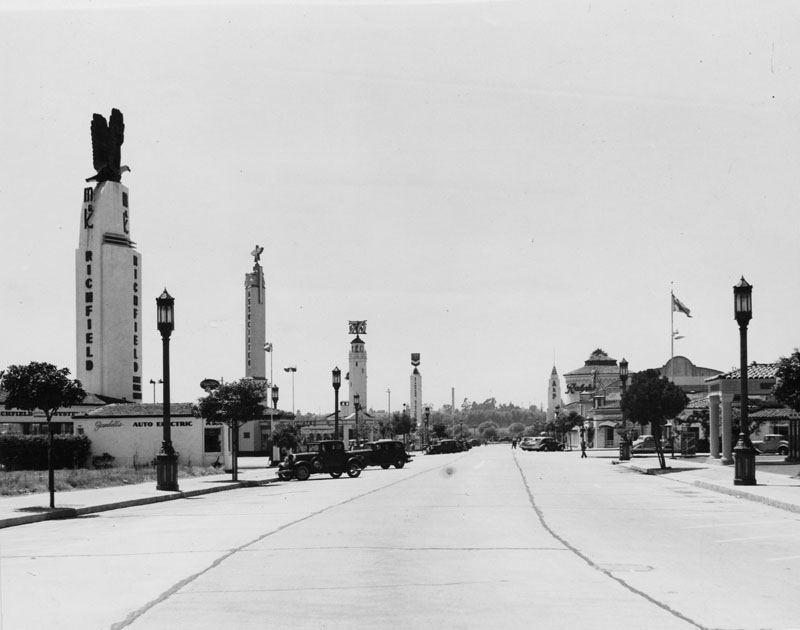 |
|
| (ca. 1937)^ - View of Westwood Boulevard, looking north from Wilshire Blvd. On the left can be seen several gas stations, including a Richfield, Associated, Union 76, and Chevron. On the right are various stores, including a Ralphs Market. |
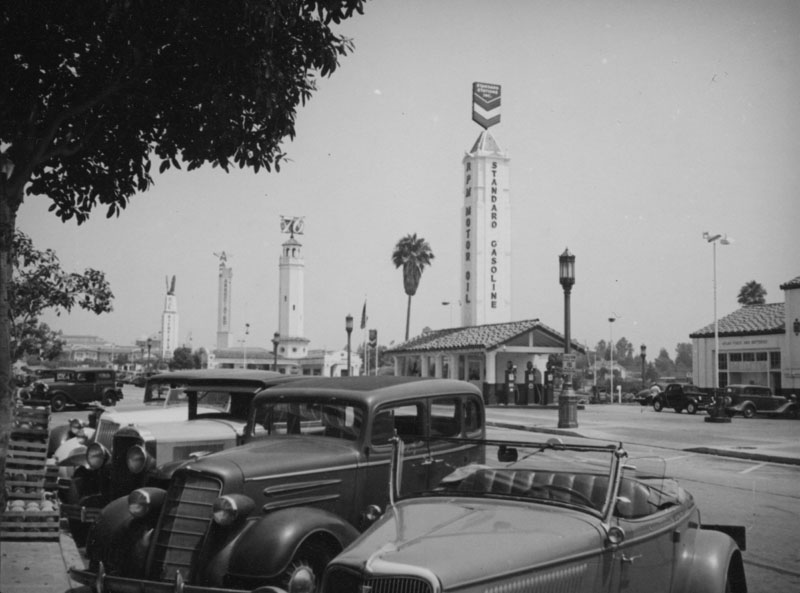 |
|
| (1930s)^ - View of Westwood Village with four tall sign towers in a row, behind the parked cars. Each tower is used to advertise a different gas station, right to left: Standard, 76, Associated, and Richfield. |
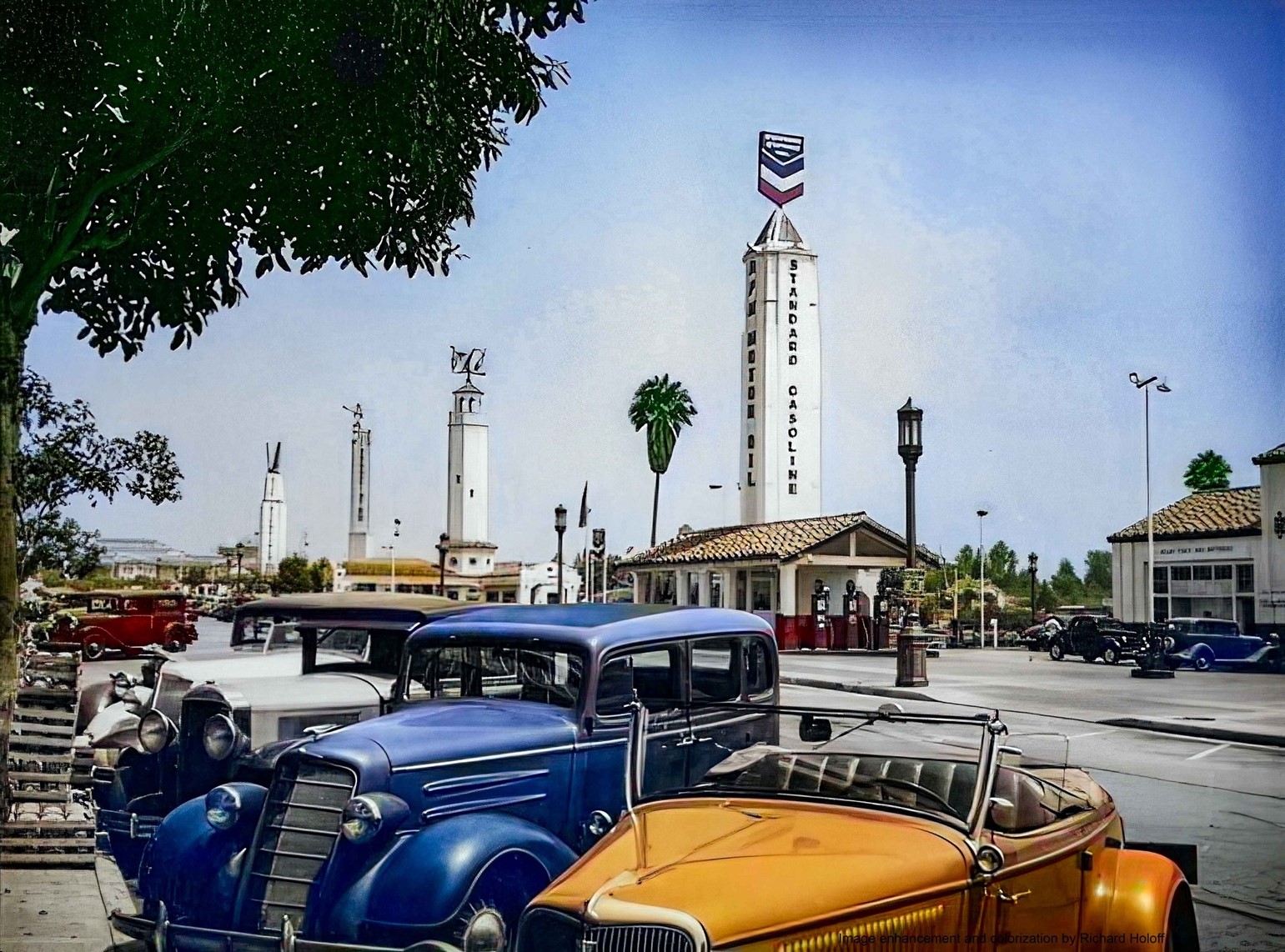 |
|
| (1930s)^ - View of Westwood Village with four tall sign towers in a row, behind the parked cars. Each tower is used to advertise a different gas station, right to left: Standard, 76, Associated, and Richfield. Image enhancement and colorization by Richard Holoff. |
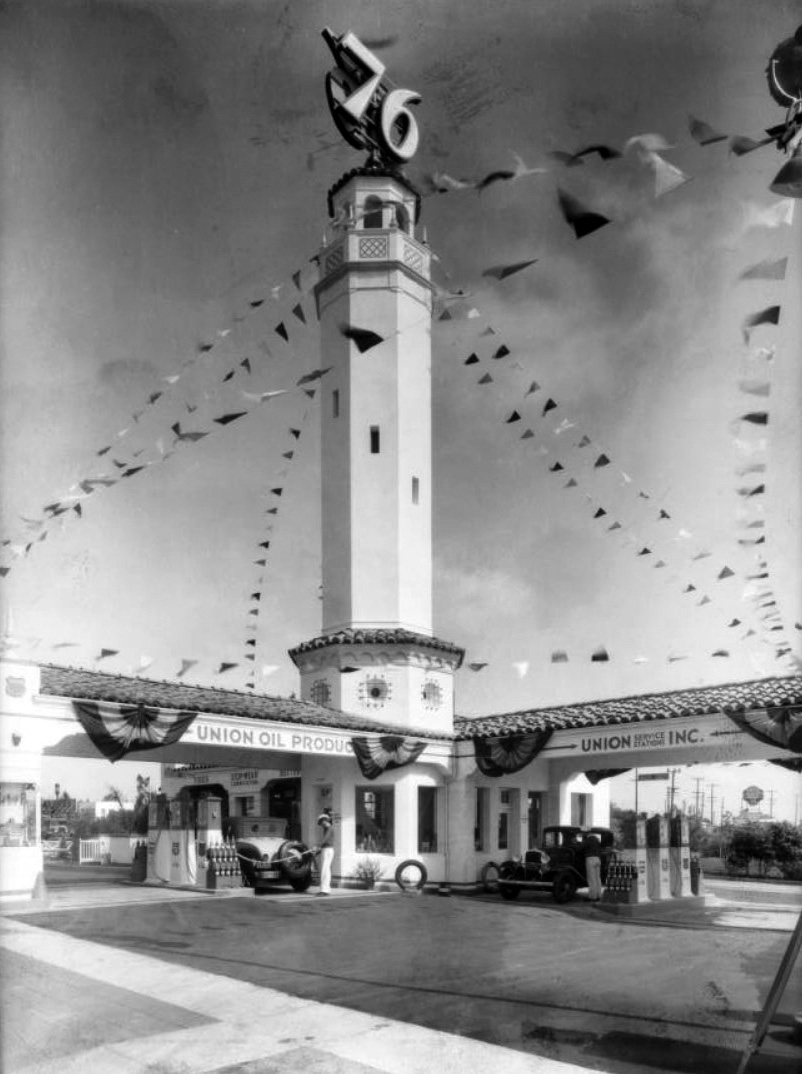 |
|
| (1933)^^ - View showing the grand opening of the Union 76 Service Station located at the southeast corner of Westwood Boulevard and Lindbrook Drive in the Westwood Village. |
Historical Notes This Union 76 Service Station had its grand opening in December 1933 as part of a massive industry opening of 750 stations citywide. The station lasted only until 1936 when it was demolished to make room for Sontag Fountain and Grill, which opened in 1938. |
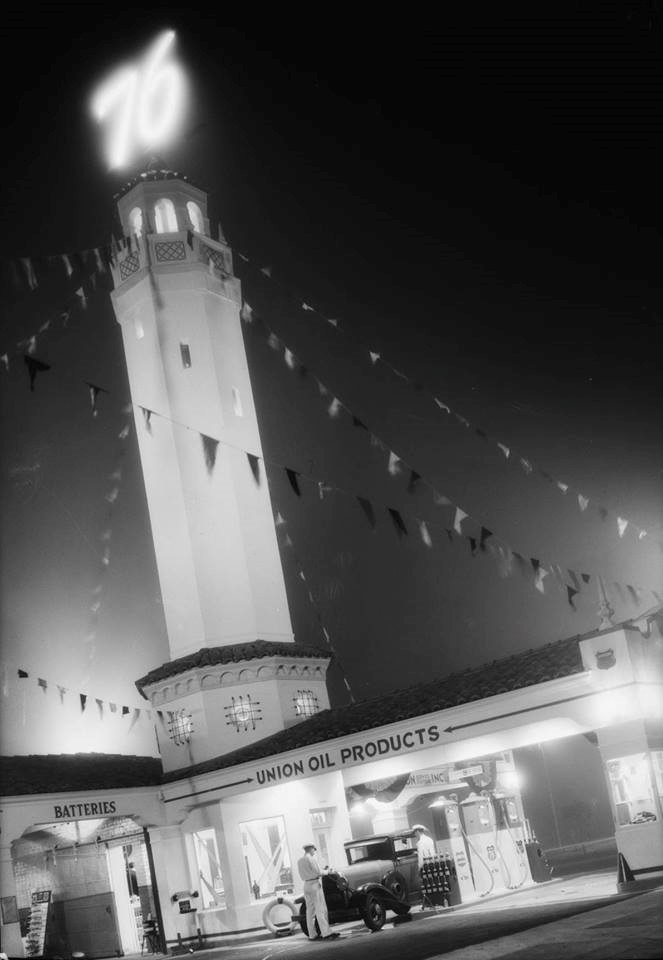 |
|
| (1931)^ – Night view showing the new Union 76 Gas Station on the southeast corner of Westwood Boulevard and Lindbrook Drive. Click HERE to see contemporary view of this same corner. |
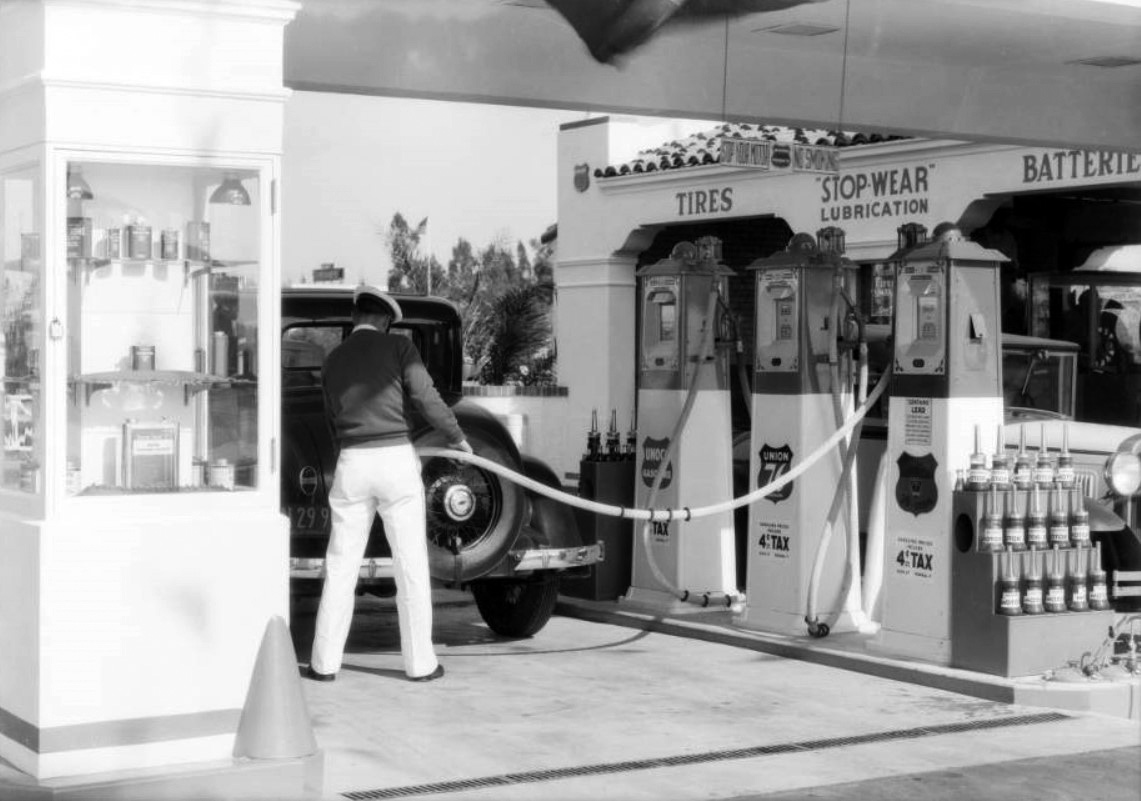 |
|
| (1933)^^ – Close-up view showing an attendant filling up a gas tank at a Union Oil Company Station at 1160 Westwood Boulevard. |
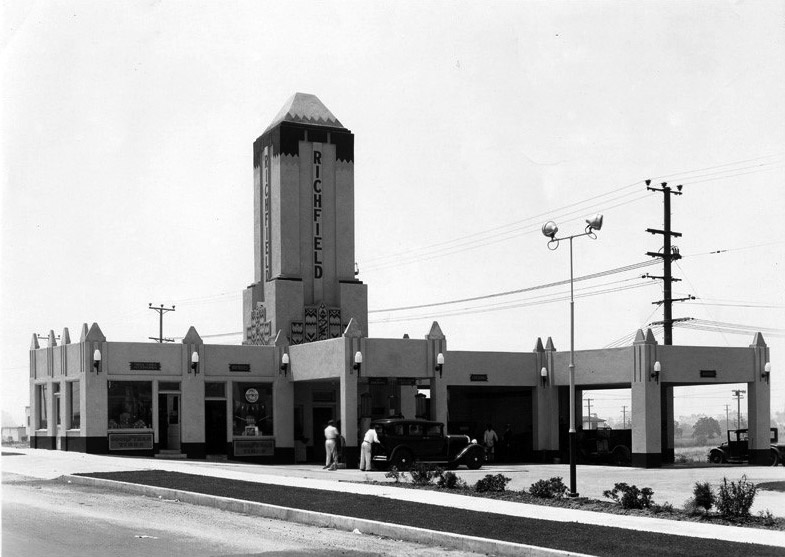 |
|
| (ca. 1933)* – View showing the Richfield Oil Station located at 1215 Westwood Boulevard. |
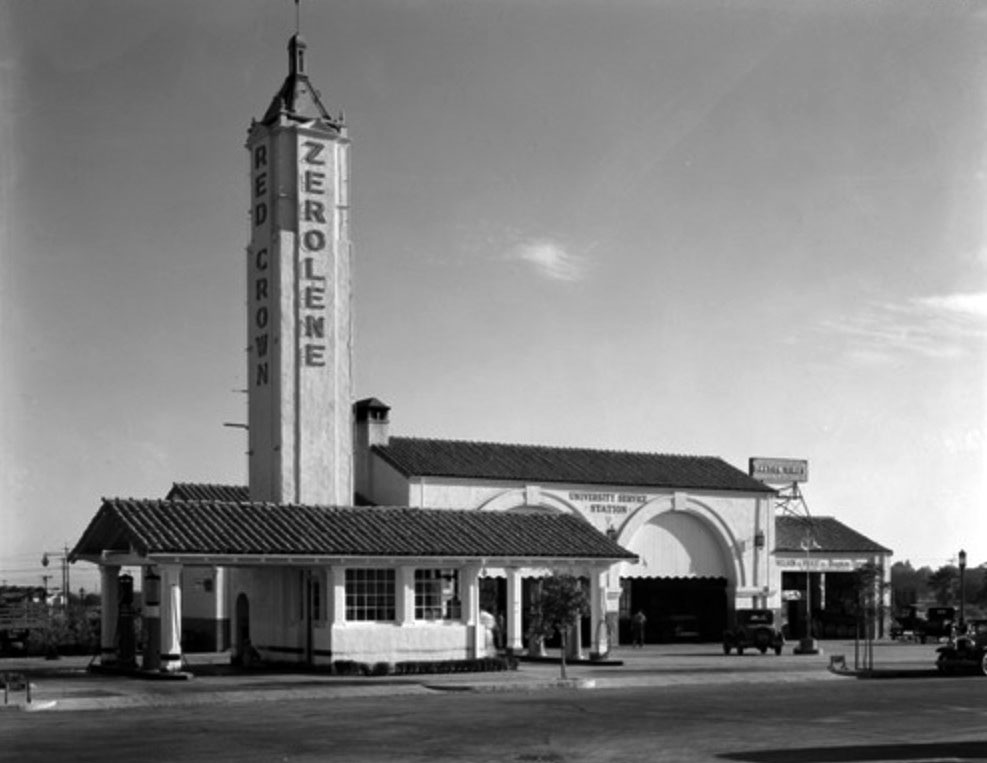 |
|
| (ca. 1933)* – View showing a service station in Westwood Village. Clock tower has "Red Crown Zerolene" on it; other signs read "University Service Station" and "Nelson and Price Inc." |
* * * * * |
Lone Palm Gas Station (Long Beach)
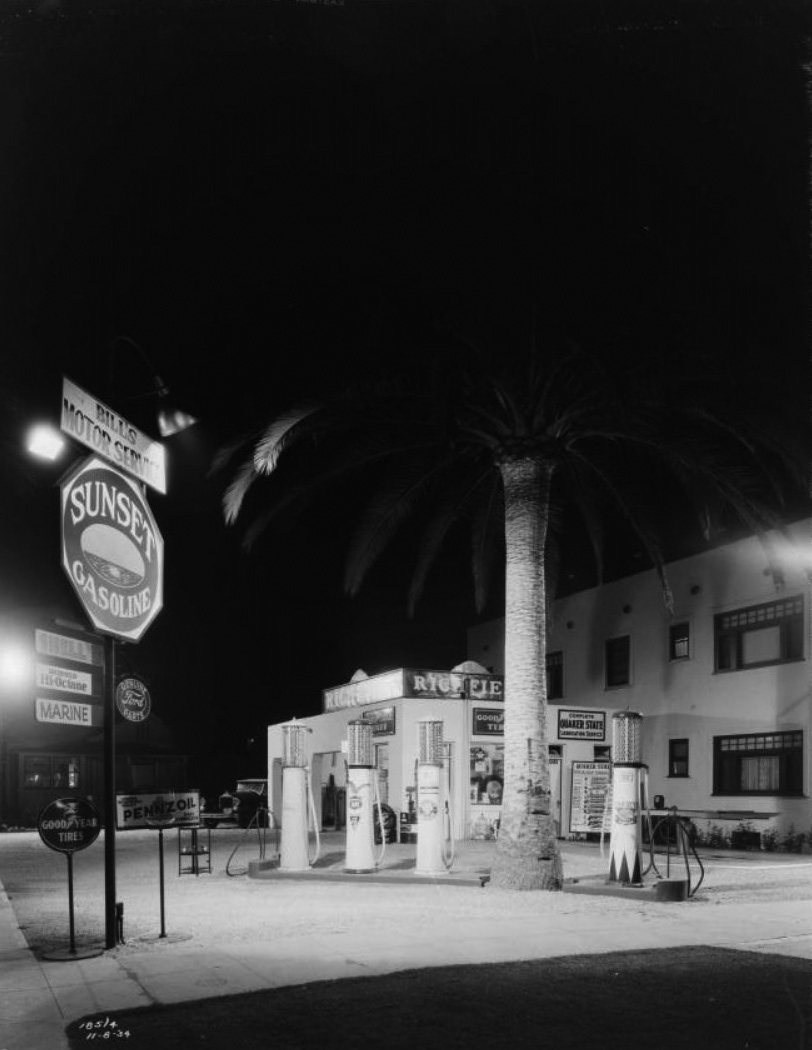 |
|
| (1934)* – View showing the Lone Palm Gas Station in Long Beach, serving Sunset Gasoline. |
* * * * * |
Johnston & Corson Texaco Service Station
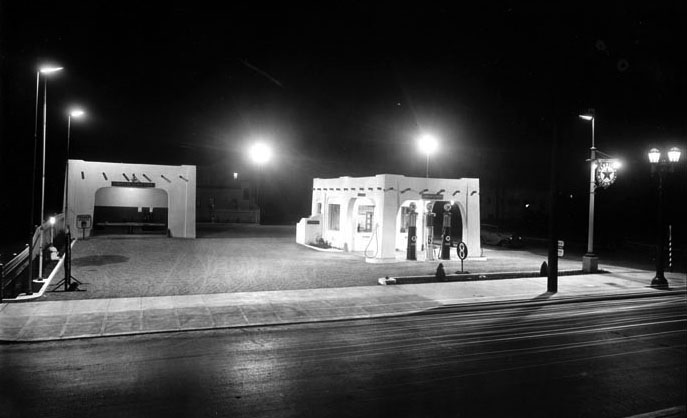 |
|
| (ca. 1935)* - Night view showing Johnston & Corson Texaco Service Station located at 1056 W. Vernon Ave. On the left is a Pueblo style lubrication station with flat roofed stucco building and projecting beams. On the right is a service station office and three pumps under an arched entrance built in the same Pueblo style stucco. |
* * * * * |
"Brownie's Day & Night" Service Station (Huntington Park)
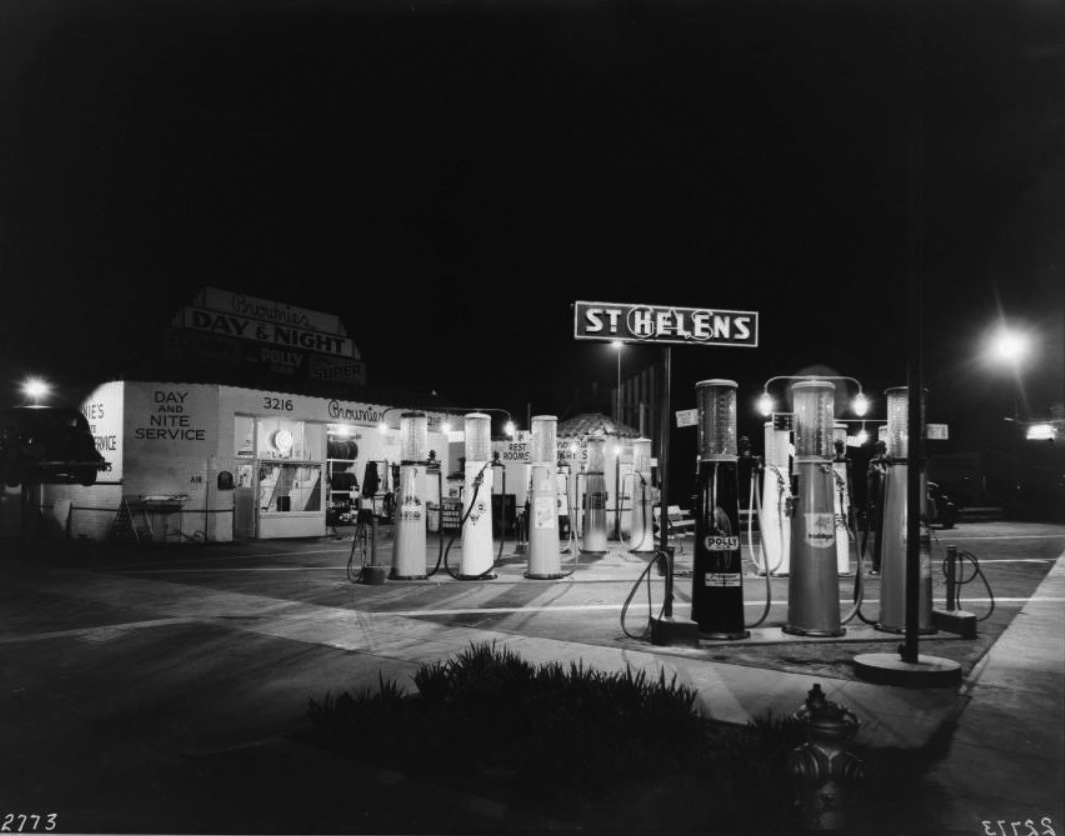 |
|
| (1939)* – Night view showing Charles L. Brown’s "Brownie's Day & Night" Service Station located at 3126 E. Florence Avenue, Huntington Park. |
* * * * * |
Gilmore Service Station (Beverly nr. Fairfax)
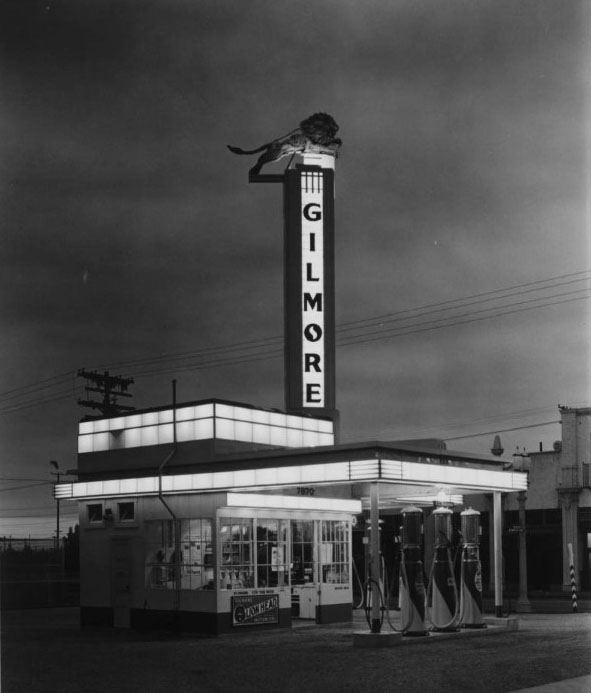 |
|
| (1935)* – Night view of the Gilmore Service Station located at 7870 Beverly Boulevard, SE corner of Fairfax and Beverly. Note the lion on top of the illuminated Gilmore sign. |
Historical Notes The Gilmore family is a longtime Los Angeles institution, having acquired the Rancho La Brea in the mid 19th century. In the early 20th century, oil discoveries on Gilmore land brought about a new fortune in petroleum. The Gilmore family went on to establish Farmers Market, which was built alongside the original Gilmore Adobe. They also established the Gilmore Bank, built Gilmore Field for the Hollywood Stars, a minor league baseball team, and also sponsored midget race cars on a small race track. Both the field and the racetrack were later replaced by CBS Television City. |
 |
|
| (ca. 1930s)^^ – Close-up view showing a Gilmore Service Station with its six pumps. A small store can be seen in the background at center, while a tall tower with the word "Gilmore" on its side and a lion on the top rises from the roof. The station is shown at night and is brightly lit, especially around the edges of the roof and on the tower. |
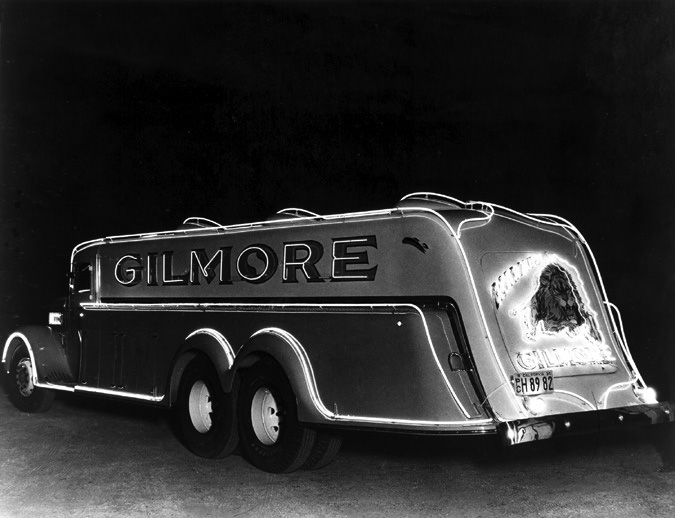 |
|
| (1930s)* – View showing a Gilmore Oil delivery truck which always featured the company's symbol, a lion ("Roar With Gilmore"); not all the trucks were as neon sleek as this beauty. |
* * * * * |
Gilmore Service Station (now Starbucks Drive-thru)
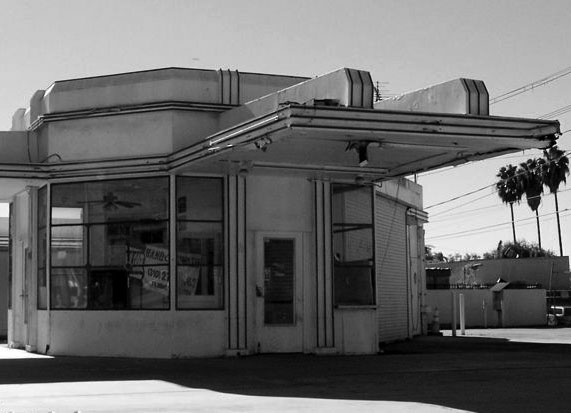 |
|
| (n.d.)#** – View showing the defunct Gilmore Service Station at 6800 Willoughby Ave. and 853-859 N. Highland Ave. |
Historical Notes Built in 1935, this Art Deco gas station was designed by R.J. Kadow, and was one of the original service stations for the Gilmore Oil Company. The station remained with the company until its merger with Mobile Oil in the 1940's. It was later leased by Texaco. ^*^ On March 23, 1992, the above service station became Los Angeles Historic-Cultural Monument No. 508. |
 |
|
| (2015)*^^ - Gilmore Gasoline Service Station, 859 North Highland Ave. LAHCM #508, view from north. Became a Starbuck's a couple of months before this picture was taken. |
Historical Notes This prime example of L.A.’s car culture once again serves as a fuel station. Starbucks restored the once gas station into a walk up and drive through coffee shop. The architecture team removed incompatible alterations, such as metal roll-up garage doors, and replaced them with contemporary adaptations of historic garage doors. The team meticulously restored the station’s decorative lighting and recreated the historic cantilevered canopies. The L.A. Conservancy gave this converted gas station a 2018 Preservation Award.^ |
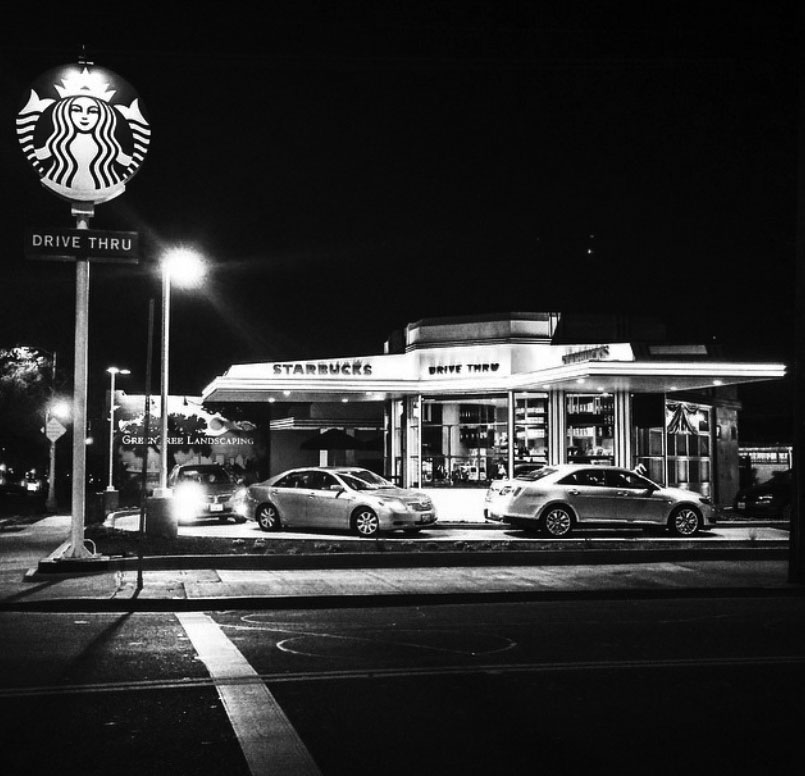 |
|
| (2017)** – Night view showing the original 1935-built Gilmore Gas station now in its second life as a successful Starbucks Drive-thru, located on the southwest corner of Highland and Willoughby avenues. Click HERE for contemporary view. |
* * * * * |
Union 76 (Adams and Hoover)
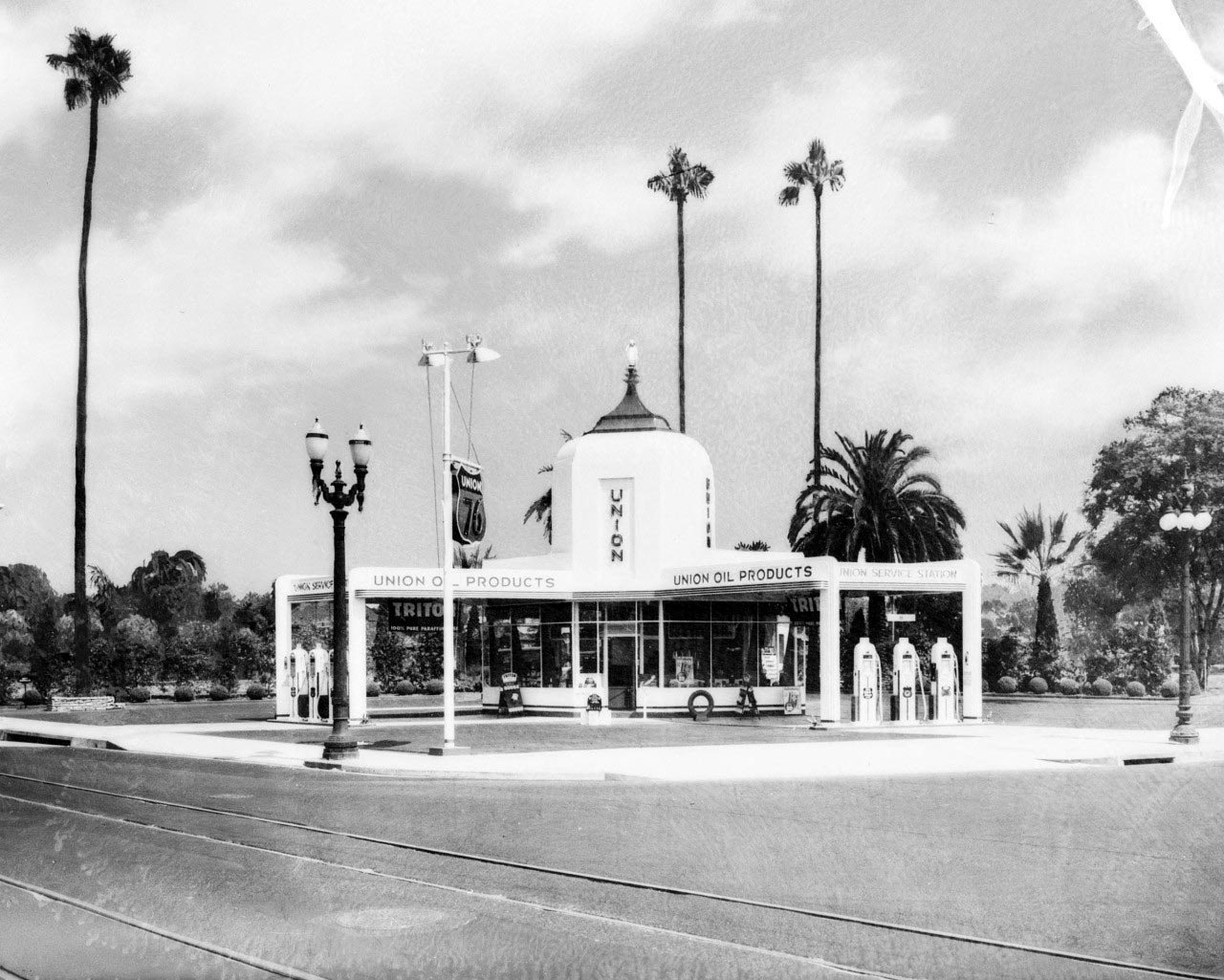 |
|
| (1935)* – View looking at the northeast corner of W. Adams Boulevard and Hoover Street showing a Union 76 Service Station surrounded by palm trees and ornate streetlamp posts. Photo by Dick Whittington - Click HERE to see more Early Los Angeles Streetlights. |
Historical Notes The average price of gasoline in Los Angeles in 1935 was $0.16 per gallon. |
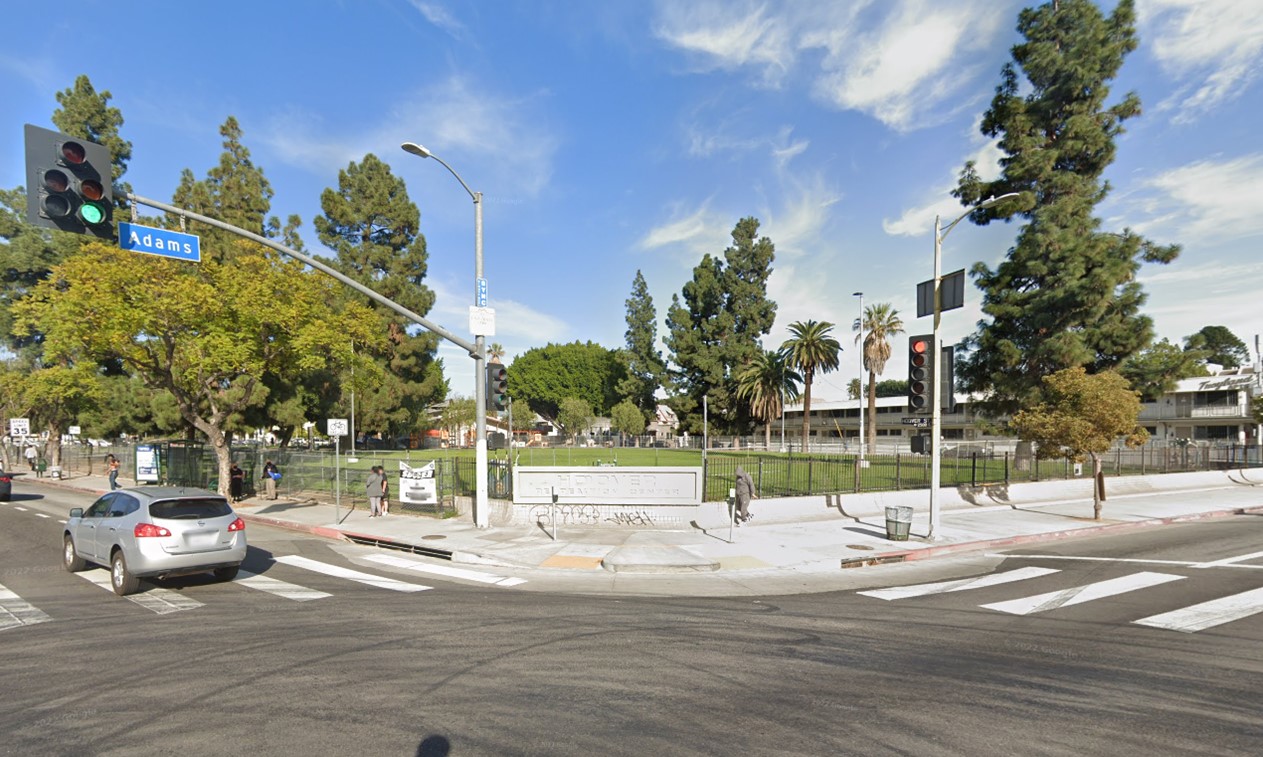 |
|
| (2022)* – Looking at the northeast corner of Adams Boulevard and Hoover Street toward the Hoover Recreational Center. |
Then and Now
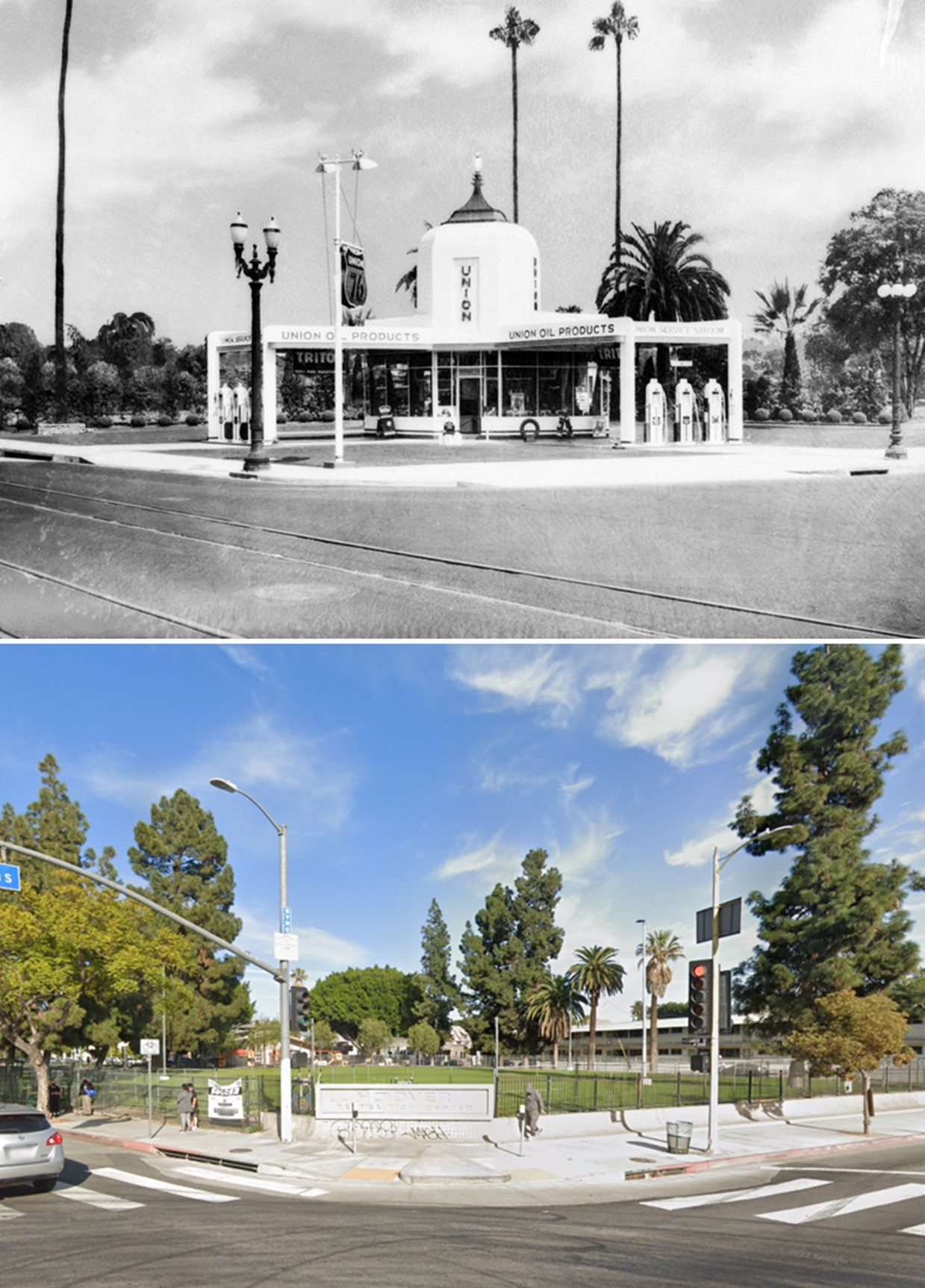 |
|
| (1935 vs 2022)* – Looking at the northeast corner of Adams Boulevard and Hoover Street where a Union 76 Service Station once stoody, today part of the Hoover Recreational Center. |
* * * * * |
Standard Service Station
 |
|
| (1935)* – View looking northeast showing three cars being serviced by three attendants at a Standard Service Station located on the northeast corner of Wilshire Boulevard and Coronado Street, 2525 Wilshire Boulevard. Note the ivy-covered mansion behind the station. In the far left stands the Asbury Apartments. Click HERE for contemporary view. |
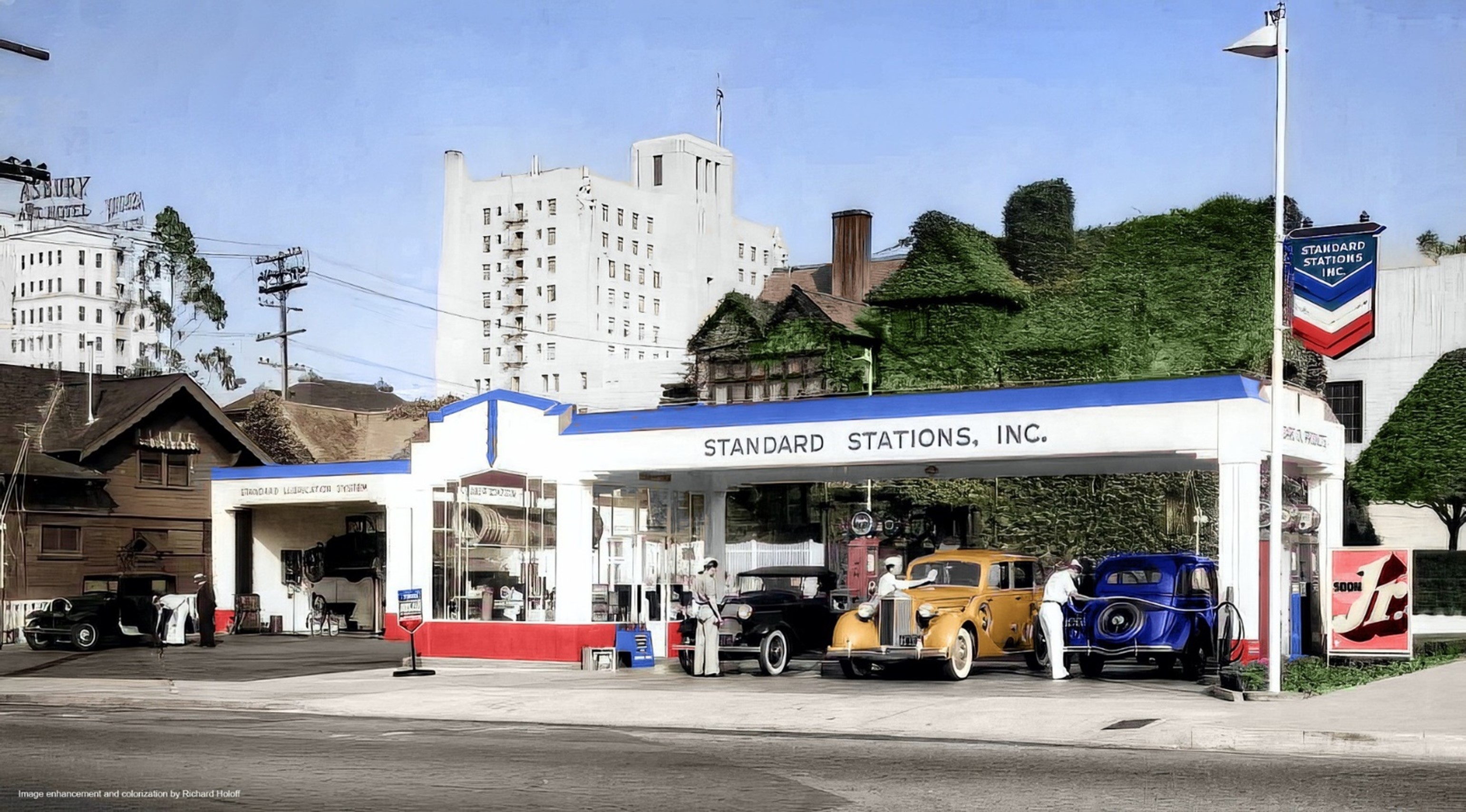 |
|
| (1935)* – View looking northeast showing three cars being serviced by three attendants at a Standard Service Station located on the northeast corner of Wilshire Boulevard and Coronado Street, 2525 Wilshire Boulevard. Note the ivy-covered mansion behind the station. Image enhancement and colorization by Richard Holoff |
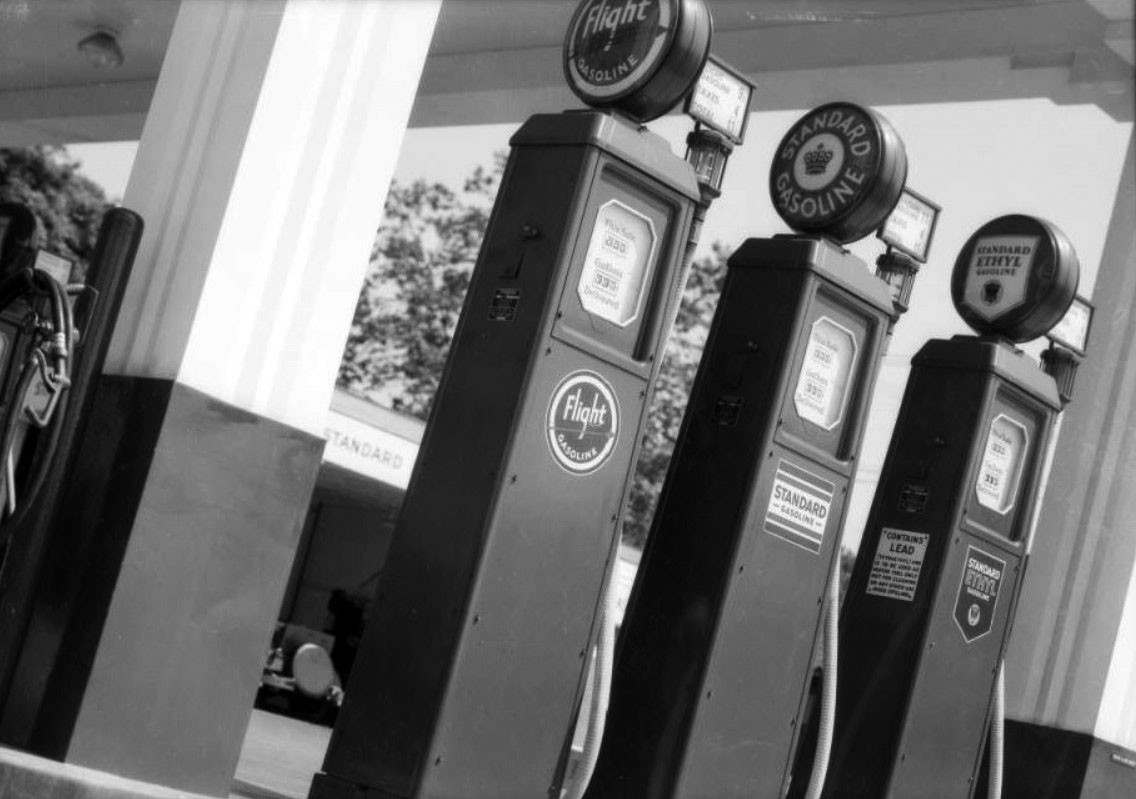 |
|
| (1935)^^ – Close-up view of the gas pumps at Standard Service Station showing three different grades: Flight, Standard, and Ethyl. |
.jpg) |
|
| (1935)^^ – View showing a Standard Oil delivery truck (Dodge K52 Airflow) filling the underground tank at a Los Angeles Standard Service Station. |
Historical Notes The K52 was a 6 cylinder, 100 horsepower Dodge truck, with 1275 gallon fuel capacity. The first Dodge K52 Airflow was produced in December 1934, ushering in a brief "Streamline" era in its production. Between 1934 and 1939, Airflows were built, of which were made for the Standard Oil Company, based in New Jersey and California.^ Note the uniform worn by the worker. Looks like police or military. Civilian professional uniforms was common practice at the time. The fuel industry, postal services, milk delivery and even servers in restaurants wore uniforms. Some more military in design than others. But, it was the standard. You could tell what one did for work by their uniform or hat. Not so much today. On reason why it was common then was, a clean and tidy uniform gave a professional and trustworthy impression. |
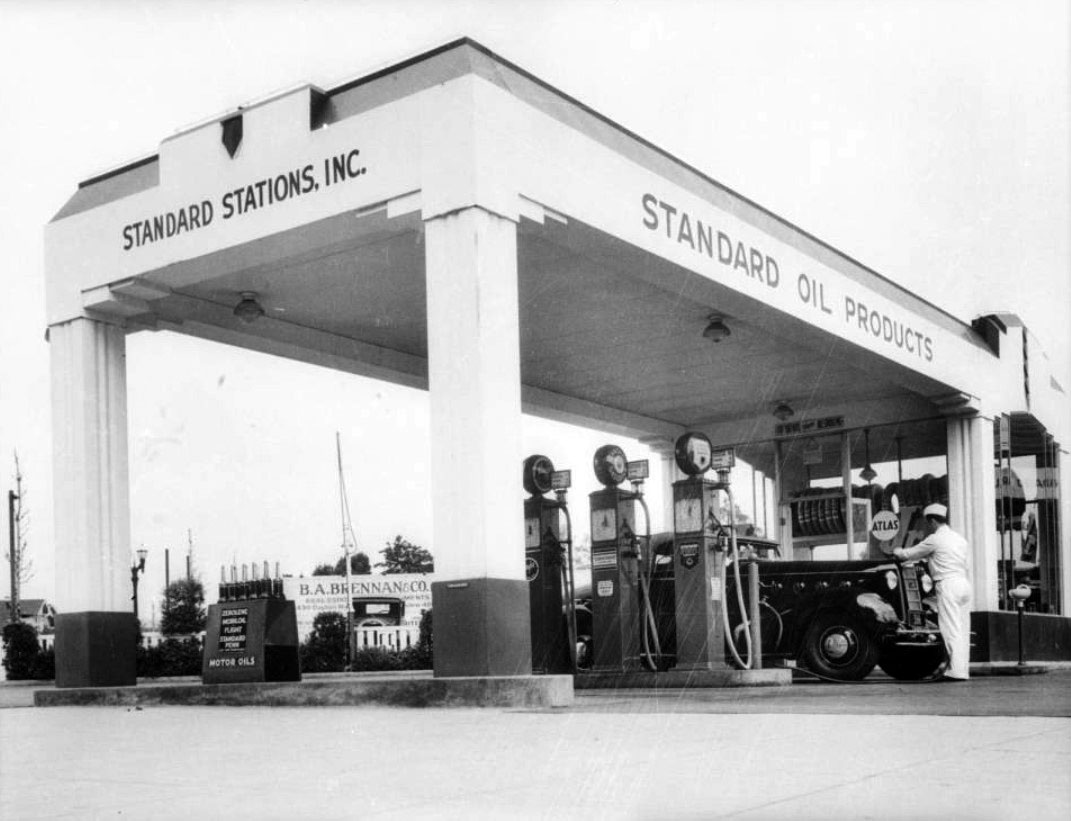 |
|
| (1935)^^ – View showing an attendant checking the front of what appears to be a 1935 Packard Super Eight Coupe Roadster at a Standard Service Station somewhere in L.A. |
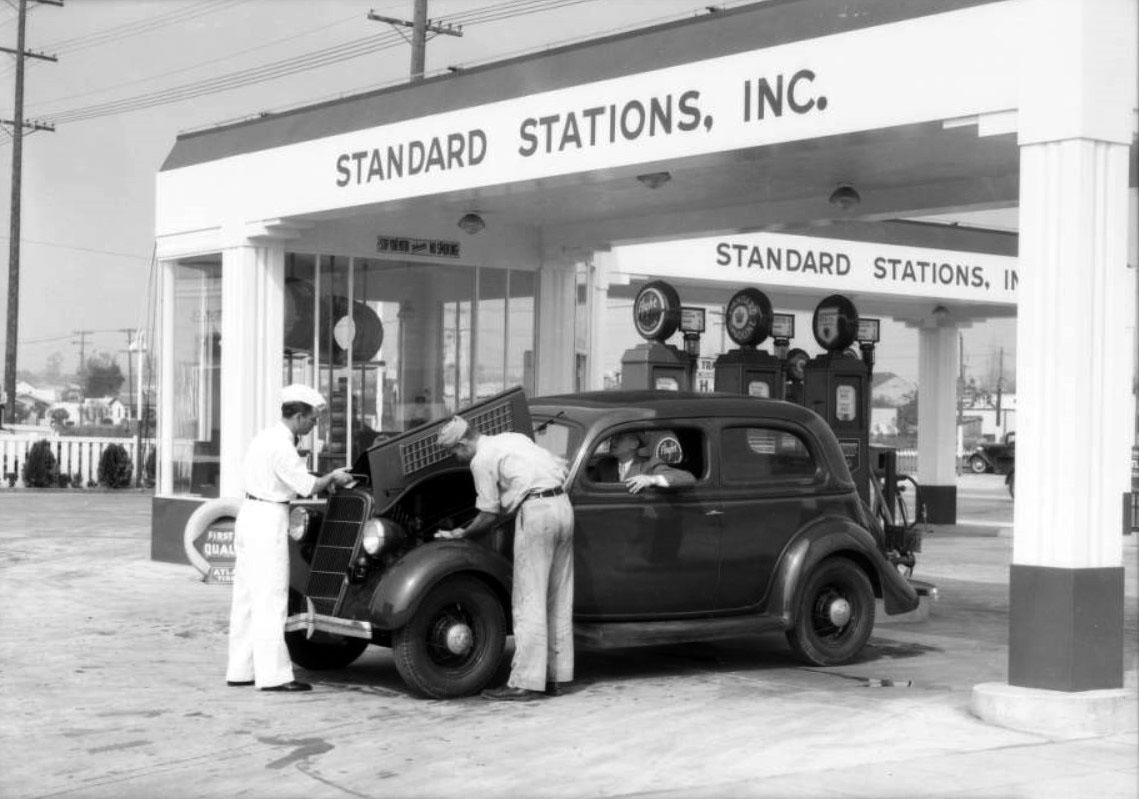 |
|
| (1935)^^ – Two attendants provide full service while customer watches on from behind the steering wheel. This Standard Service Station was located at 3046 Crenshaw Boulevard. The car above is a 1935 Ford Tudor. |
 |
|
| (1935)* – The same customer is now parked by the picket fence while attendants clean a headlight and fill tire with air compressor. |
* * * * * |
Signal Oil Service Station
.jpg) |
|
| (1935)^^ - Attendant topping off radiator at a Signal Oil Service Station located on the NW corner of Melrose and Vermont. The Bella Napoli Café at 711 N. Vermont is seen in the background. |
 |
|
| (1935)^^ - Close-up view showing an attendant adding oil to an early model car at a Signal Oil Service Station. Note how the engine hood folds up. |
* * * * * |
Hancock Service Station (Canoga Park)
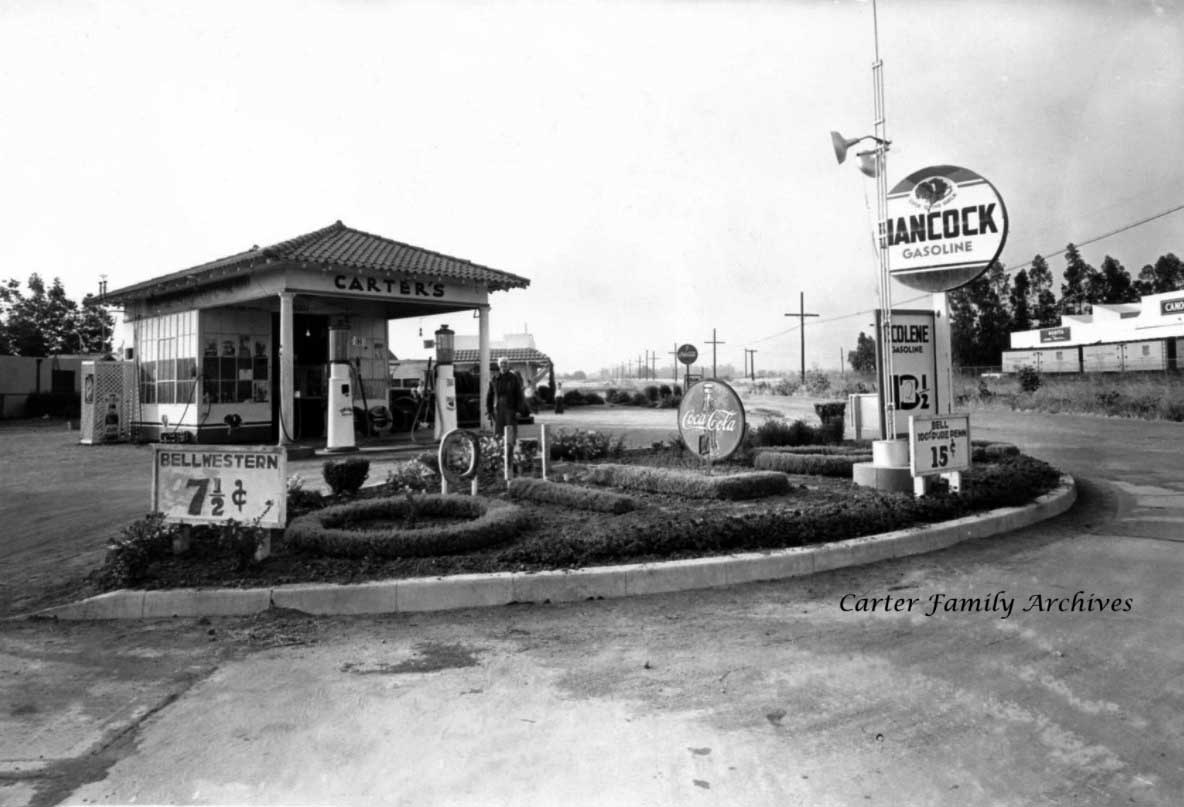 |
|
| (ca. 1930s)* – View looking at the NW corner of Roscoe and Canoga Ave showing Carter’s Hancock Gas Station. Across the street, East side of Canoga, can be seen the Canoga Citrus Association Building (today occupied by the Salvation Army. Photo Courtesy of the Carter Family |
Historical Notes Mr & Mrs Carter lived on Chase St in Canoga Park, as seen in city directories in 1937 & 1939, as well as the US Census in 1940. Today, a Chevron station is located on the NW corner of Roscoe and Canoga. Click HERE to see Contemporary View. |
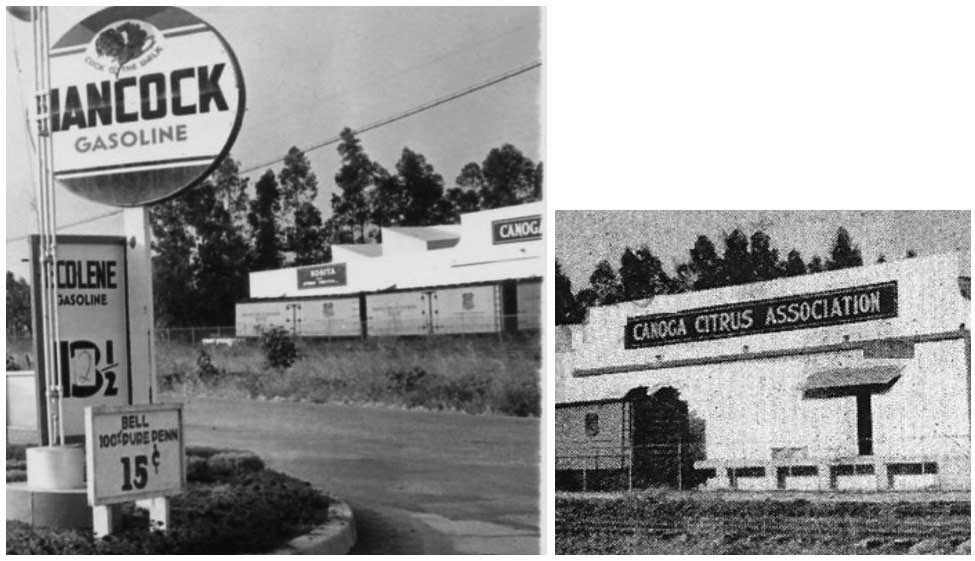 |
|
| (ca. 1930s)* – Close-up view showing the Canoga Citrus Plant across the street from Hancock Gas Station. Note the gas price has been modified from 13 ½ to 12 ½ Cents. Photo Courtesy of Keith Hart |
Historical Notes HANCOCK Oil Company was headquartered in Los Angeles. In the 1850’s, lawyer Henry Hancock helped the Rocha family establish their legal claim to Rancho La Brea, but they ended up owing him so much in fees that they gave him part of the rancho in payment. In 1860 Hancock and his brother bought the rest of the rancho. Hancock began to sell asphalt produced from the famous tar pits that gave the rancho its name. This was the beginning of the Hancock Oil Company. In 1885 Hancock’s widow leased part of the rancho to eastern oil men who went bust by 1888. But in 1902, Mrs. Hancock leased part of the rancho to the Salt Lake Oil Company, which proved a great success. Henry Hancock’s son, George A. Hancock, who had learned the oil business working for Salt Lake, established his own company in 1906. By February 1907, he had over 70 wells producing nearly 300 barrels a day, making the Hancock's one of California’s wealthiest families. The Hancock family built Hancock Park, a large upscale apartment community. The Hancock Oil Company was sold to Signal Oil in 1958. In 1965 Signal was sold to Humble, and both the Hancock and Signal brands vanished.* |
* * * * * |
Rio Grande Service Station (Pacoima)
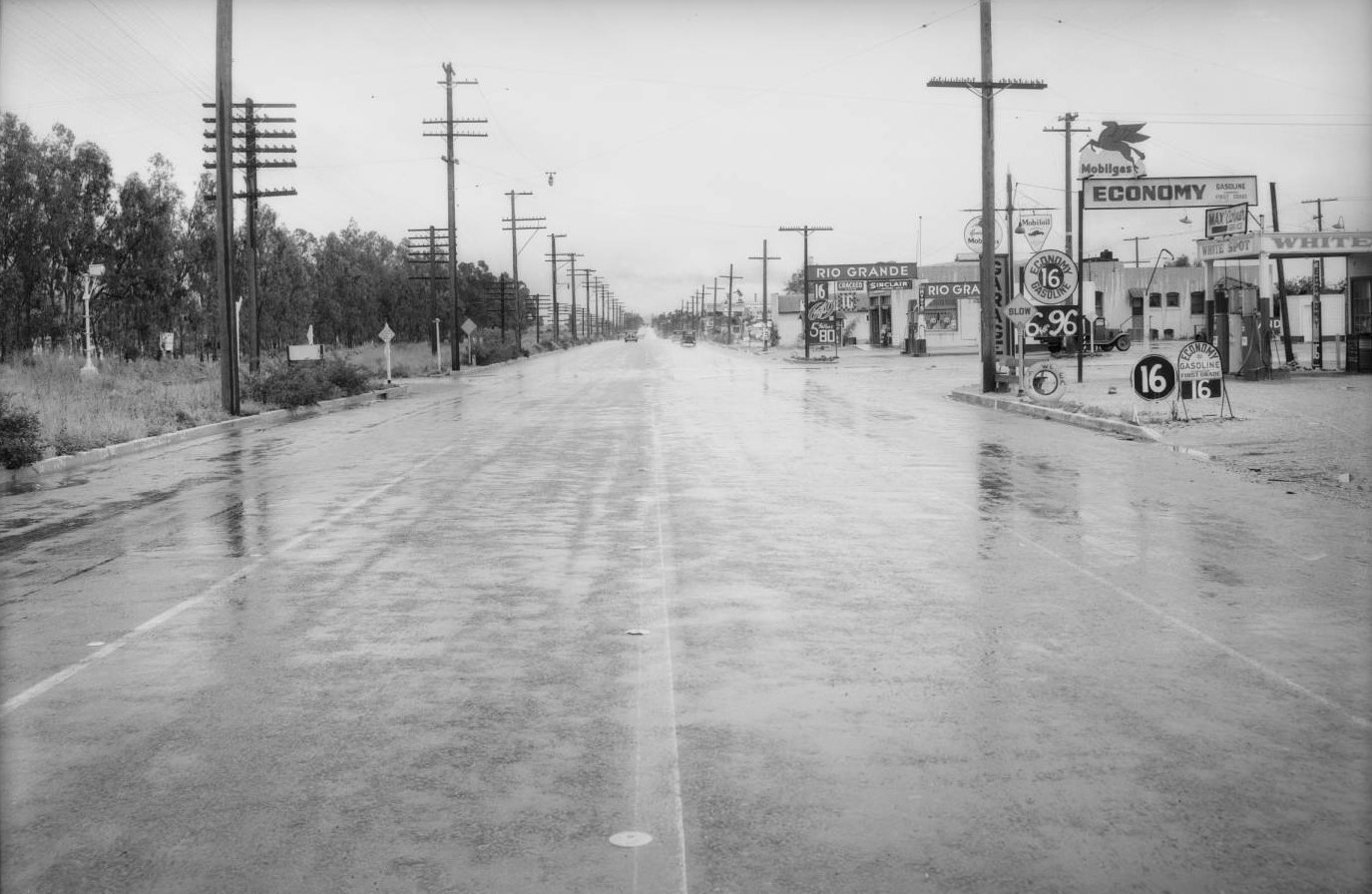 |
|
| (1935)^^ – View looking south on a rain-slick San Fernando Road toward Osborne Street. Two gas stations are seen at the intersection: Mobil and Rio Grande. |
Historical Notes By 1936, Rio Grande had reorganized and merged with other companies to become Richfield Oil Corporation.^ |
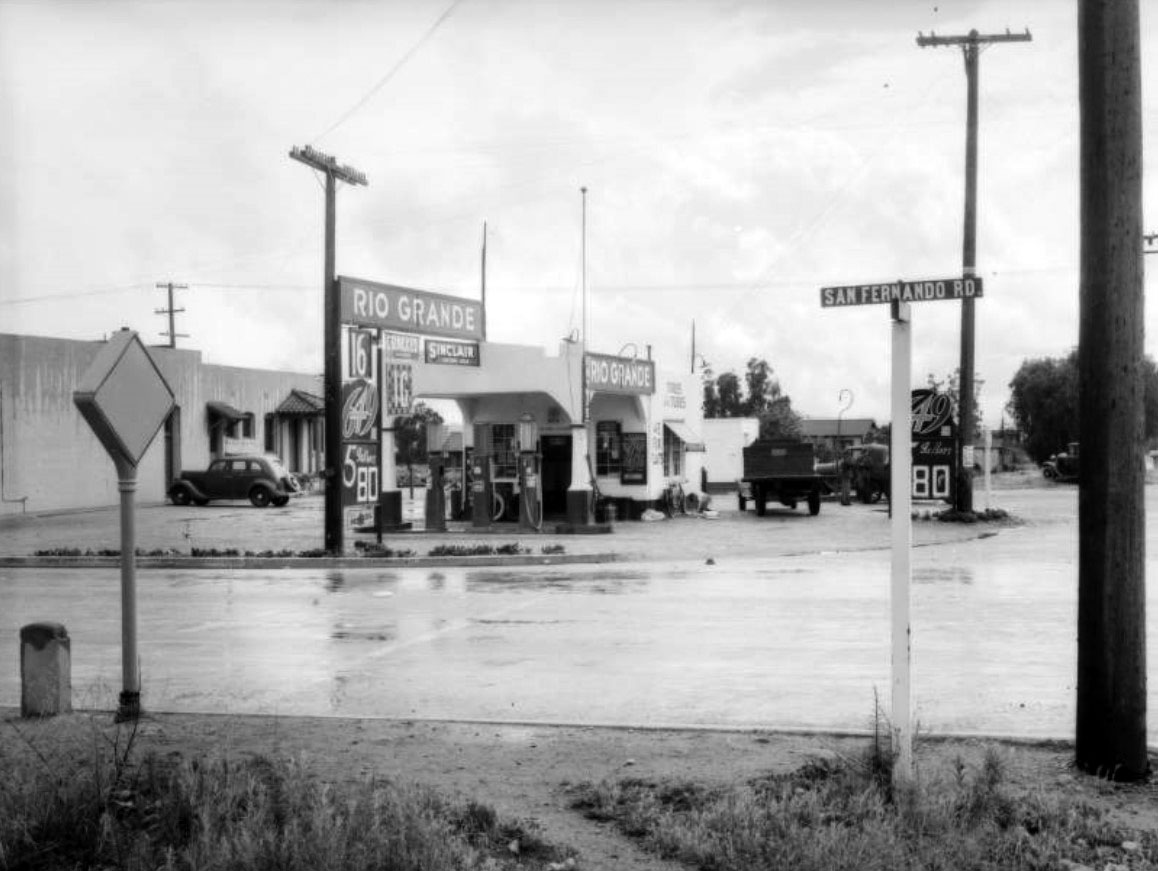 |
|
| (1935)^^ - Intersection of Osborne Street and San Fernando Road with the Rio Grande Service Station seen on the SW corner. |
.jpg) |
|
| (1935)##^ – Close-up view of the Rio Grande Service Station. Note the gas prices: 5 Gallons for 80¢ (16¢ per Gallon!) |
Historical Notes Rio Grande Oil Company began in the petroleum business in 1915. At the time, its main business was supplying U.S. military forces with gasoline in support of operations against Pancho Villa. By 1936, Rio Grande had reorganized and merged with other companies to become Richfield Oil Corporation.^ |
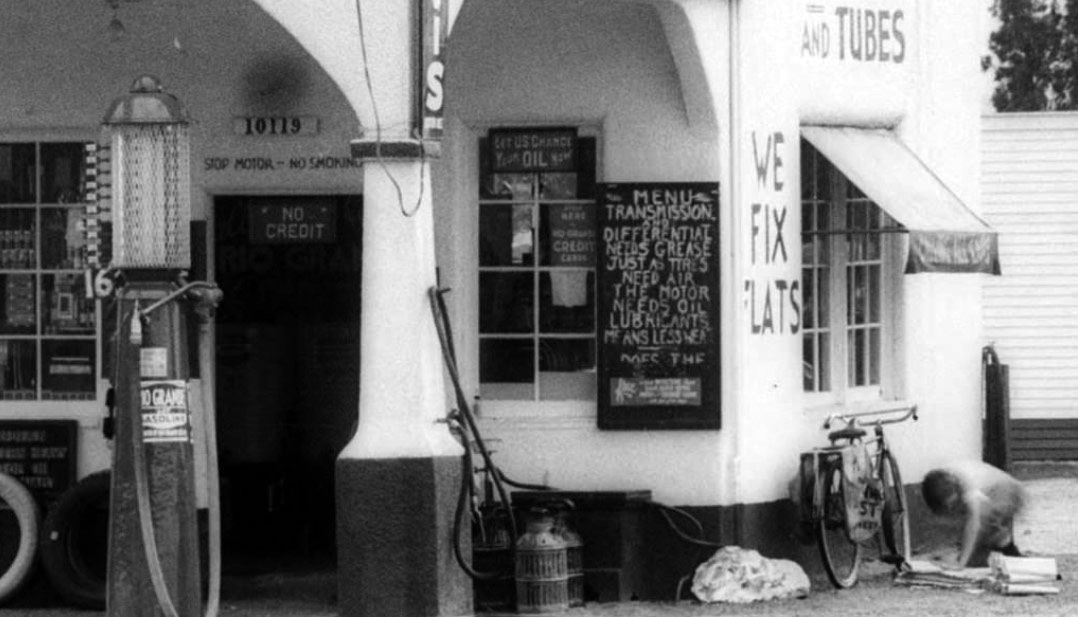 |
|
| (1935)##^ - Blow-up of previous photo showing a newspaper delivery boy folding newspapers (right) at the Rio Grande Service Station, 10119 San Fernando Road. |
* * * * * |
Royal Albatross Service Station (Studio City)
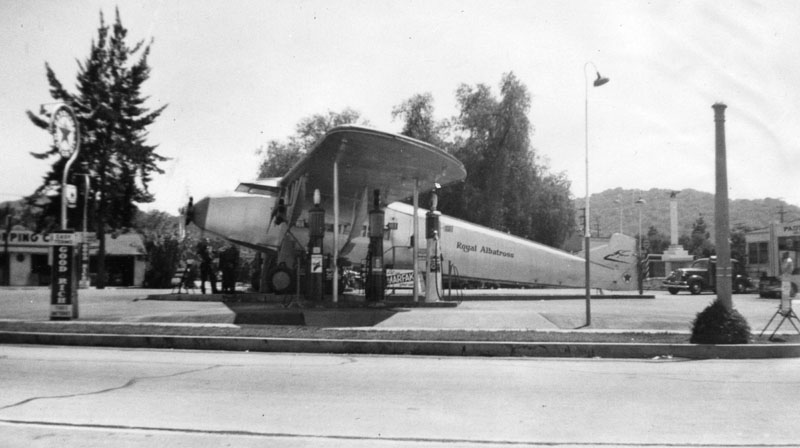 |
|
| (1939)^ - View of the Royal Albatross, an airplane used as a service station, located on the eastern vertex of a narrow strip of land bordered by Ventura Boulevard (south), Ventura Place (north, seen here, foreground) and Laurel Canyon Boulevard (west). Gasoline pumps are set up under the wing spans. |
Historical Notes The Zenith Model 12 didn’t work out too well. It was an attempt to travel on the success of Henry Ford’s trimotor. It was underpowered and not a roaring success. It became a one of a kind airplane. However, it wasn’t totally useless. Someone saw it as a gasoline station. It was set up as part of a Texaco station in the gore point created by the intersection of Ventura Boulevard and Ventura Place in Studio City opposite Republic Studios.^ |
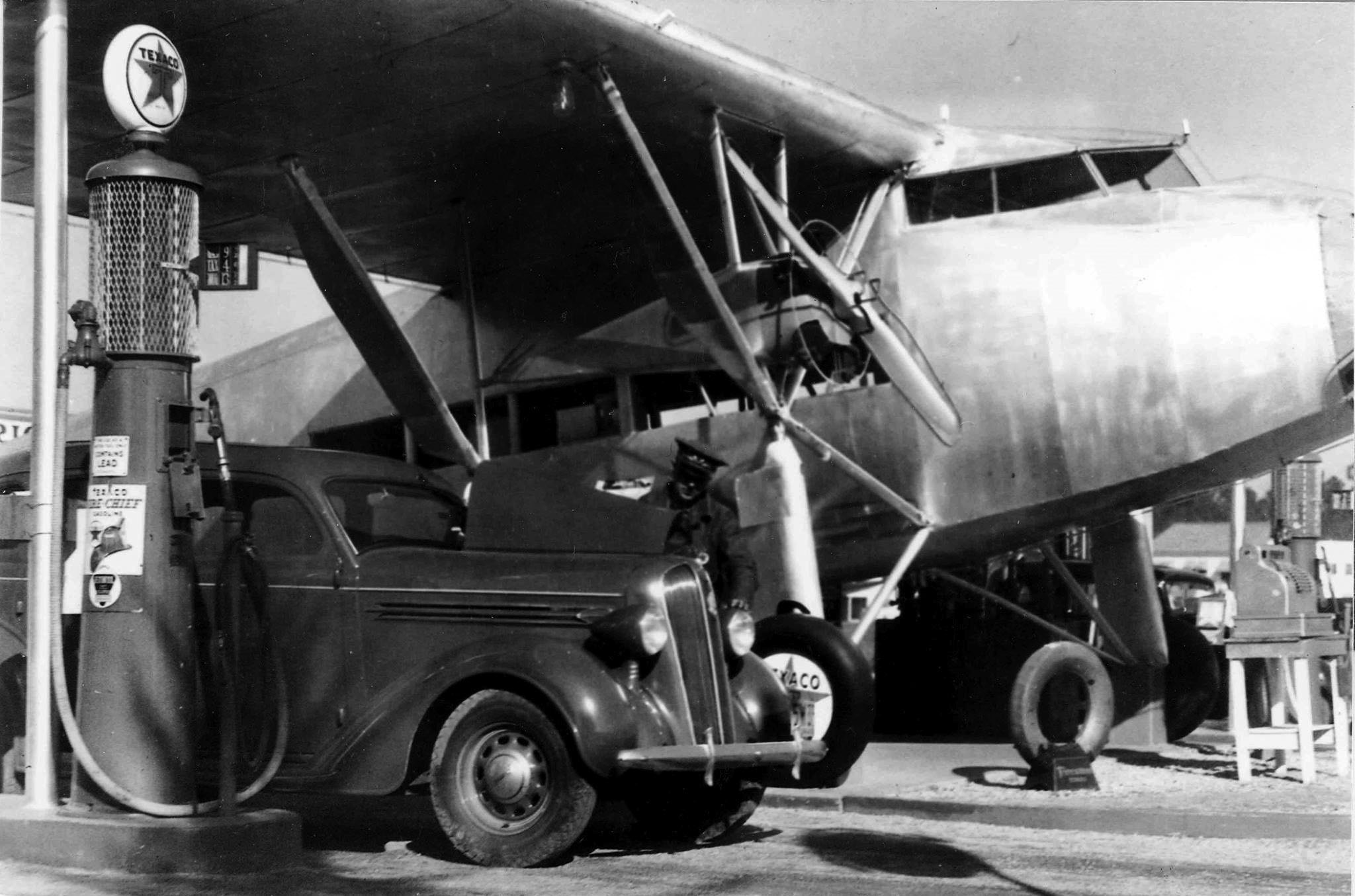 |
|
| (ca. 1939)* - Close-up view showing an attendant servicing a car at the Royal Albatross Texaco Service Station in Studio City. Note the cash register on the right. |
Historical Notes History is vague but the Royal Albatross disappeared around the onset of WWII. |
Then and Now
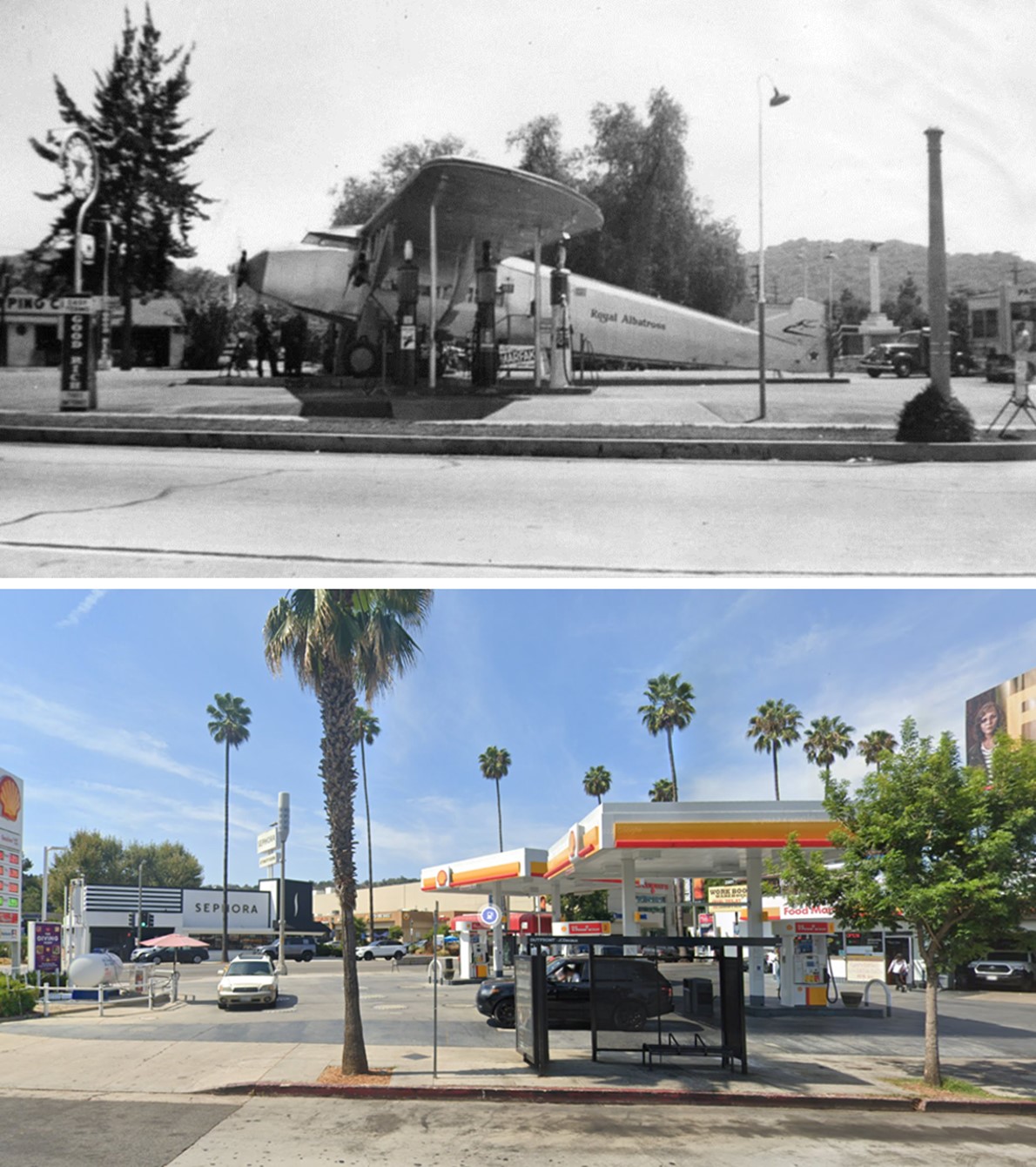 |
|
| (1939 vs 2022)* - Looking at the NW corner of Ventura Boulevard and Ventura Place showing a Shell gas staton where the Royal Albatross, an airplane used as a service station, once stood. Photo comparison by Jack Feldman. |
* * * * * |
Bob's Airmail Service Station (Wilshire and Cochran)
 |
|
| (ca. 1935)* – View looking toward the NW corner Wilshire Boulevard at Cochran Avenue. An airplane (Fokker F-32) seems to be parked on the corner lot. Sign on the wings reads: BOB'S AIRMAIL SERVICE |
Historical Notes This is Bob's airmail service gas station, which stood at 5453 Wilshire Blvd, at the corner of Cochran Ave. The plane is a 32-passenger Fokker F-32, which was a white elephant of an aircraft that never really worked right. They were probably going cheap so that when in 1934, Bob Spenser got the idea to build a Mobil gas station around one, Fokker probably said, “Here! Take it!” It sure must have been eye catching because in 1934, Bob's Air Mail Service Station sold more Mobiloil and Mobilgas products than any other dealer on the West Coast. |
 |
|
| (1936)* - You could gas up your car beneath the wings of a grounded airplane at Bob’s Air Mail Service Station on the NW corner of Wilshire Blvd. and Cochran Ave. |
Historical Notes Bob’s Air Mail Service utilized the twin-prop airplane to top its station, with the wings serving as canopies to shade its General Petroleum pumps. The plane was one of two Fokker F-32 aircraft operated by Western Air Express, circa 1930-31. The four engine F-32 was a design failure due to overheating of the two pusher engines and was only briefly in commercial service. |
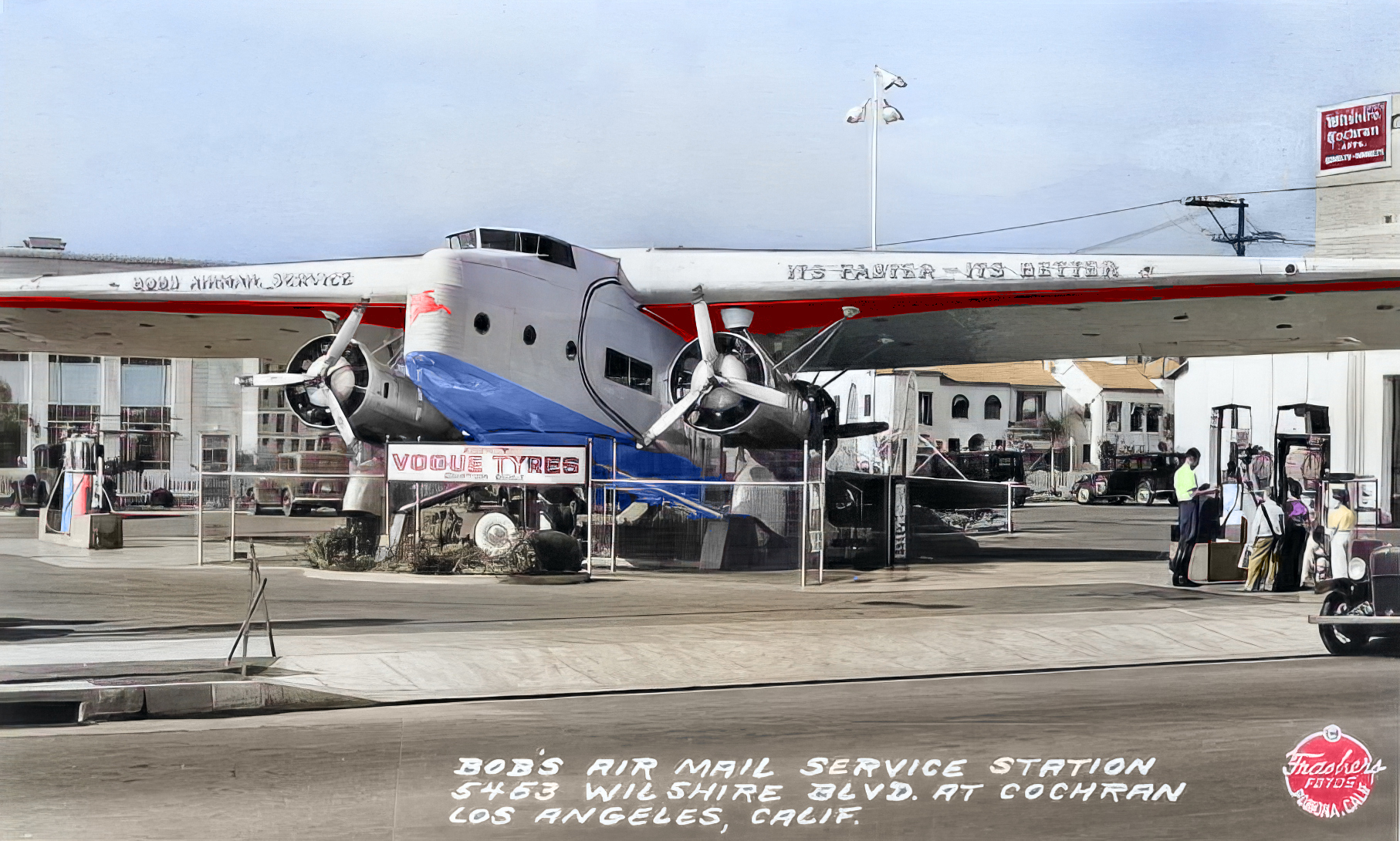 |
|
| (1936)*- You could gas up your car beneath the wings of a grounded airplane at Bob’s Air Mail Service Station on the NW corner of Wilshire Blvd. and Cochran Ave. Image enhancement and colorization by Richard Holoff |
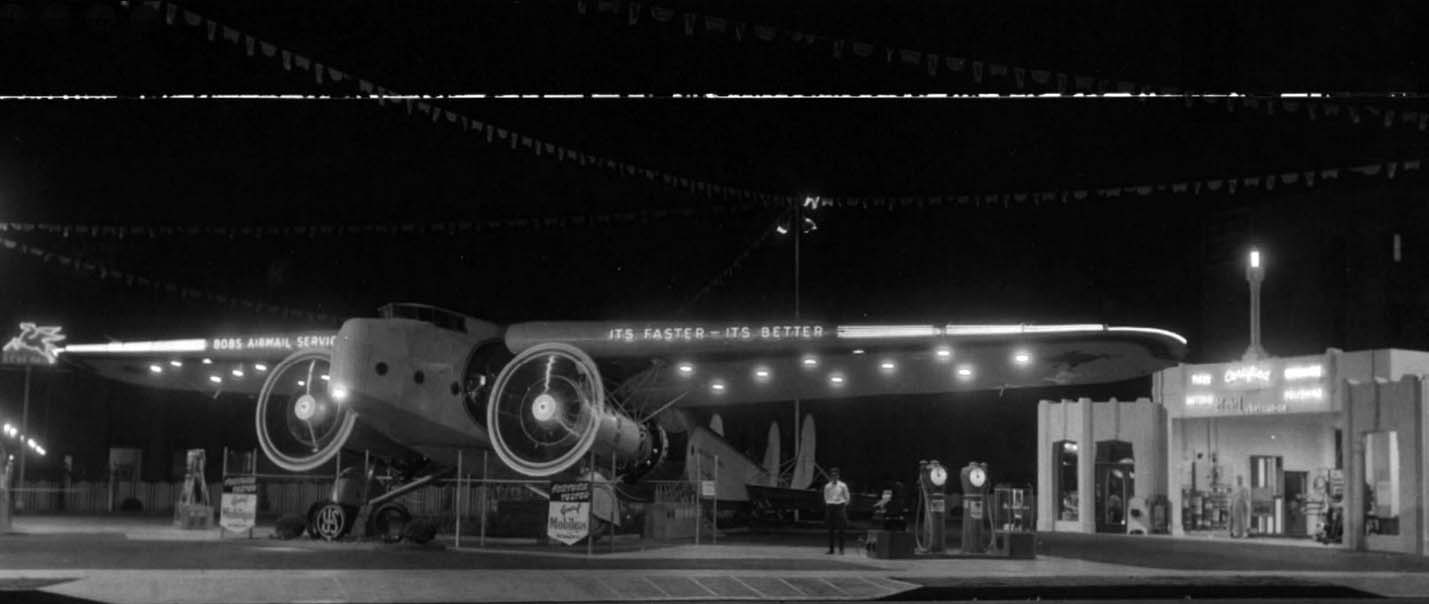 |
|
| (ca. 1938)* – Night view showing a man standing in between a Fokker F-32 aircraft with spinning propellers and the gas pumps at Bob's Airmail Service at 5453 Wilshire Boulevard. |
Historical Notes Click HERE to see more of the Fokker F-32 in Aviation in Early Los Angeles. |
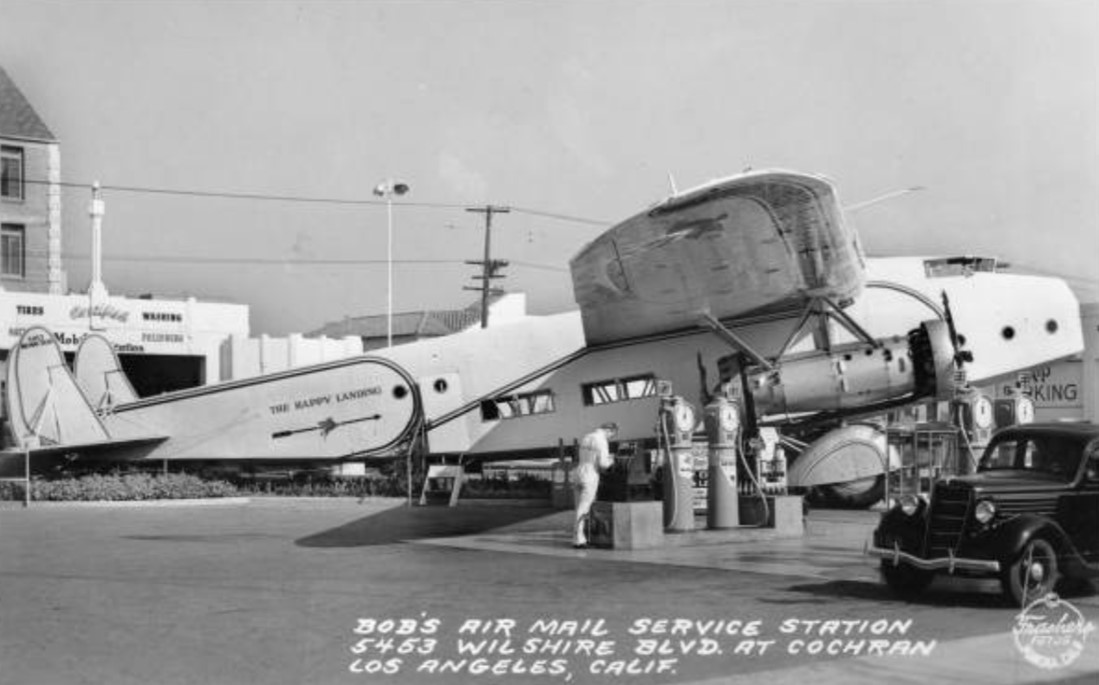 |
|
| (1936)* – Postcard view showing Bob's Airmail Service Station at 5453 Wilshire Boulevard. |
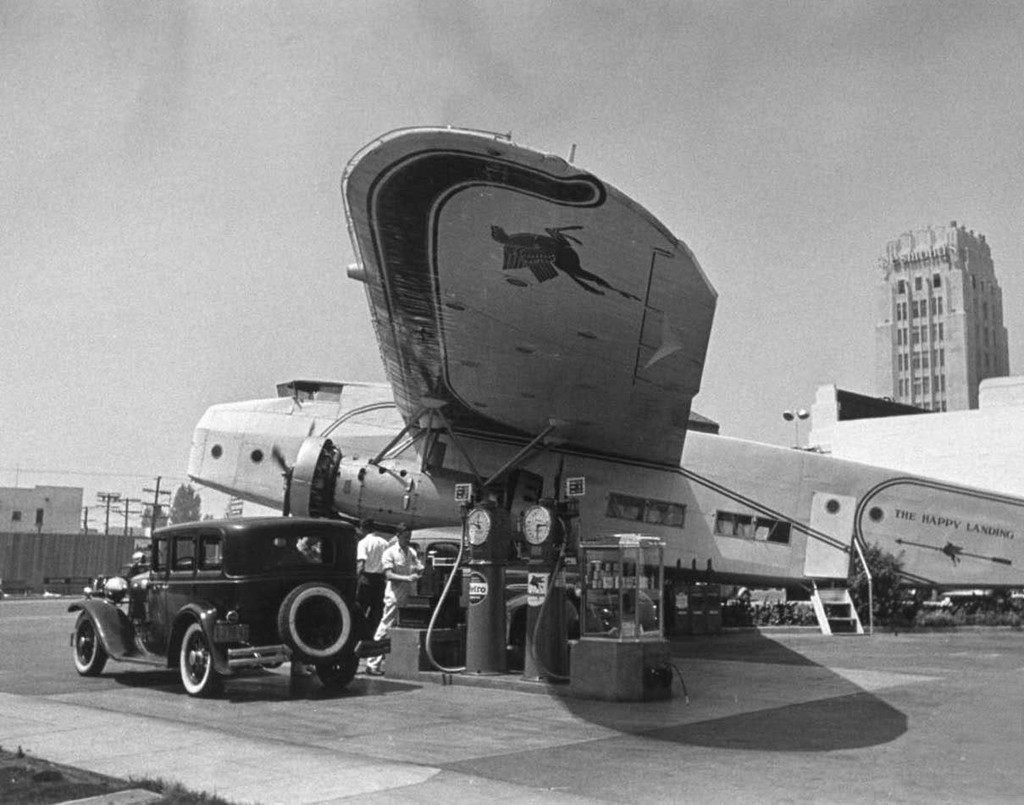 |
|
| (ca. 1936)* - Bob's Airmail Service Station on Wilshire. It almost appears as if the plane's propellers are moving. The aircraft's wing serves as a canopy over the gas pumps. In the background can be seen the Wilshire Tower Building with the name Desmonds just visible on the top. |
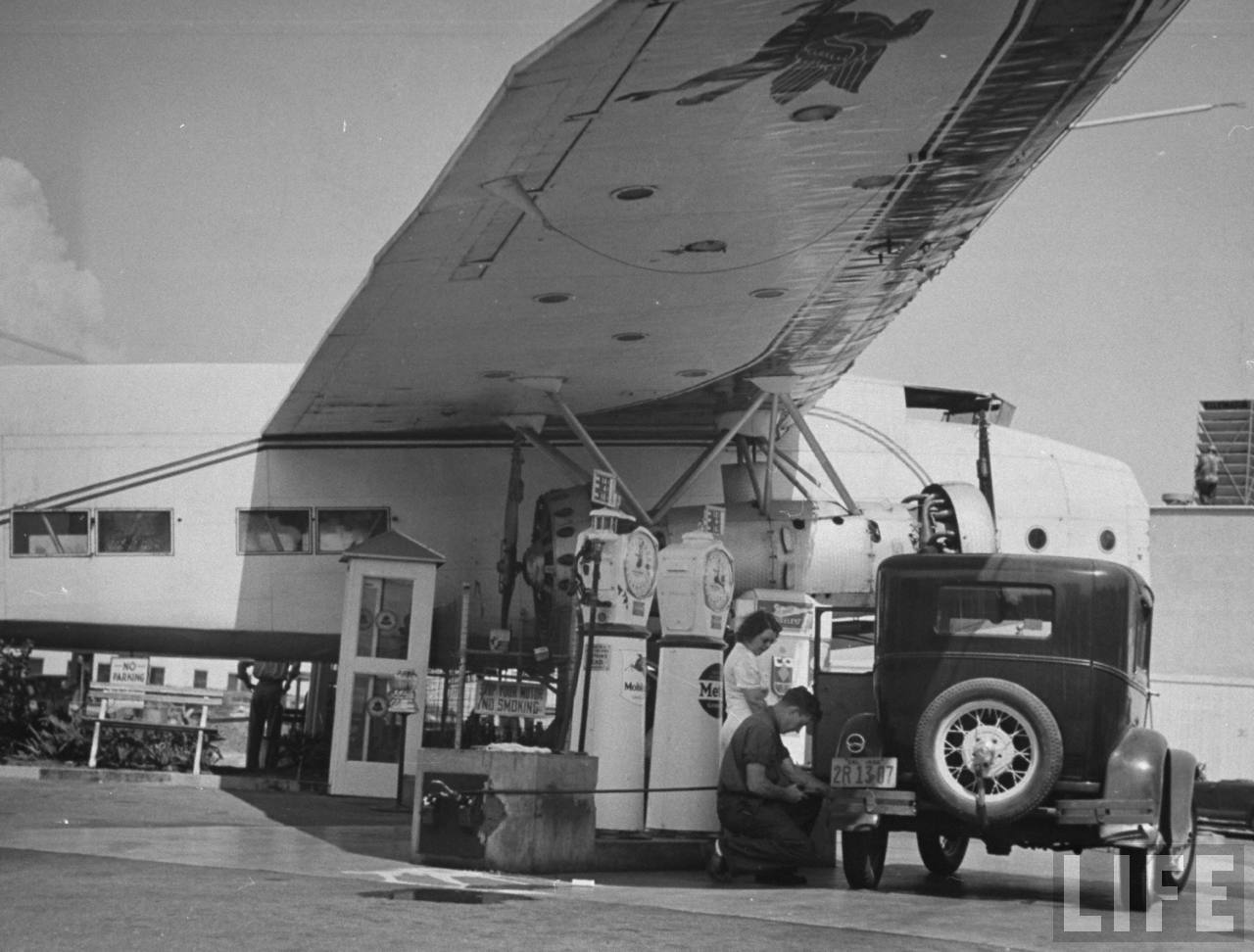 |
|
| (ca. 1936)* – An attendant checking the tire pressure as a woman looks on at Bob’s Airmail Service Station on Wilshire Boulevard. |
* * * * * |
Pitkin Brothers Service Station (E. Valley Blvd and N. Marianna Ave)
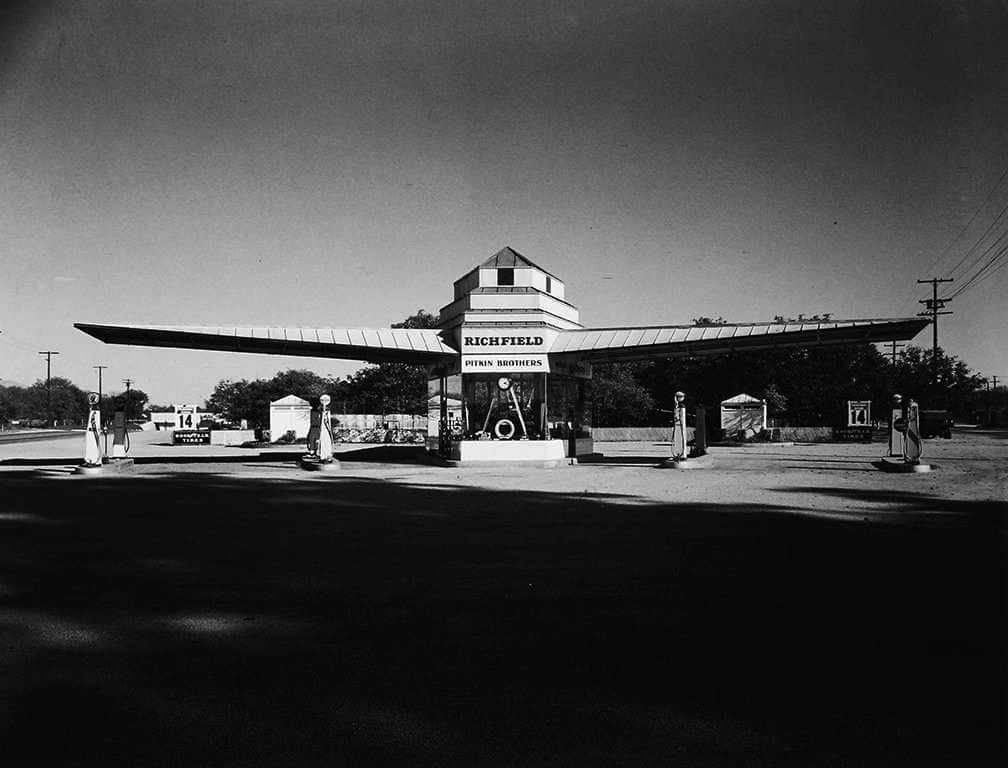 |
|
| (1938)^ – View showing Pitkin Brothers Service Station located at 1101 E. Valley Boulevard (El Monte, Los Angeles County). The building looks like a very large bird that’s about to take off. Photo by Julius Shulman |
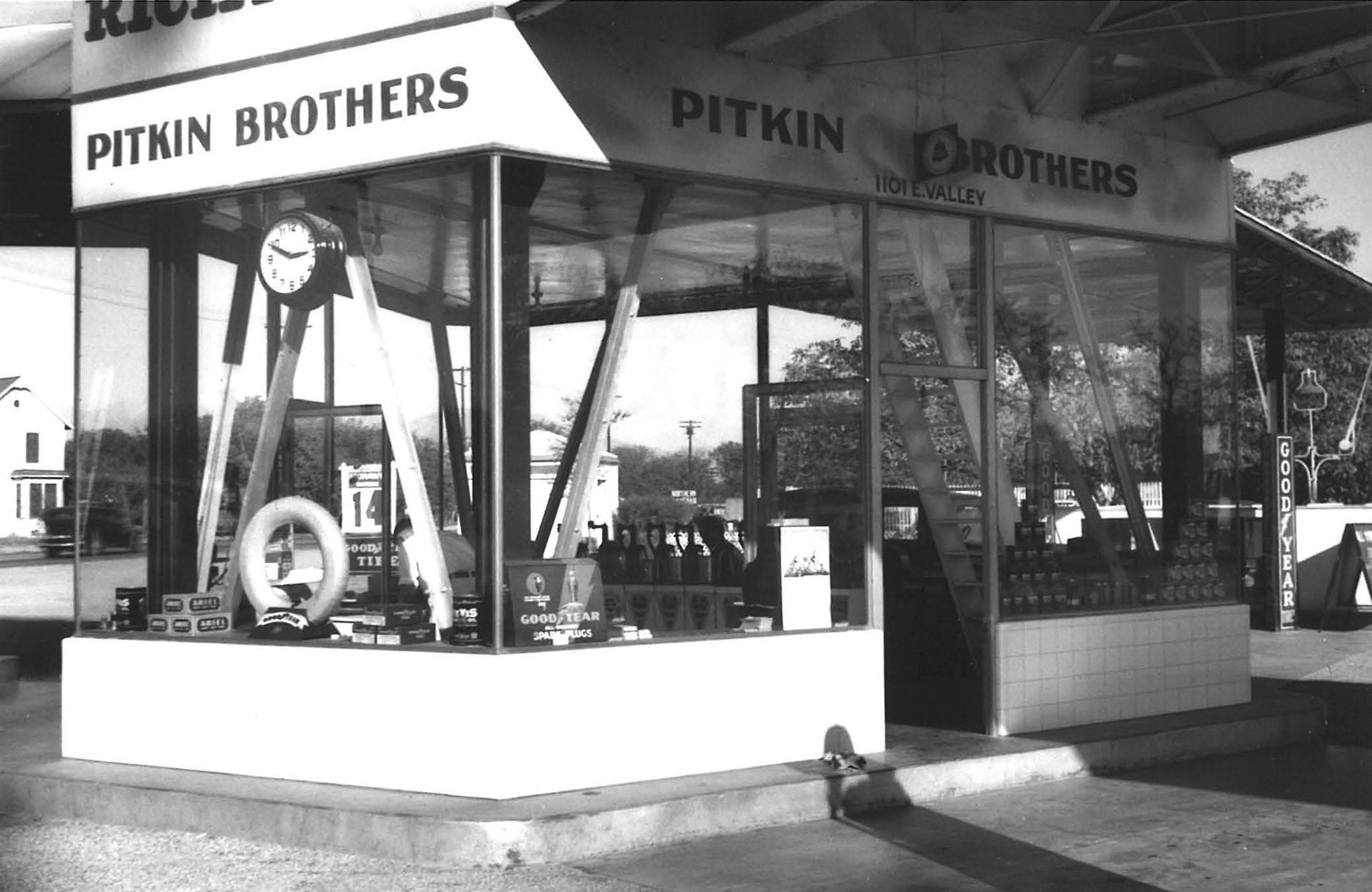 |
|
| (1938)^ – Close-up view showing the office at Pitkin Brothers Richfield Gas Station. Gas is selling for 14¢ per gallon. Both Good Year tires and Good Year spark plugs are being sold here. |
* * * * * |
Standard Station (Huntington Beach)
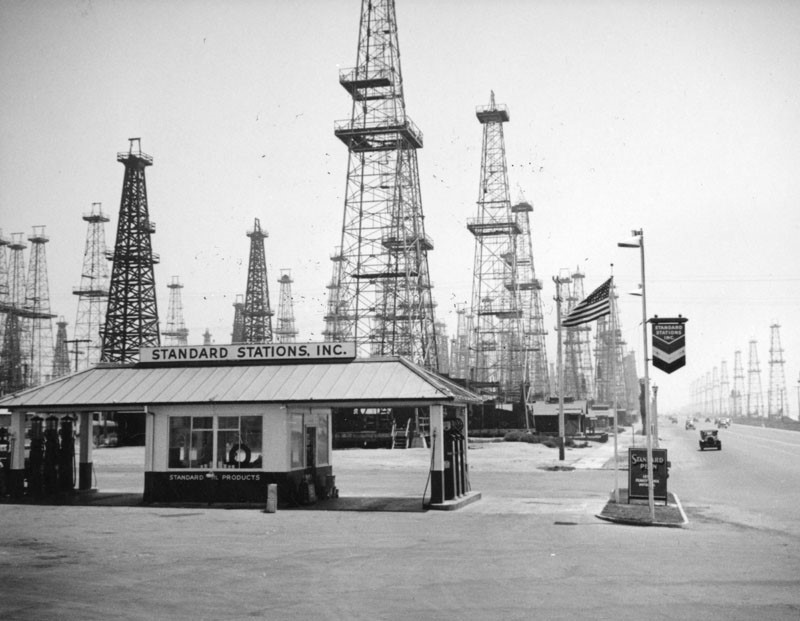 |
|
| (ca. 1937)^ - View of the Standard Stations, Inc. service station in Huntington Beach. A large oil field is seen in the background. |
* * * * * |
Topanga Service Station (Topanga and PCH)
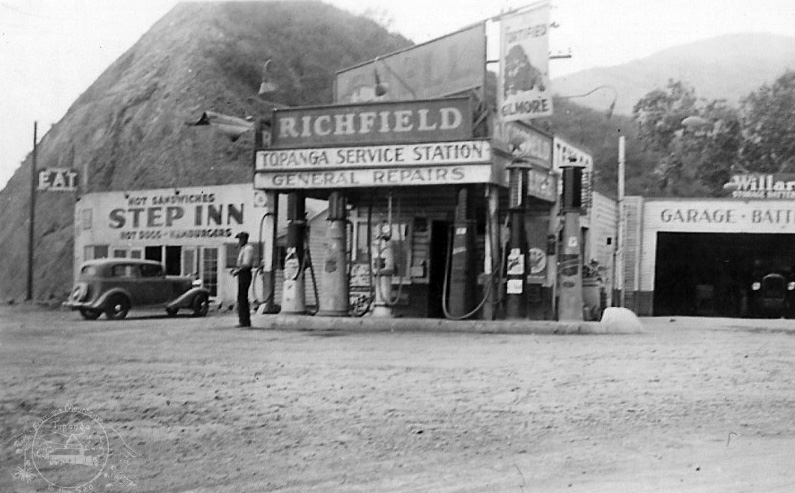 |
|
| (ca. 1939)^ - Postcard view showing a man standing in front of a Richfield Service Station located on the corner of Topanga Canyon and Pacific Coast Highway. A small diner is seen adjacent to the station. Click HERE to see what stands at the corner today. |
* * * * * |
Reliable Gasoline (Vernon and Alameda)
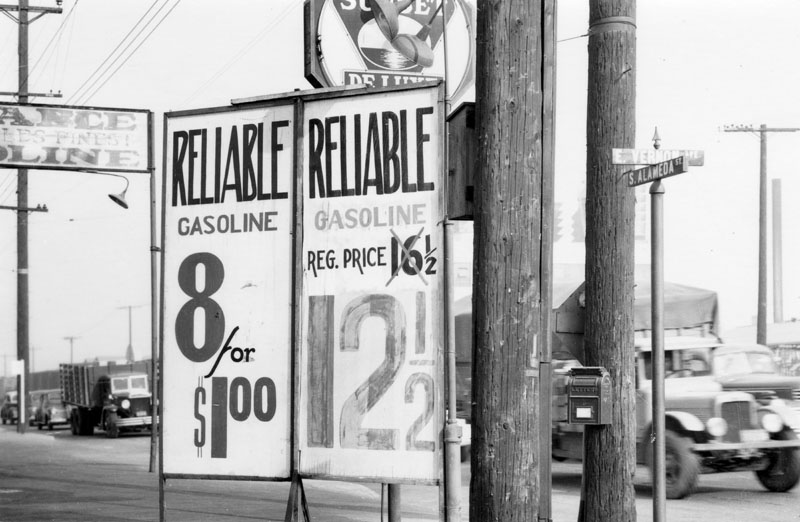 |
|
| (1941)* - Reliable Gasoline offered full service at just 8 gallons for $1 (12½¢ per gallon) at this station on the northwest corner of E. Vernon Avenue and S. Alameda Street. Today, the same corner is home to a Sinclair station where gas sells for $4.49 per gallon—self-serve. |
Historical Notes In 1941, gasoline prices in Los Angeles were typically around 15 to 20 cents per gallon, which was in line with the national average at the time. This period was characterized by stable prices, as gasoline was both locally produced and widely available before the onset of World War II rationing. While modern nostalgia often references prices like 29 or 39 cents per gallon, these figures are from later decades and not representative of the early 1940s. When adjusted for inflation, those seemingly low prices would equate to several dollars per gallon today, highlighting how the real cost of gasoline has changed over time. |
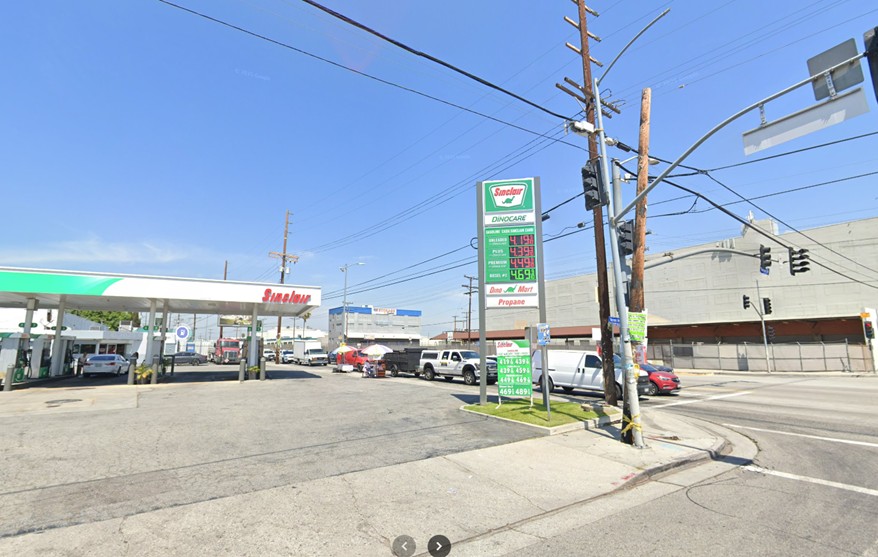 |
|
| (2025)* – Contemporary view of the Sinclair Gas Station now occupying the northwest corner of E. Vernon Avenue and S. Alameda Street, where Reliable Gasoline once stood. |
Then and Now
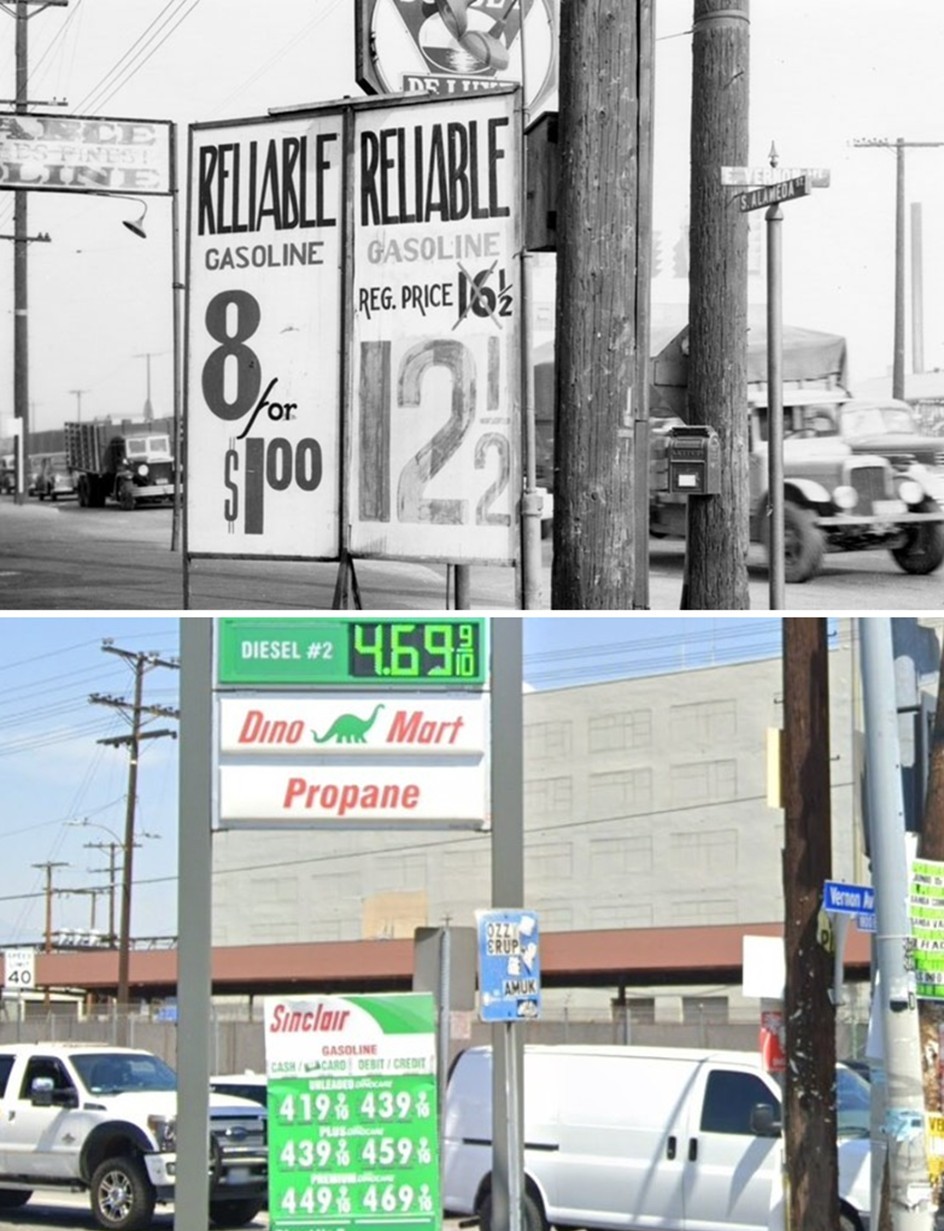 |
|
| (1941 vs. 2025)* – Gas prices at the same corner, 84 years apart. Reliable Gasoline once stood at the northwest corner of Vernon Avenue and Alameda Street—today, it’s a Sinclair station. Photo comparison by Jack Feldman. |
* * * * * |
Flying A Gas Station (Burbank)
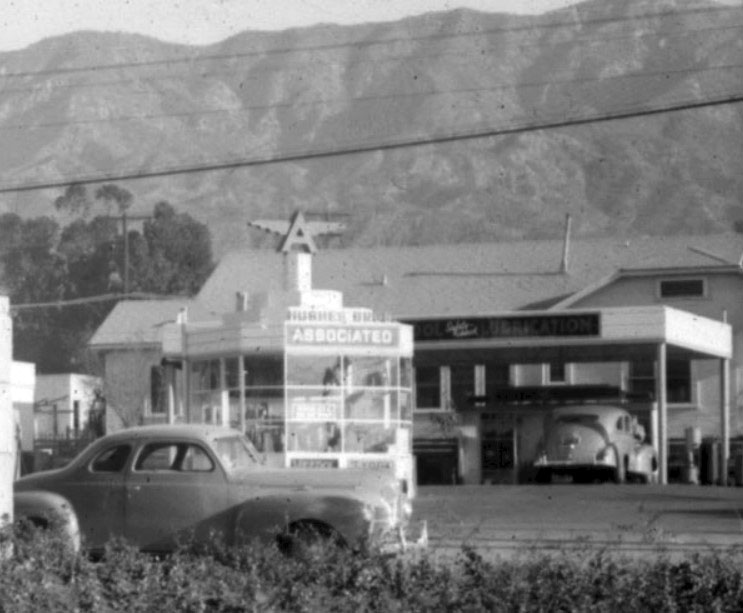 |
|
| (1940s)^ – View looking north showing the Hughes Brothers Gas Station with its Flying A sign located at 3rd Street and Olive Avenue in Burbank with the Verdugo Mountains in the background. |
* * * * * |
Richfield Gas Station (Pasadena)
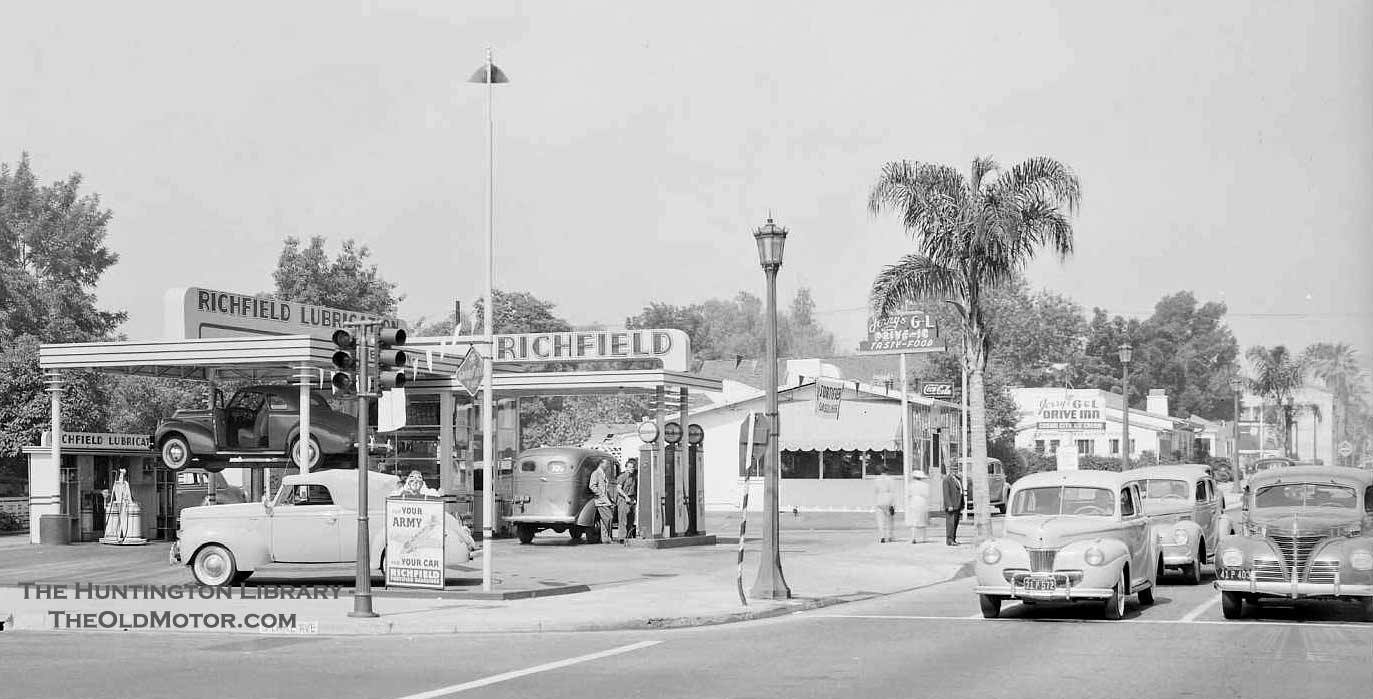 |
|
| (1941)* - A Richfield Gas Station located on the SW corner of Lake Ave and E. Green St (East California Blvd?). See notes below. |
Historical Notes Members of the Facebook group ‘You Know You Are from Old School Pasadena…’ disagree with the original location stated in the Huntington Library source. The majority opinion is that the station was actually located at Lake Ave and Green Street. Despite some conflicting evidence, we lean towards Green Street as the correct location instead of California Street. More details to come. |
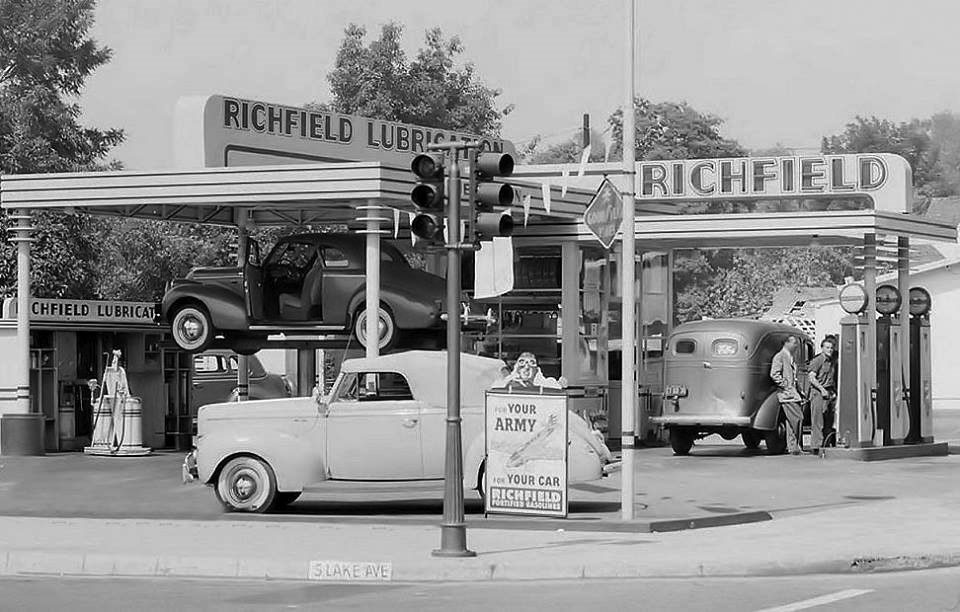 |
|
| (1941)^ – Close-up view showing the Richfield Gas Station on S. Lake Ave in Pasadena. Sign on corner reads: “For Your Army and For Your Car – Richfield" |
* * * * * |
Melrose Motor Service (Melrose near Fairfax)
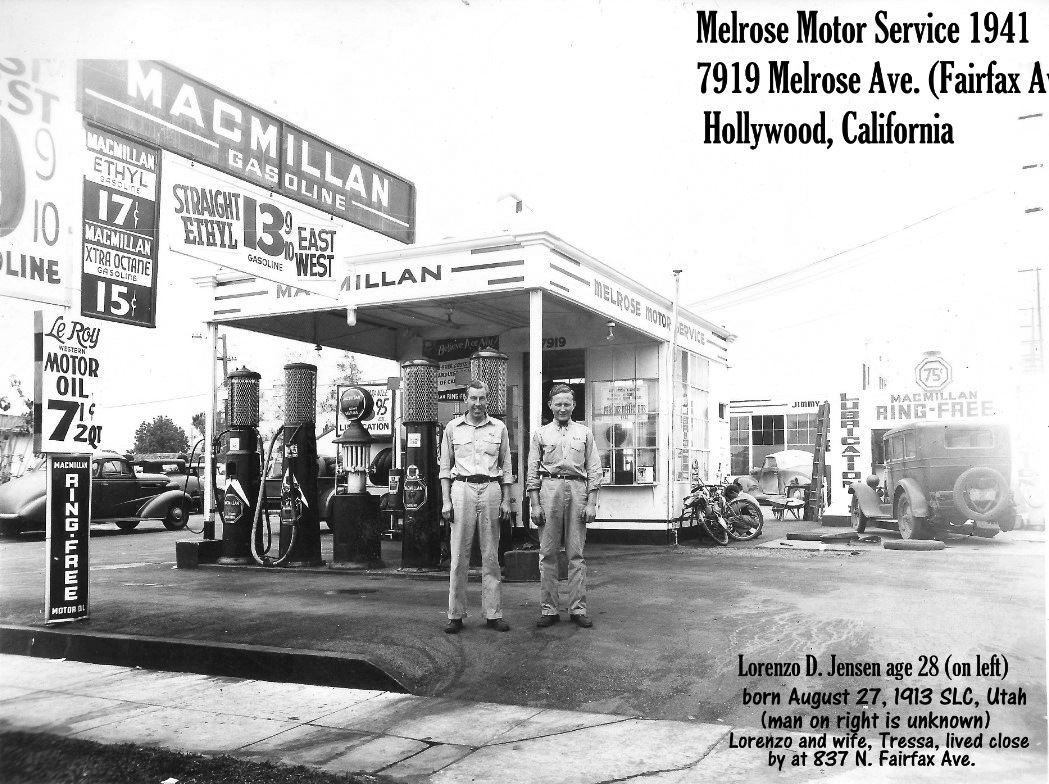 |
|
| (1941)* – View showing Lorenzo D. Jensen (left) standing next to another young man (unidentified) in front of the Melrose Motor Service Station located at 7919 Melrose Avenue. The station sold MacMillan Gasoline and MacMillan ‘Ring-Free’ Oil. Note the gas prices: 15¢ and 17¢ per gallon! |
Historical Notes *The above photo was donated by Mrs. Joy (Jensen) Feist who wrote: I’m a lover of history and a preservationist at heart. I was born in the Good Samaritan Hospital and raised in Los Angeles and the San Fernando Valley. I have several photographs of the Melrose Motor Service Station once located at 7919 Melrose Ave at Fairfax Ave. My father worked there until the Japanese bombing of Pearl Harbor on Dec. 7th 1941 when everything changed! After the war our family moved from Los Angeles to the San Fernando Valley. My parents loved photography and documented our family life with their trusty Kodak box camera purchased in 1937 at the Vista House on the Columbia River. I hope the attached photo will find preservation in your archives and be of interest to others who also love and value history. Incidentally, both my parents lived long and healthy lives. My father passed at age 94 and my mother at age 99. Both of them were active and mentally sound right up to their passing. They were married for almost 73 years! |
* * * * * |
Melrose-Sweetzer Service Station
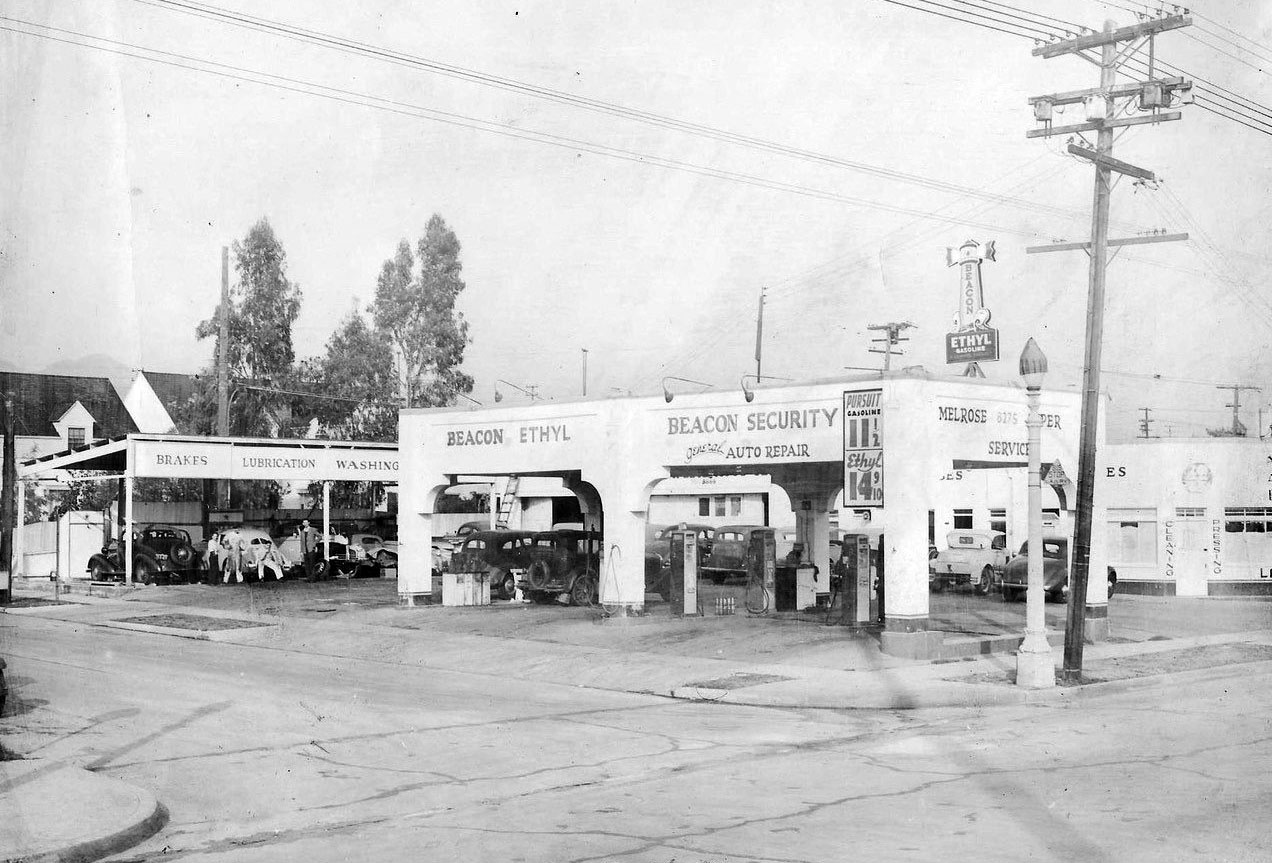 |
|
| (1942) – View showing the Melrose-Sweetzer Service Station located at 8275 Melrose Avenue, N/E corner of Melrose and Sweetzer. Beacon Gas and Ethyl is going for 11½¢ and 14½¢ per gallon respectively. Photo Courtesy of Chris Dubuque |
Historical Notes Note the streetlight on the corner with what appears to be a cap or hood on top of the light bulb. During World War II many streetlights throughout the City were blacked-out on top as a preventative measure. Click HERE to see more in Early LA Streetlights. |
.jpg) |
|
| (1942) – Mechanic working on one of several cars in the service area behind the Melrose-Sweetzer Service Station. Photo Courtesy of Chris Dubuque |
Historical Notes This business was initially a gas station and auto repair facility called Melrose-Sweetzer Service but became a car dealer named Challenger Motors soon after the above photo was taken. Today an office building stands at this corner. Click HERE for contemporary view. |
* * * * * |
Victory Girls Gas Station (8th and Alvarado)
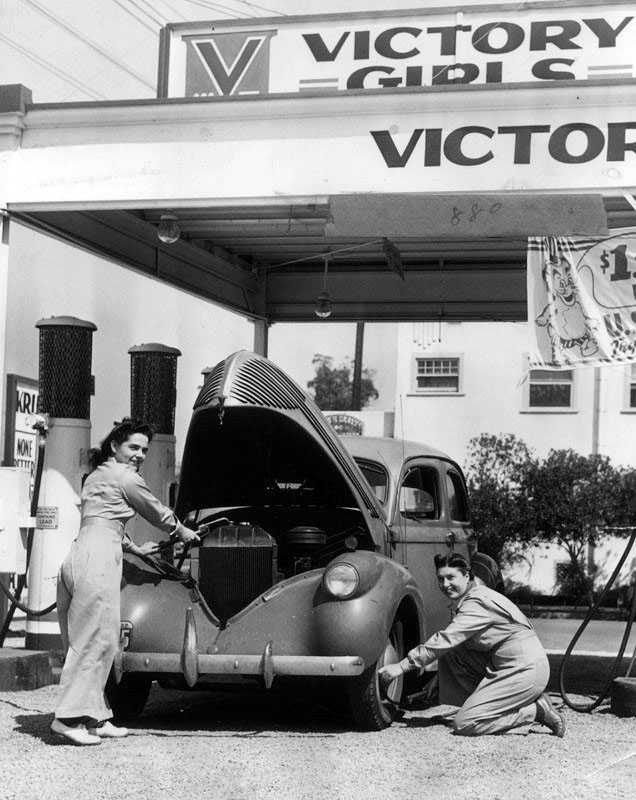 |
|
| (1942)^ - "Check your air, mister?" Nina Meloni, manager of the Victory Girls' gas station, and Verda Curtis, putting air in tires, work at the modern service station at 8th and Alvarado Streets, during World War II. Photo date: May 14, 1942. |
* * * * * |
Fairchild’s Mohawk Semi-Self Service (Ventura and White Oak)
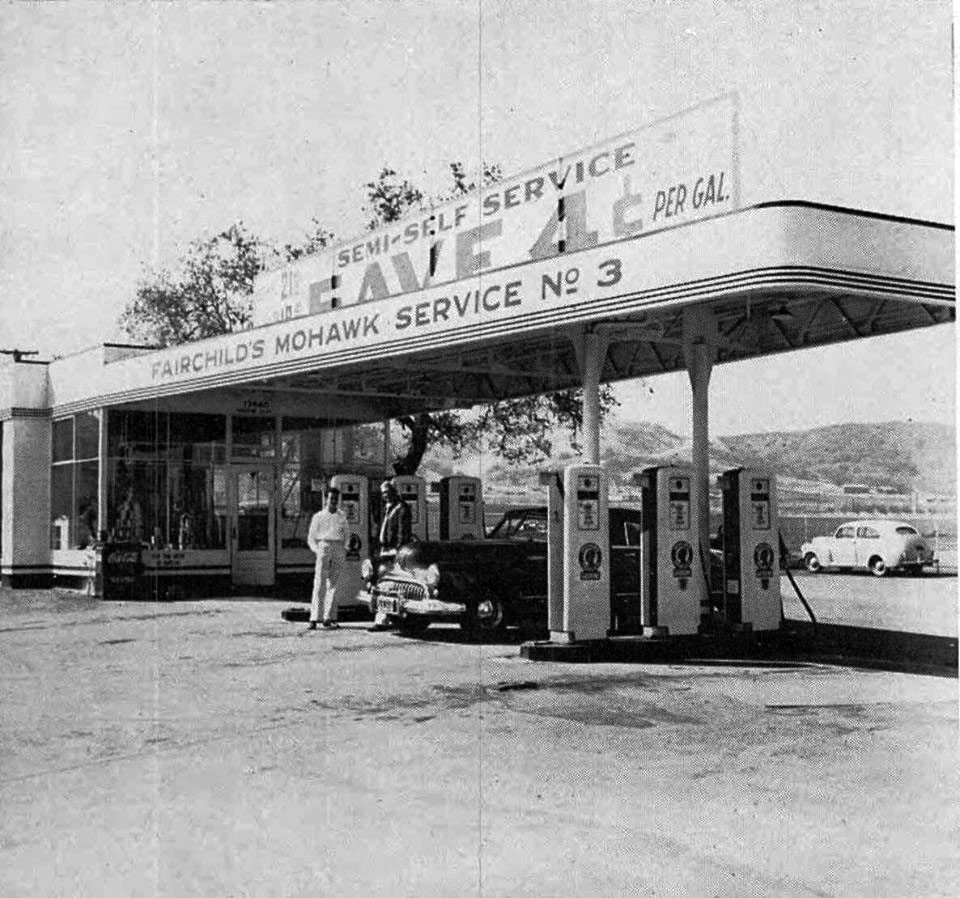 |
|
| (1948)#^*^ - View showing Fairchild’s Mohawk service station located at 17660 Ventura Blvd (at White Oak) in Encino. Actually, it is a "semi-self service" station, where you save 4 cents per gallon by pumping your own gas. Here we see customer Stanley Kalmonivitz with Mr. Fairchild. |
* * * * * |
Associated Gas Station (Ventura and Topanga)
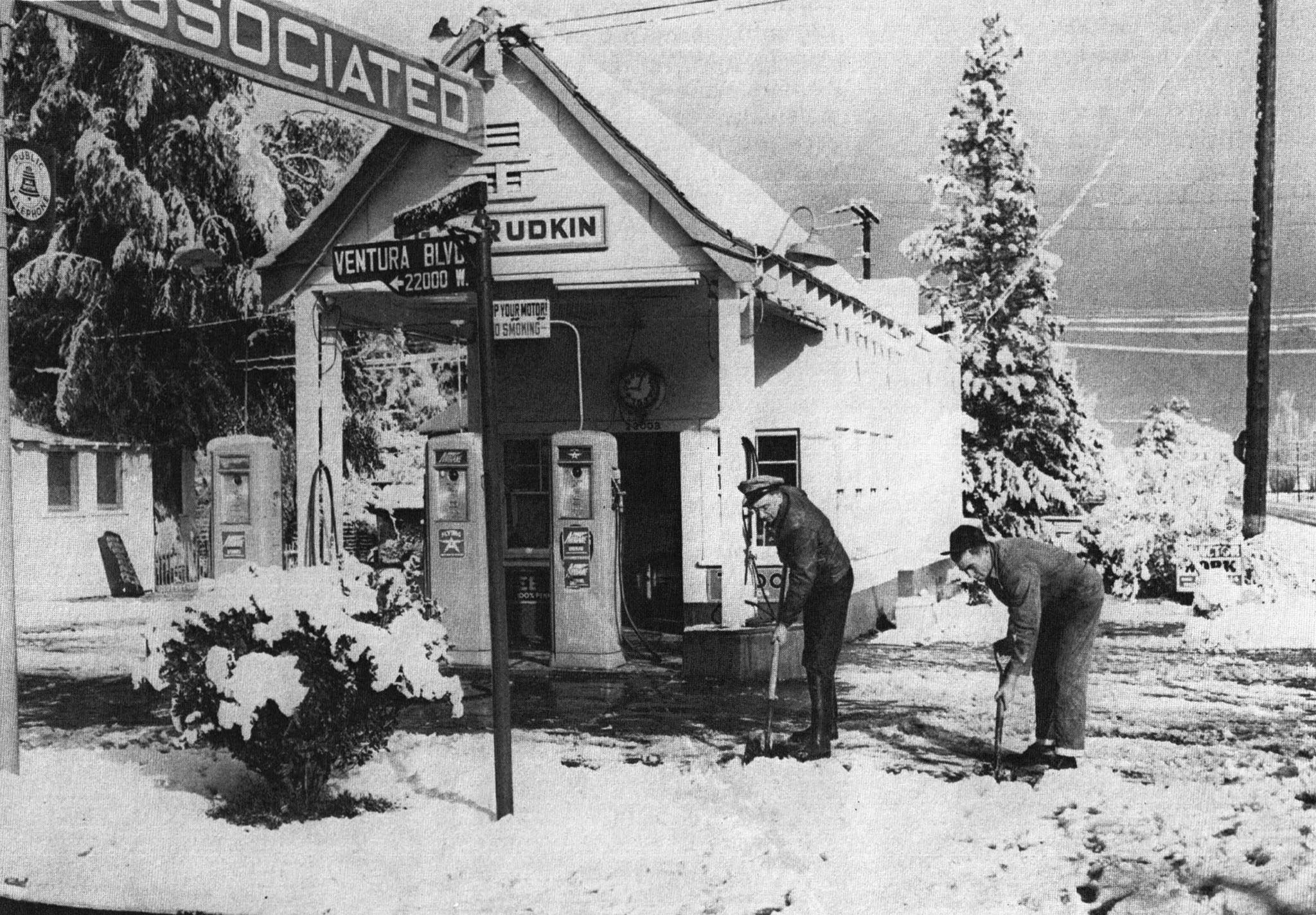 |
|
| (1949)#^*^ – View showing two men shoveling snow in front of an Associated Gas Station located on the NW corner of Topanga & Ventura boulevards. Photo date: Jan 12, 1949. Today, a Chase Bank stands at this corner. |
Historical Notes Snow fell in the San Fernando Valley and in most of Southern California during a 3-day storm from Jan 9 through Jan 12, 1949, which is a rare occurance. Click HERE to see more on the Storm of 1949. |
* * * * * |
Texaco Service Station and Carwash (Wilshire and Willaman)
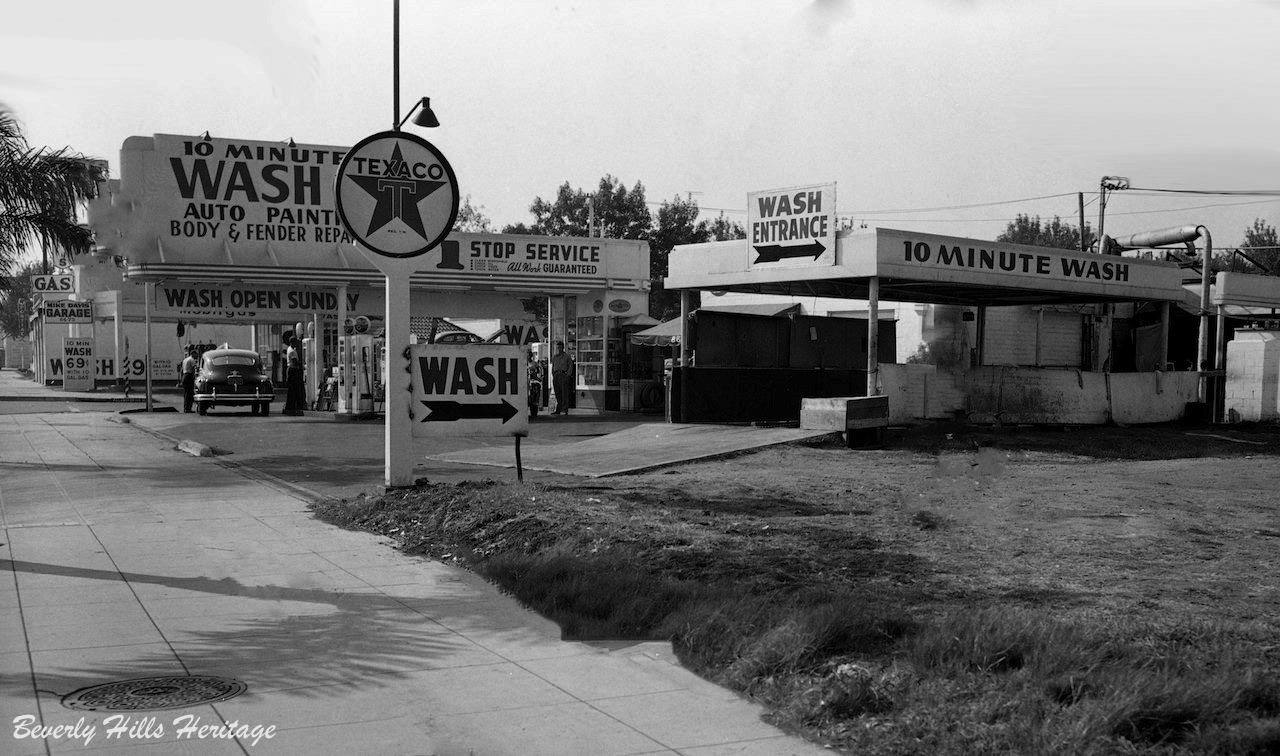 |
|
| (1947)##^^ – Texaco Service Station at Wilshire Boulevard and Willaman Drive providing ‘1 Stop Service’: Gas, Body & Fender Repair, and a 10 Minute Carwash. |
* * * * * |
Associated “Flying A” Service Station (Wilshire and Santa Monica)
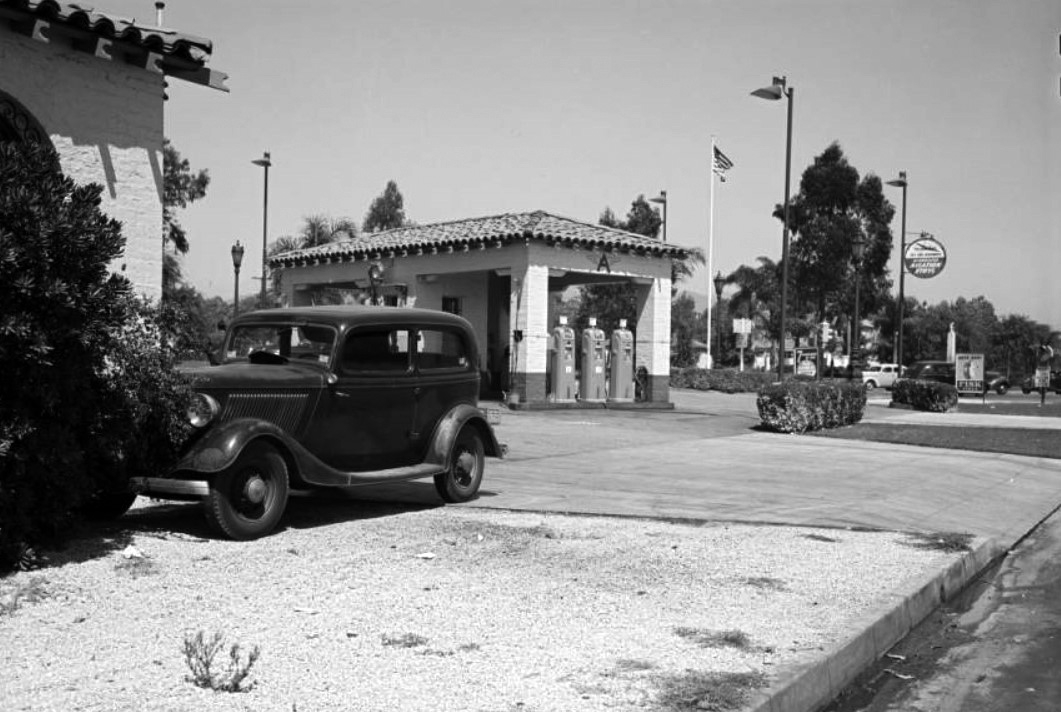 |
|
| (1940)^^ – View looking northeast showing an Associated “Flying A” Service Station located on the S/W corner of Wilshire and Santa Monica boulevards in Beverly Hills. Across the street in the distance (right-center) can be seen the iconic Beverly Hills Electric Color Fountain. Photo by Dick Whittington |
Historical Notes Associated Oil Company was an American oil and gas company once headquartered in San Francisco and served much of the Pacific West Coast, including Hawaii, as well as the Orient and merged with the Tidewater Oil Company in 1938.*^^ |
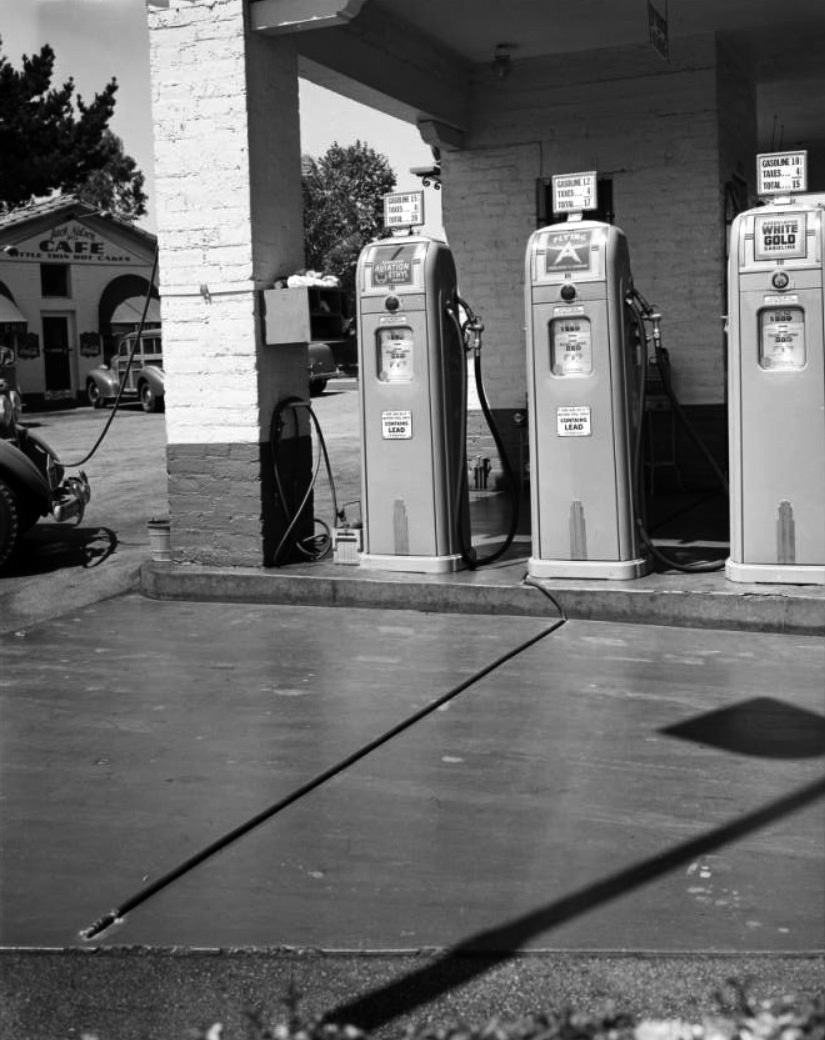 |
|
| (1940)^^ – Closer view showing the pumps at the "Flying A" Associated service station with Cafe in background, corner of Wilshire and Santa Monica. Gas prices: 15¢ - 17¢ - 20¢ per-gallon. Note the signal bell hose in the foreground. Photo by Dick Whittington |
* * * * * |
Associated “Flying A” Gas Station (Beverly Hills)
 |
|
| (1941)^v^ – View showing the Flying "A" gas station located at 400 Rexford Drive, across from the Beverly Hills City Hall. |
Historical Notes The station was built on a portion of the original Sun Lumber Company that once dominated the area. Today, the site is the south wing of the Beverly Hills Public Library. Click HERE for contemporary view. |
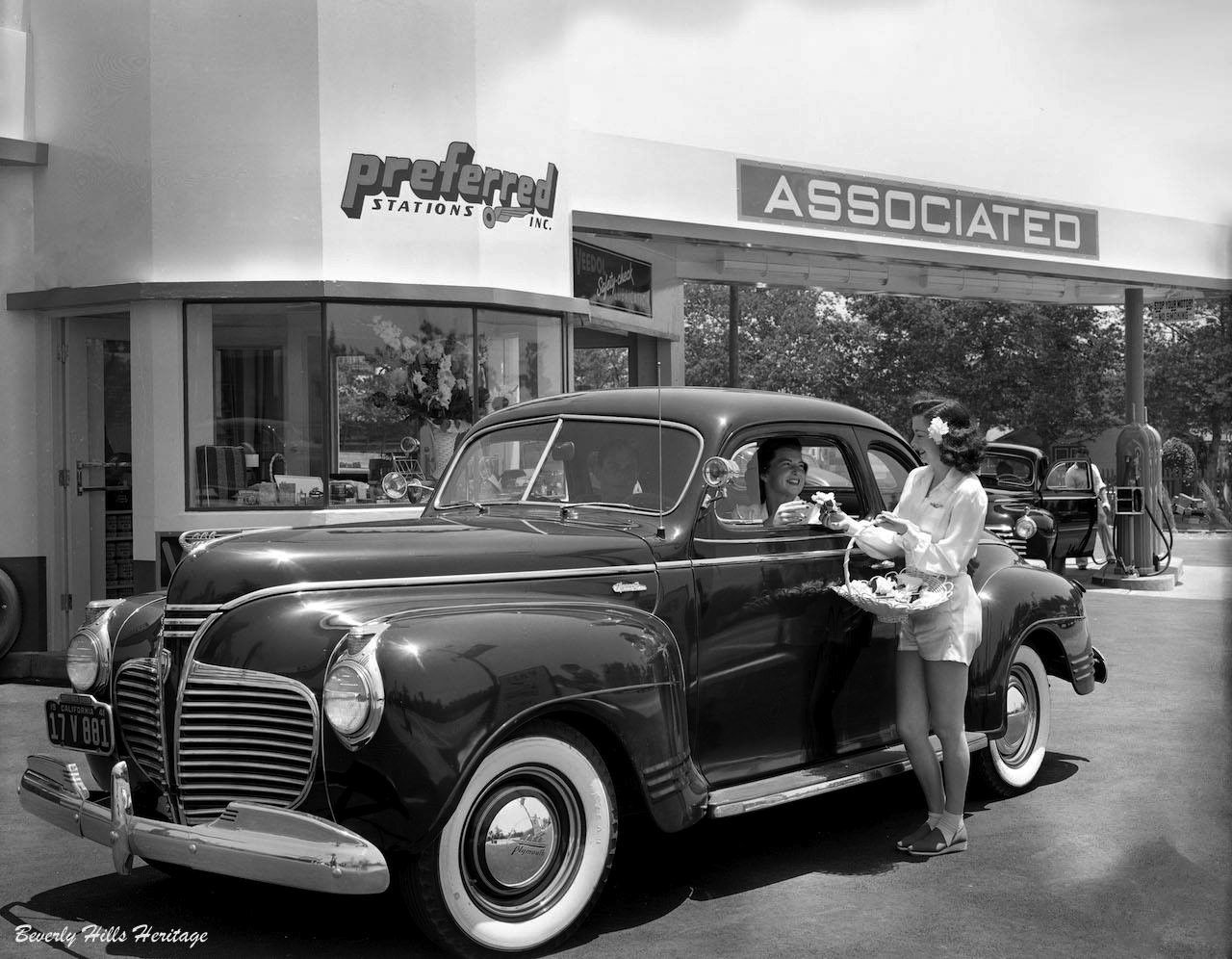 |
|
| (1941)*X^ - Service with a smile and a gardenia flower is how it was done at this Associated Gas Station in Beverly Hills. This classic filling station stood at on the northeast corner of Rexford Drive and Burton Way. |
* * * * * |
Associated Oil Company Gas Station
 |
|
| (ca. 1930s)^^# – View showing an Associated Oil Company gas station whose premium gasoline was sold under the Flying-A brand. Taking a cue from drive-in restaurants, the building has a flying-saucer awning and glowing centerpiece for added height and visibility. |
Historical Notes In 1936, the separate companies, Associated Oil Company and Tide Water, were dissolved into the holding company, now renamed Tidewater Associated Oil Company. Associated was based in San Francisco with a market area limited to the Western United States. Associated, founded in 1901, had created the prominent Flying A brand for its premium-grade gasoline in 1932. With the merger and creation of Tidewater Associated Oil Company, Flying A became the primary brand name for the company, though the Tydol and Associated names were also retained in their respective marketing areas. During the 1950s, the Associated and Tydol brands gradually fell into disuse, and were dropped entirely in 1956.*^^ |
* * * * * |
Mark C. Bloome Tires and Gas Station (Hollywood)
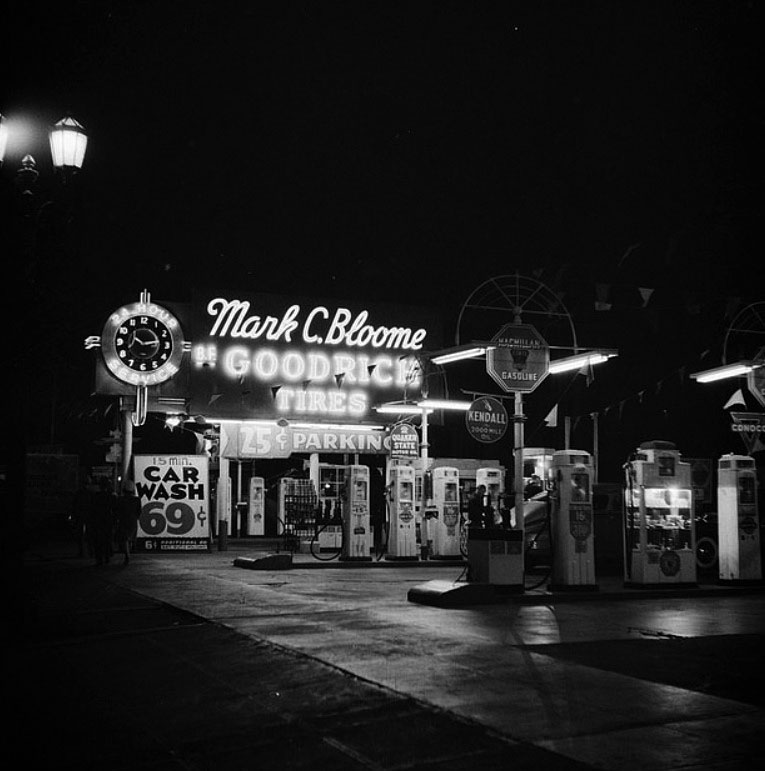 |
|
| (1942)+# – View showing the Mark C. Bloome Service Station located at 6210 Sunset Boulevard in Hollywood. This service station was on the S/W corner of Sunset and El Centro Avenue, just about opposite the Hollywood Palladium. The Earl Carroll Theatre is just to the right (west) of the station. |
Historical Notes Mark C. Bloome immigrated to Southern California from Canada in 1924 and parlayed a 15-cent-a-gallon Richfield gasoline station into one of the nation's largest chain of tire stores. He survived the Depression years by offering glassware giveaways and other free premiums at his expanding chain of stations and at one point even had women on roller skates speeding among the pumps dispensing gasoline. By the 1950s, Bloome's stations numbered an even dozen and they were selling a broad range of tires from nearly all manufacturers. Customers were waiting in air-conditioned rooms while their cars were being serviced in giant bays a few feet away, a system that was a forerunner of the modern tire store. In 1972, the family sold the business to Petrolane Inc. and Bloome retired. In 1986, Goodyear purchased it. *^* |
* * * * * |
Union 76 Station (Monterey Park)
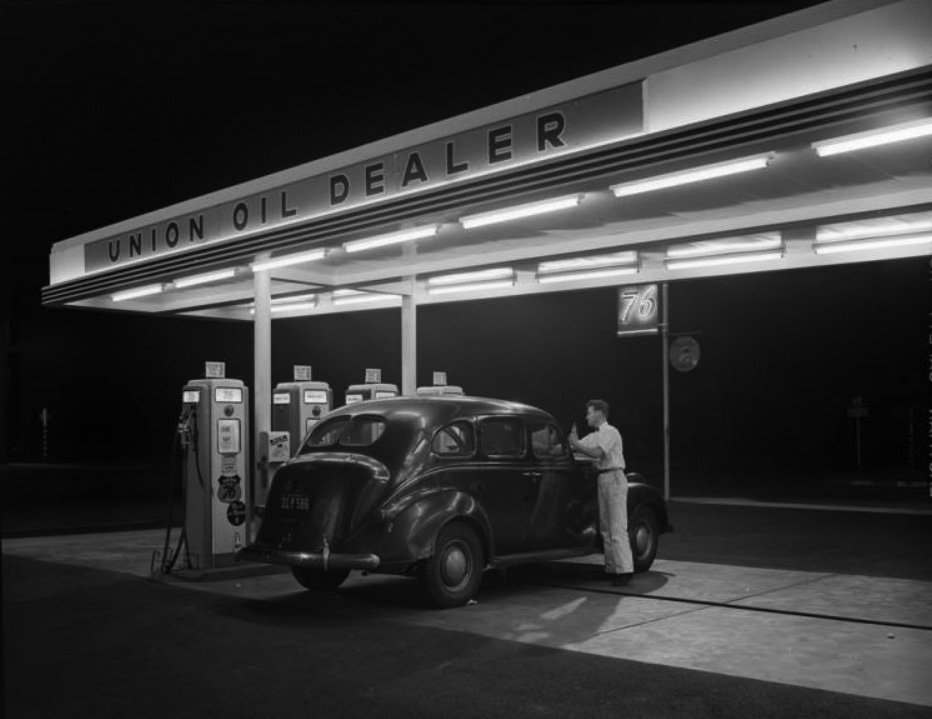 |
|
| (ca. 1942)#* - View showing an attendant cleaning a windshield at a Union 76 Station (Gribble Service Station, Monterey Park). |
Historical Notes Gas Stations used to be called service stations ... they would rush to your car, check the water and oil, put air in your tires, wash your windows, and pump your gas. |
* * * * * |
Union 76 Station (Wilshire Boulevard - LA)
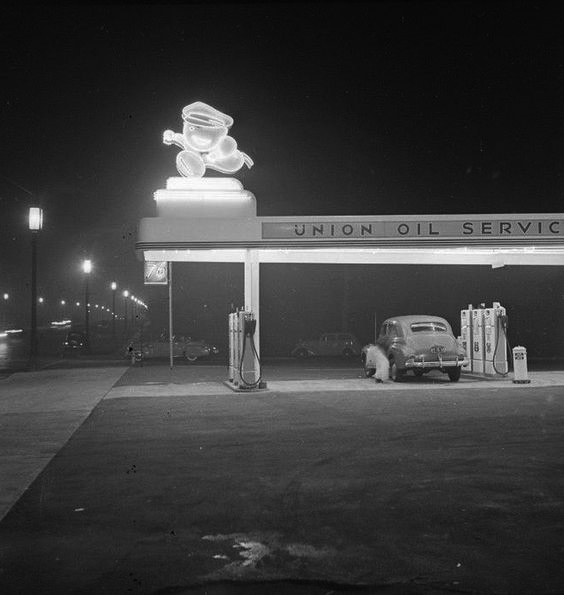 |
|
| (1940s)^.^ – A 1940 Chevrolet getting gas in a Union Oil service station on Wilshire Boulevard. Note the cute mascot lit up in neon on top of the canopy. |
Historical Notes If you look at the street lighting in this picture, you’ll see that the lamps are all the “Wilshire Specials” which became prevalent along Wilshire Blvd starting in 1928. |
* * * * * |
Union 76 (Pasadena)
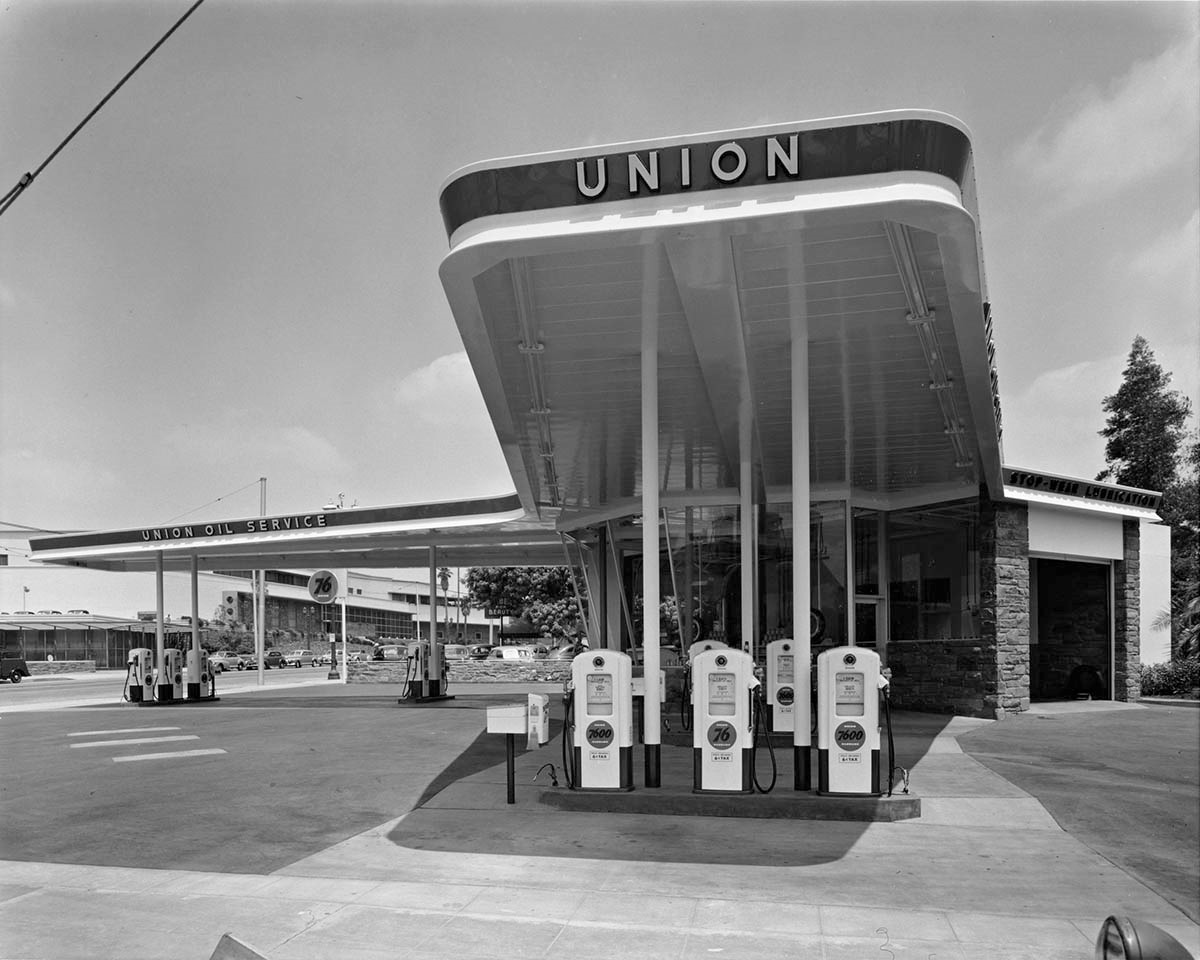 |
|
| (1949)* – View showing Union 76 Service Station located on the corner of San Pasqual Street and S. Lake Avenue in Pasadena. Bullock’s Department Store is seen in the background on the left. The building was designed by architect Raymond Loewy. Photo by Julius Shulman / Getty Research Institute |
* * * * * |
Gilmore Self-Service Gas Station (Beverly and Genesee)
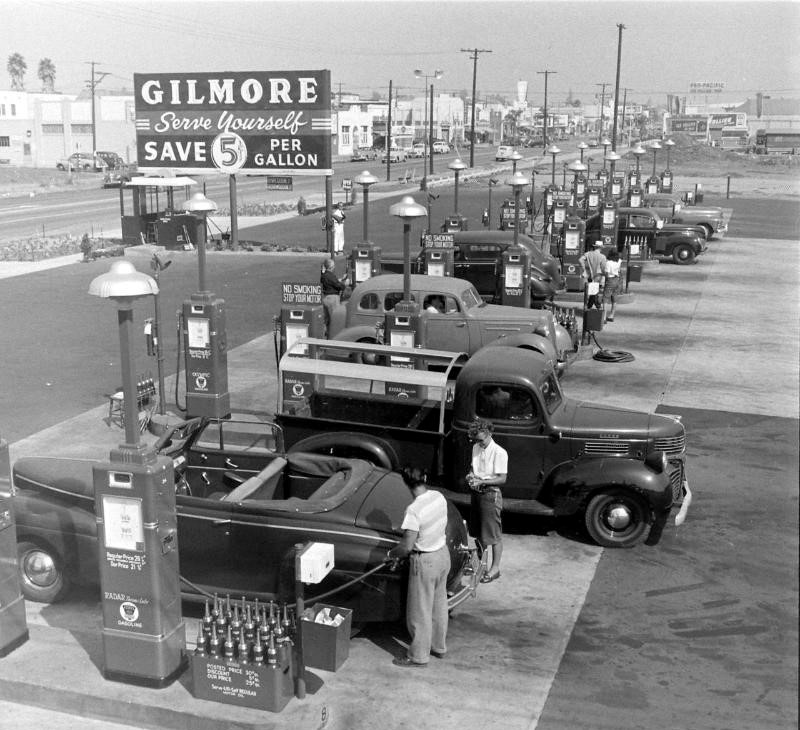 |
|
| (1943)* – Life Magazine cover photo showing Gilmore Self-Service Station where you could save 5¢ per gallon by filling the tank yourself. View is looking east on Beverly Boulevard with the Pan Pacific Theatre seen in the distance. |
Historical Notes This groundbreaking photo was on the cover of Life magazine in May 1943, capturing a moment of innovation in car culture. Earl B. Gilmore, president of Gilmore Oil Company, introduced the concept of the self-service gas station—dubbed a “Gas-a-teria”—not far from his family’s Farmers Market. Here, drivers could pump their own gas and save 5¢ per gallon—an unheard-of proposition at the time. For customers who preferred full service, young women attendants on roller skates offered a whimsical twist by gliding from car to car to pump gas and make change. Gilmore’s experiment prefigured the self-serve model that would later become standard across the country. |
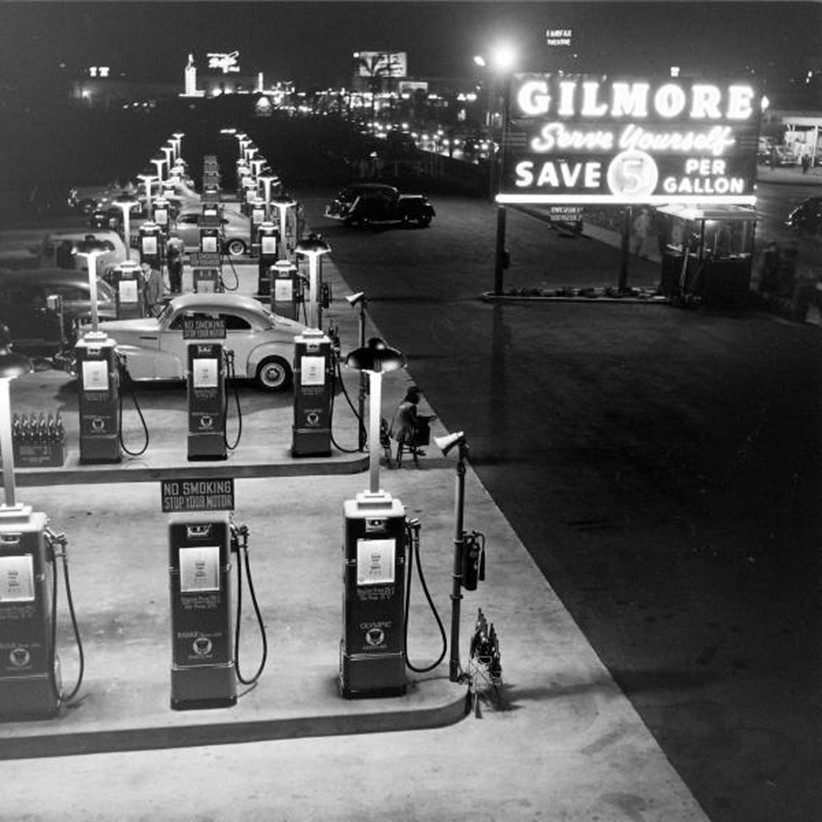 |
|
| (1948)* - Night view showing Gilmore Self-Service Station located on the south side of Beverly Boulevard east of Fairfax Avenue. View is looking west toward Fairfax. The Fairfax Theatre sign (northwest corner of Fairfax and Beverly) is seen above and behind the Gilmore sign. The tower sign for Herbert's Drive-In Restaurant (southeast corner of Fairfax and Beverly) can barely be made out in the upper left of photo. CBS Television City would be built at this corner in 1952. |
Historical Notes This spectacular 1948 night view showcases the Gilmore Self-Service Station—also known as the Gilmore “Gas-a-teria”—at its flagship location on the southeast corner of Beverly and Genesee. Facing west toward Fairfax Avenue, the photo captures both the Fairfax Theatre and the faint silhouette of Herbert’s Drive-In. Opened that same year, this was one of the earliest and largest self-service gas stations in the nation. With eight pump islands and the slogan “Serve Yourself – Save 5¢,” Gilmore’s futuristic vision of fueling became an immediate success. By 1952, the view seen here would change drastically with the construction of CBS Television City just across the street. |
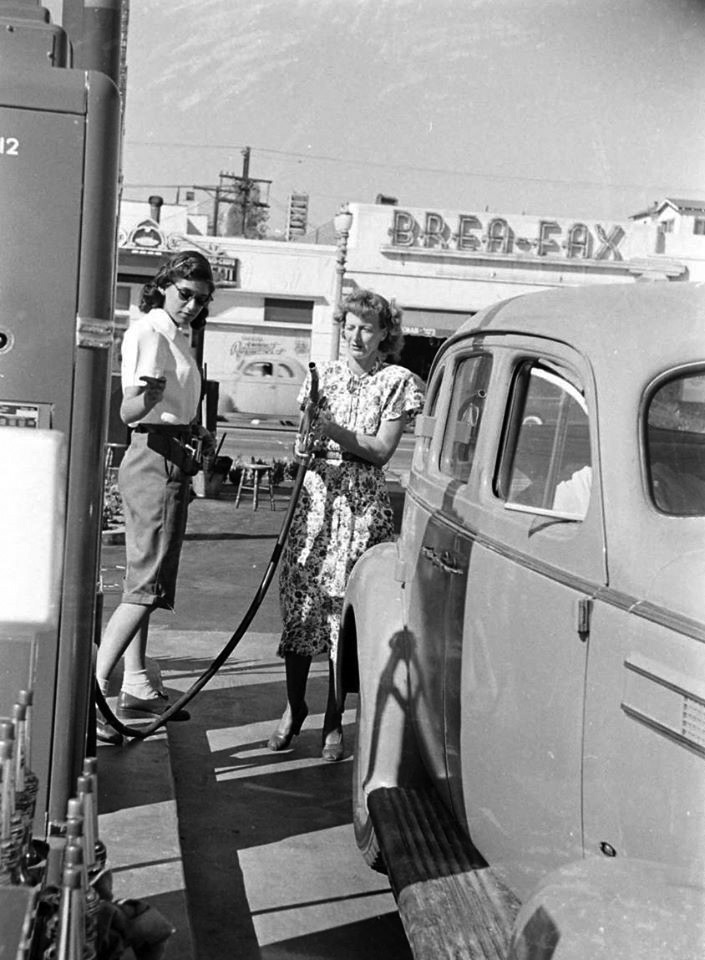 |
|
| (ca. 1948)* - How to self serve at Gilmore Gas. Brea-Fax Grocery Store can be seen across the street on the north side of Beverly Boulevard. |
Historical Notes This instructional image from around 1948 illustrates how customers used the self-service pumps at the Gilmore Gas-a-teria. The concept was simple: pump your own gas, check your oil, and save 5¢ per gallon. The Brea-Fax Grocery Store—visible across Beverly Boulevard—helped define this busy stretch just east of Fairfax. Gilmore’s station offered speed, savings, and autonomy in a postwar Los Angeles growing increasingly dependent on the automobile. The station’s design, with minimal canopy cover and streamlined layout, reflected a modern, efficient approach that would soon shape gas station architecture across the country. |
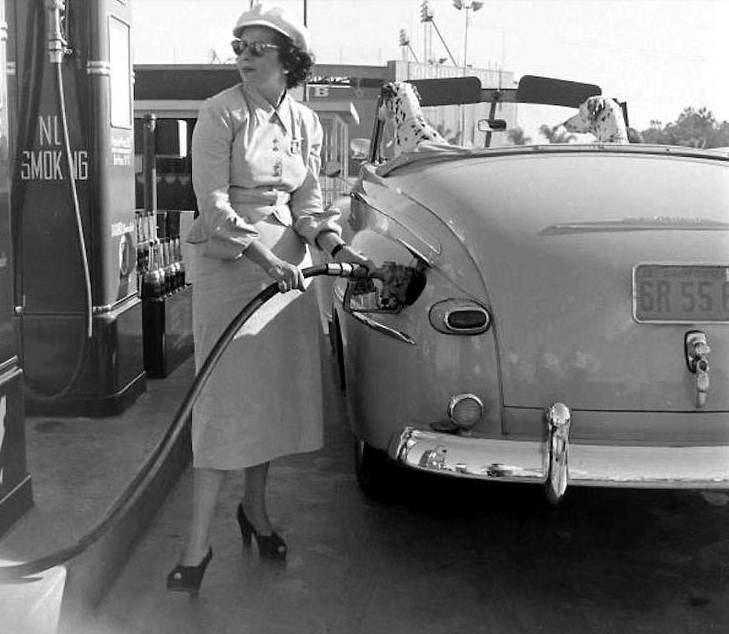 |
|
| (ca. 1948)* - A woman pumping fuel at the Gilmore ‘Self-Service’ Gas Station (one of the nation's first) near Fairfax and Beverly. Gilmore Field, the home of the Los Angeles Stars minor league team, is visible in the background. Note also the woman's two Dalmations at attention in the car. Photo Credit: Vintage Los Angeles. |
Historical Notes Captured around 1948, this image shows a woman refueling at the Gilmore Self-Service Station, with her two Dalmatians looking on from the car. In the distance stands Gilmore Field, home of the Los Angeles Stars, and part of what was then known as “Gilmore Island”—a cluster of attractions that included Gilmore Stadium, a drive-in theater, and the Original Farmers Market. The Gas-a-teria embodied Gilmore’s blend of practicality and flair: drivers pumped their own gas, or received full service from attendants on roller skates. For many Angelenos, this site wasn’t just about gasoline—it was about lifestyle and modern convenience. |
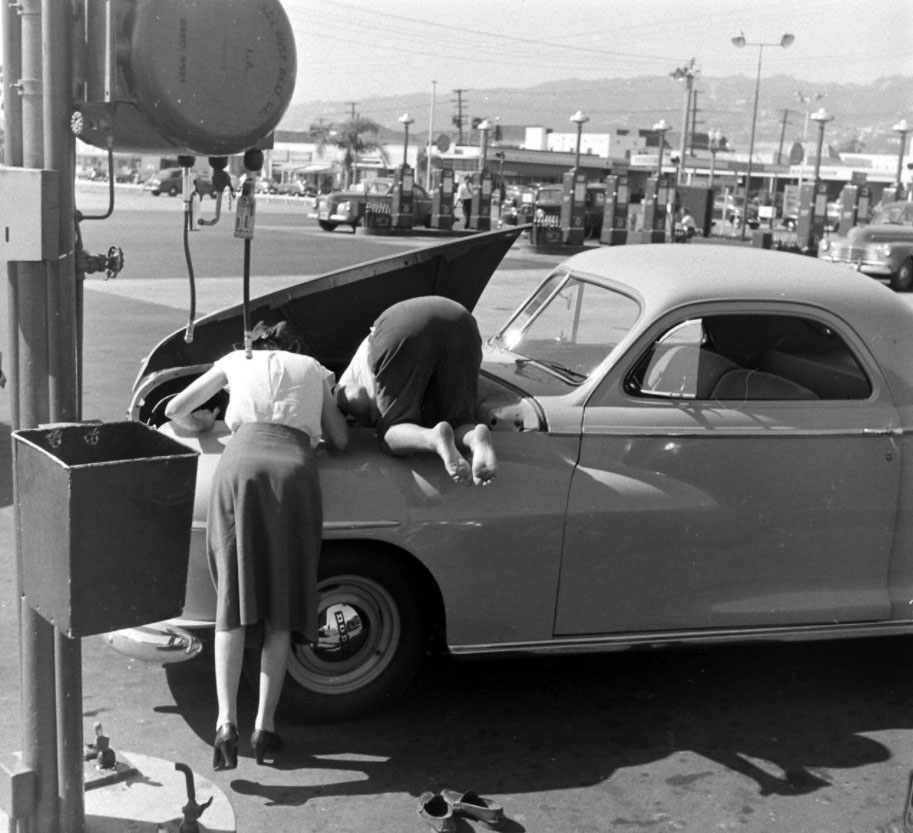 |
|
| (1948)* – “I think I found the problem!” - Gilmore Self-Service Gas Station. Photo Credit: Life Magazine |
Historical Notes This whimsical moment, captured by Life magazine in 1948, reflects the everyday ease and appeal of Gilmore’s self-serve model. Humorously captioned “I think I found the problem,” the image depicts a customer engaging with her own vehicle—underscoring the do-it-yourself ethos the station encouraged. The Gilmore Gas-a-teria at Beverly and Genesee was not only one of the earliest self-service stations in the U.S., but also a place that embraced speed, independence, and even a little fun. The model would influence gas station design and customer habits for generations to come. |
* * * * * |
Mobil Gas Station (Fairfax and Olympic)
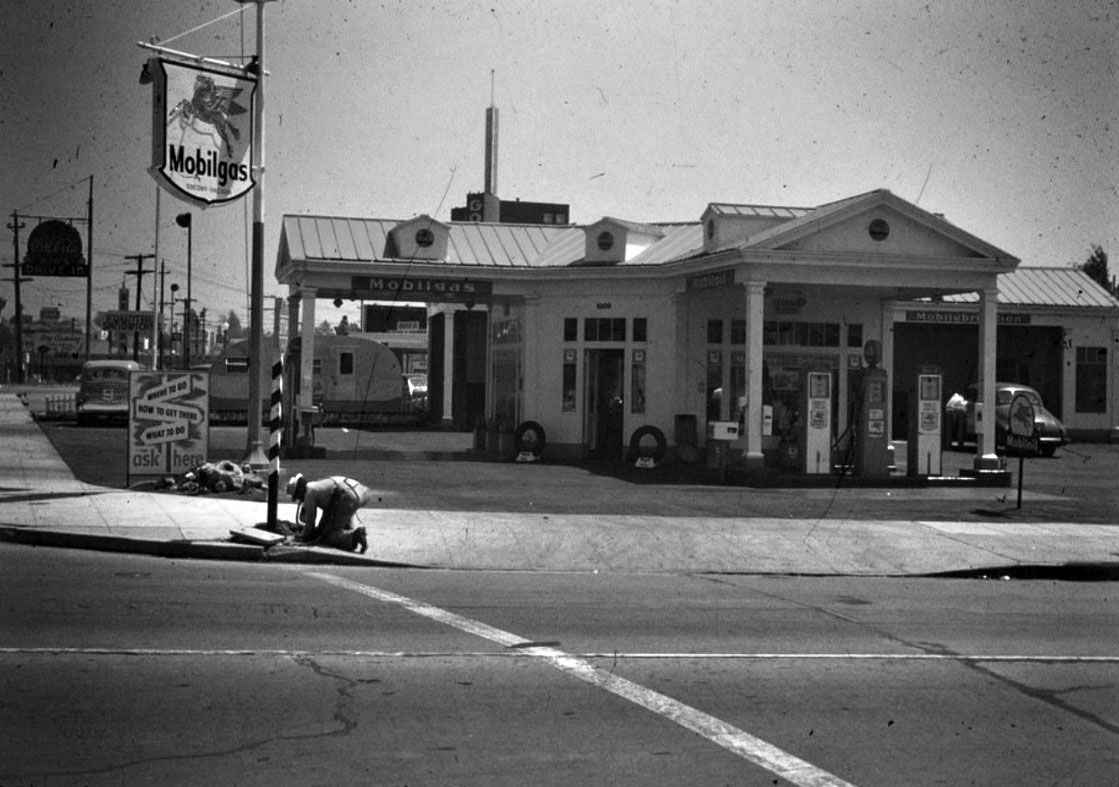 |
|
| (1948)* – View showing a Mobil Gas Station located on the southeast corner of Fairfax Ave and Olympic Blvd. |
Historical Notes Following the break-up of Standard Oil in 1911, the Standard Oil Company of New York, or Socony, was founded, along with 33 other successor companies. In 1920, the company registered the name "Mobiloil" as a trademark. In 1955, Socony-Vacuum was renamed Socony Mobil Oil Company. In 1963, it changed its trade name from "Mobiloil" to simply "Mobil", introducing a new logo. To celebrate its 100th anniversary in 1966, "Socony" was dropped from the corporate name. |
* * * * * |
Richfield Gas Station (Arcadia)
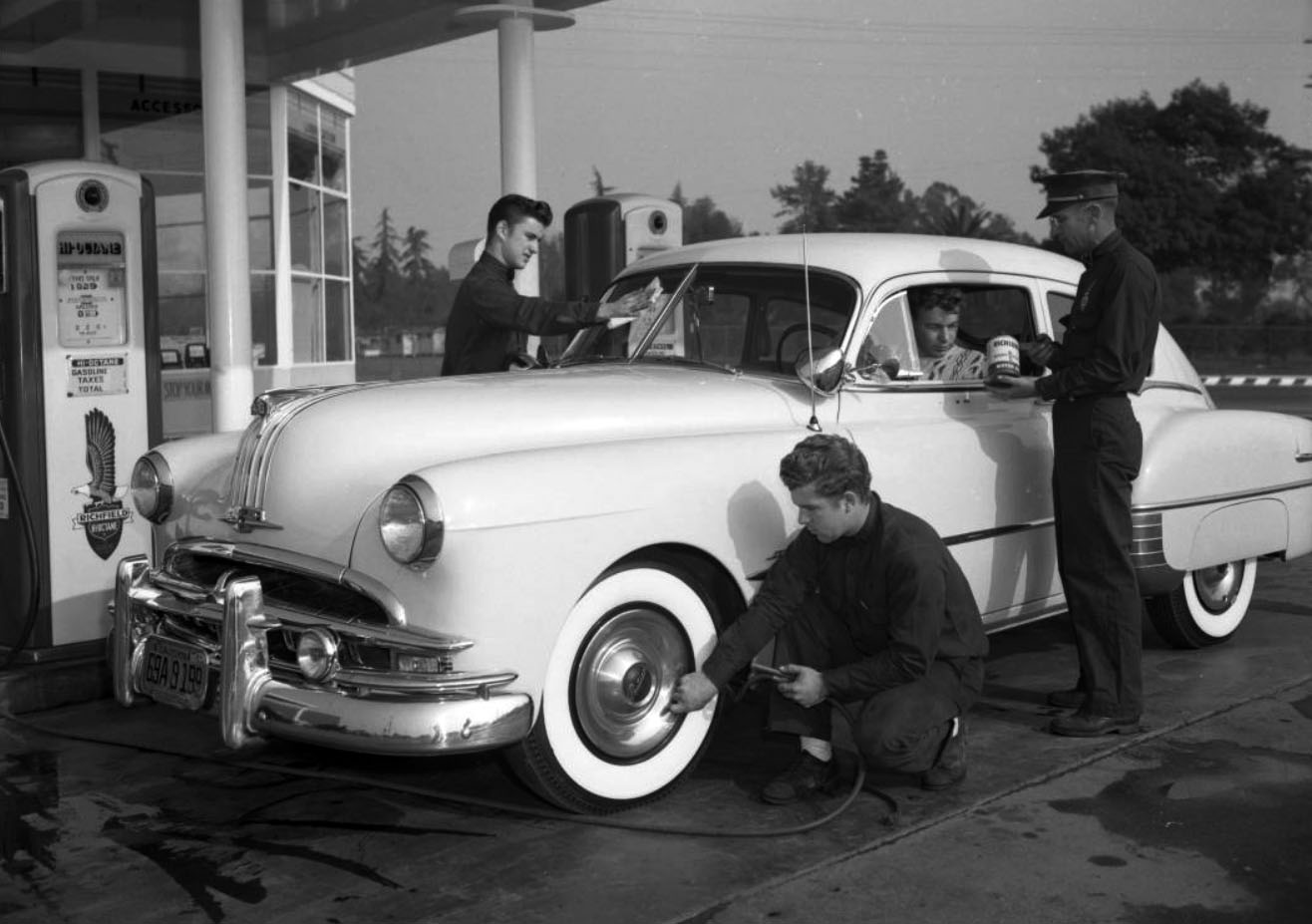 |
|
| (1950)* – Three attendants provide full service at a Richfield Gas Station located at 50 W. Las Tunas in Arcadia, Los Angeles County. Seen here is a 1951 Pontiac Chieftain Coupe. Photo Date: 12/27/50 |
* * * * * |
Signal Gas Station (Wilshire and McCadden)
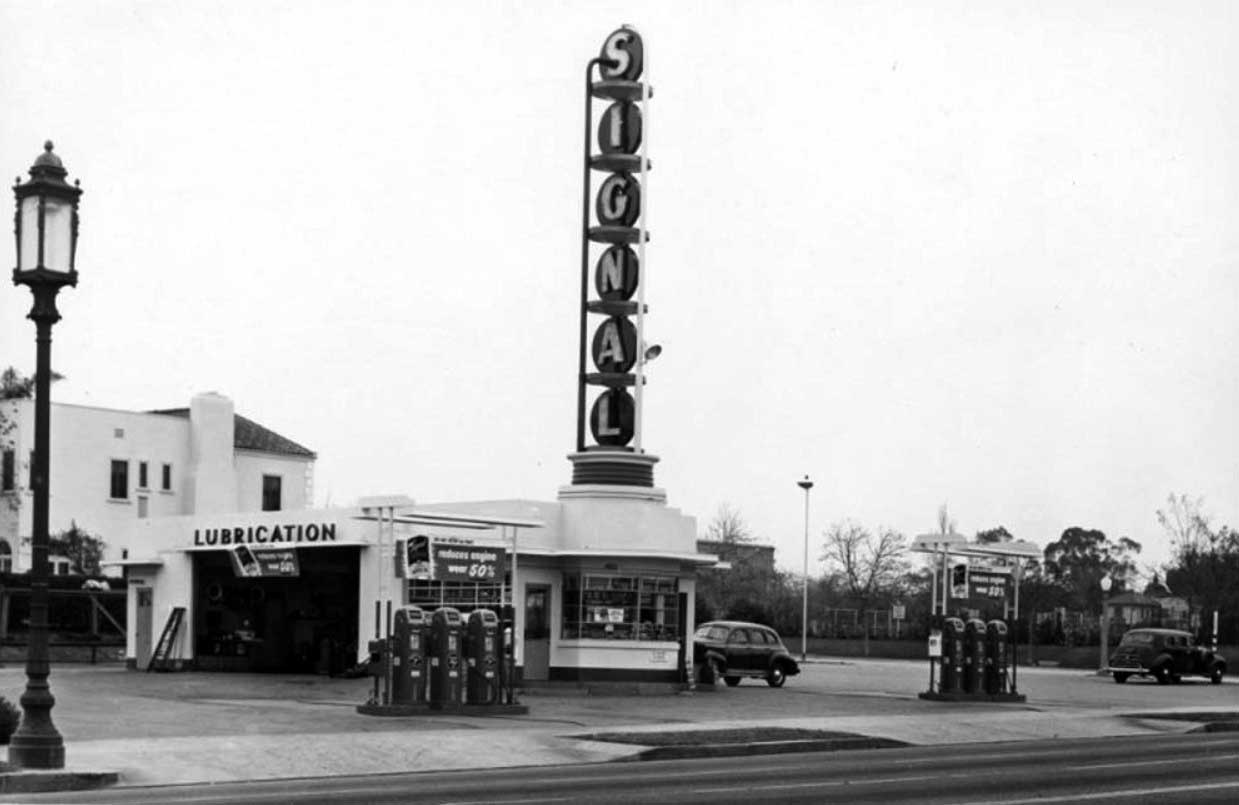 |
|
| (1951)* - A Signal Service Station at 4901 Wilshire Boulevard, NW corner of Wilshire and McCadden Pl. |
Historical Notes Signal Gasoline Company was founded by Samuel B. Mosher in 1922. It renamed itself to Signal Gas & Oil in 1928 to reflect its expanding businesses; by the 1950s, Signal was the largest independent oil company on the West Coast of the United States and Mosher held large stakes in American President Lines and Flying Tiger Line. In 1964, Signal merged with the Garrett Corporation, an aerospace company, and the combined company adopted "The Signal Companies" as its corporate name in 1968.*^^ |
* * * * * |
Wilco Gas
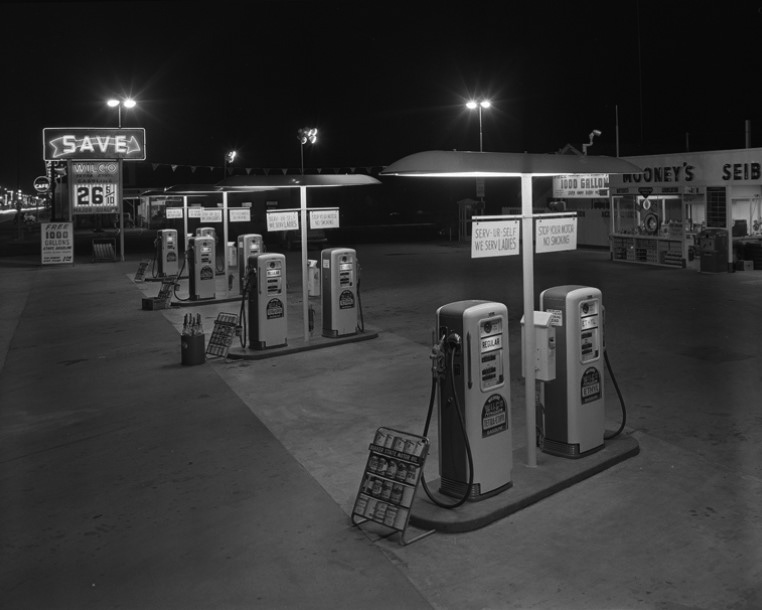 |
|
| (1954)#* – View showing the Wilco Gas and Sieberling Tire Store with gas at 26¢ per gallon. Photo by Joseph Fadler (SCE). |
* * * * * |
1979 Oil Crisis
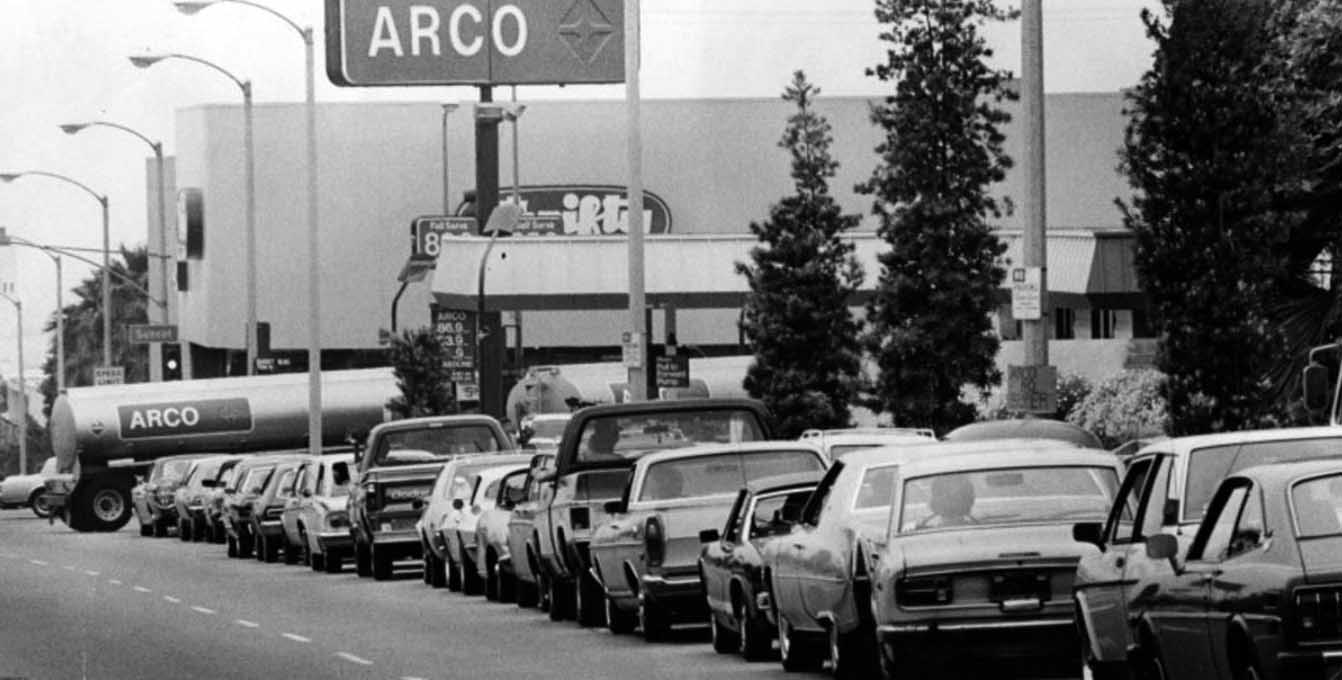 |
|
| (1979)* – Lines form at the ARCO gas station on the NW corner of Sunset and Fairfax during the 1979 Oil Embargo. Photo caption reads: "The only vehicle with enough clout to risk it - the gasoline tanker - cuts through a queue of cars at station on Sunset Boulevard and Fairfax Avenue." |
Historical Notes The 1979 Oil Crisis was an energy crisis characterized by a precipitous drop in oil production for the second time in the 1970s (the first being in 1973). In the wake of the Iranian Revolution, 37,000 Iranian oil refinery employees went on strike in 1978, causing Iran's oil refineries to go from producing 6 million barrels per day to 1.5 million barrels per day. The global oil supply decreased by 7 percent, causing a surge in oil pricing and within 12 months oil markets had doubled to $39.50 per barrel. This surge caused major gas shortages, long gas lines, and panic buying. In the United States, the Jimmy Carter administration began a phased deregulation of oil prices on April 5, 1979, which allowed U.S. oil output to rise sharply from the Prudhoe Bay fields in Alaska, while oil imports fell sharply. It wasn't until the mid-1980s that oil prices returned to pre-crisis levels. |
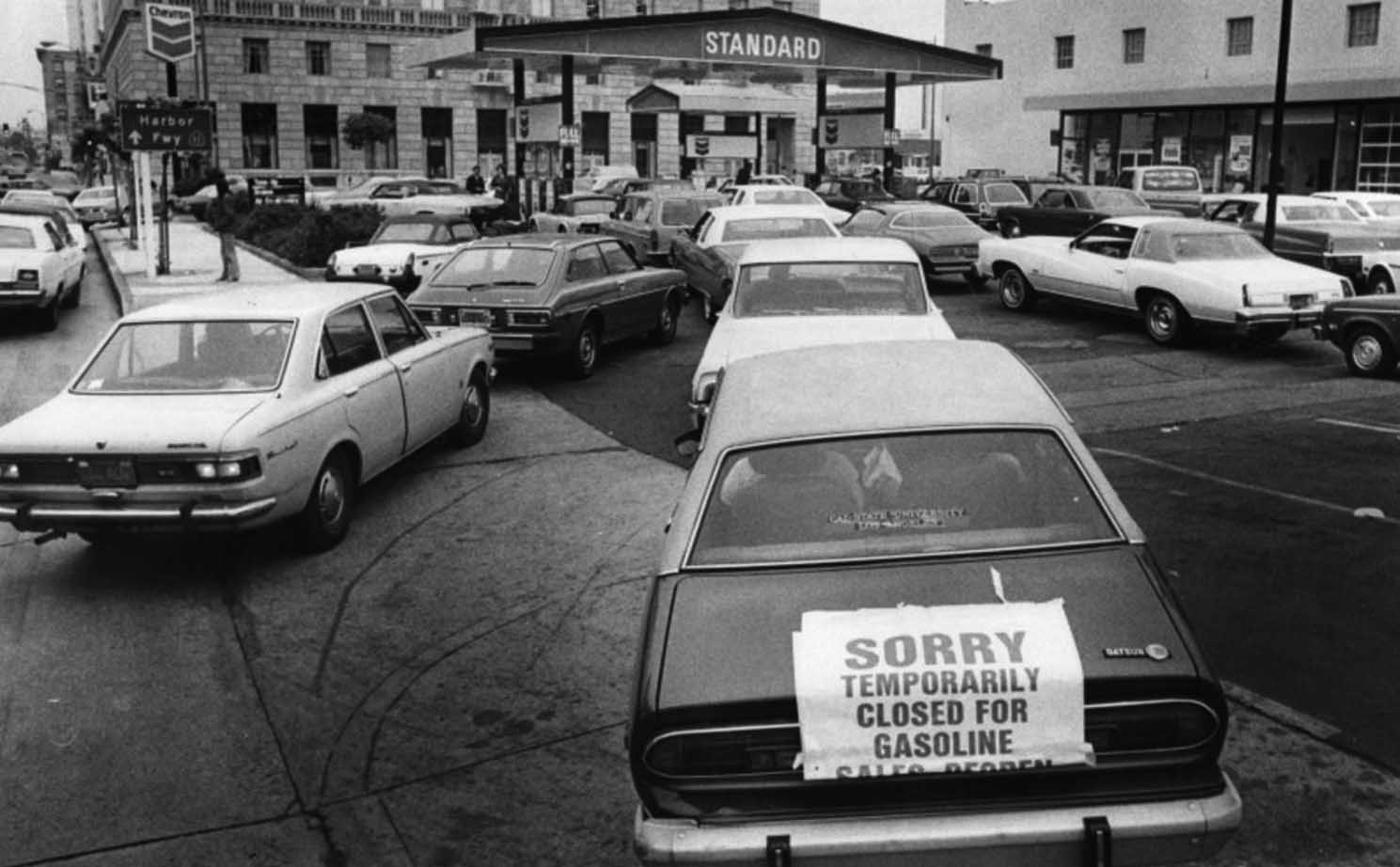 |
|
| (1979)* – Photo caption reads: "Last car in line at Olympic and Hope gas station has sign giving bad news to other gas-hunters. Sign was placed by station attendant." Suppliers barely met demand as drivers lined up at pumps. |
Historical Notes The Standard Oil station pictured in the photograph was later replaced by the Renaissance Tower Apartments. |
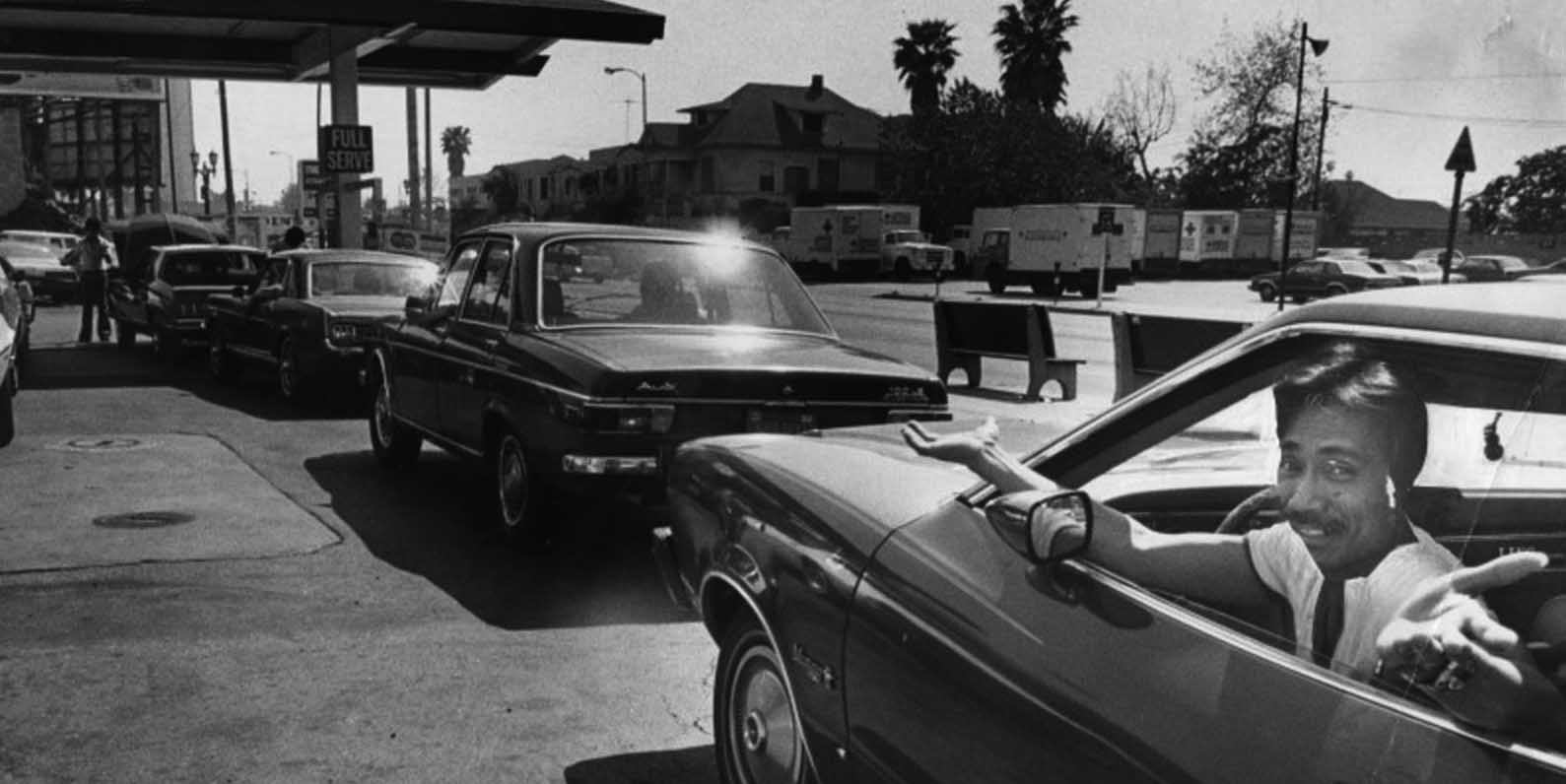 |
|
| (1979)* – Photo caption reads: "L.A. resident Pil Des Jesus was one of many Southland motorists waiting in long lines to fill up the gas tank for the holiday weekend." The photo was taken at a 76 Station at Vermont Avenue and Olympic Boulevard. De Jesus poses with his arms spread out from the driver side window of his Mustang, while an Audi 100 LS also awaits service ahead of him. |
Historical Notes There was the “odd-even rationing” (only people with an odd-numbered license plate could purchase gas on an odd-numbered day), as was used during the 1973 Oil Crisis. Several states implemented odd-even gas rationing, including California, Pennsylvania, New York, New Jersey, Oregon, and Texas. Coupons for gasoline rationing were printed but were never actually used during the 1979 crisis.* |
* * * * * |
More Historical Early Views
Newest Additions
Early LA Buildings and City Views
History of Water and Electricity in Los Angeles
* * * * * |
References and Credits
^ LA Public Library Image Archive
*^ Oviatt Library Digital Archives
^* History of the Gas Station: woip.blogspot.com
#* Huntington Digital Library Archive
+# Flickr.com: Michael Ryerson
** LA Magazine: Jack Colker's 76 Station
++# Facebook.com: Photos of Los Angeles
#** Real Buildings that Inspired Disney-MGM Studios
^^#LA Curbed
#^# Pyroil - The Wonder Gas: theoldmotor.com
#^^Facebook.com: Classic Hollywood/Los Angeles/SFV
+#+Facebook.com: Garden of Allah Novels
^x^Facebook.com: Photos of Los Angeles
*x^Facebook.com: Beverly Hills Heritage
^x*Facebook.com: So. Calif. Historic Arrchitecture
^v^My Love of Old Hollywood - A Quick Tour of Beverly Hills
^*^ Gilmore Gasoline Filing Station
**^ Noirish Los Angeles - forum.skyscraperpage.com; Bob's Airmail Service Station; Anandale-Rockdale Station; Muller Bros. Service Station; Howe's Service Station; Jack Cocker 76 Station
*^^ Wikipedia
^^^ Los Angeles Conservancy: Union 76 Station
^^* The Old Motor
**^*California State Library Image Archive
****Pinterest.com: Gilmore Self-Service Gas Station
***^Pomona Public Library Digital Archive: Bob's Airmail Service Station
***#Pinterest: Art Deco - Sears Building; Standard Station
*^^*Pinterest.com: Bertrand Lacheze
*^#^Huntington Digital Library Archive
^*^#Facebook.com - Bizarre Los Angeles
#^*^Facebook.com: West San Fernando Valley Then And Now
##++Facebook.com - Beverly Hills Heritage
< Back
Menu
- Home
- Mission
- Museum
- Major Efforts
- Recent Newsletters
- Historical Op Ed Pieces
- Board Officers and Directors
- Mulholland/McCarthy Service Awards
- Positions on Owens Valley and the City of Los Angeles Issues
- Legislative Positions on
Water Issues
- Legislative Positions on
Energy Issues
- Membership
- Contact Us
- Search Index